Play and Development Assessment Workbook for CHC50113 Diploma in Early Childhood Education & Care
VerifiedAdded on 2023/06/12
|77
|15130
|107
AI Summary
This assessment workbook covers four units of competency for CHC50113 Diploma in Early Childhood Education & Care. It includes instructions, competency-based assessment system, principles of assessing nationally recognised training, dimensions of competency, and unit of competency.
Contribute Materials
Your contribution can guide someone’s learning journey. Share your
documents today.
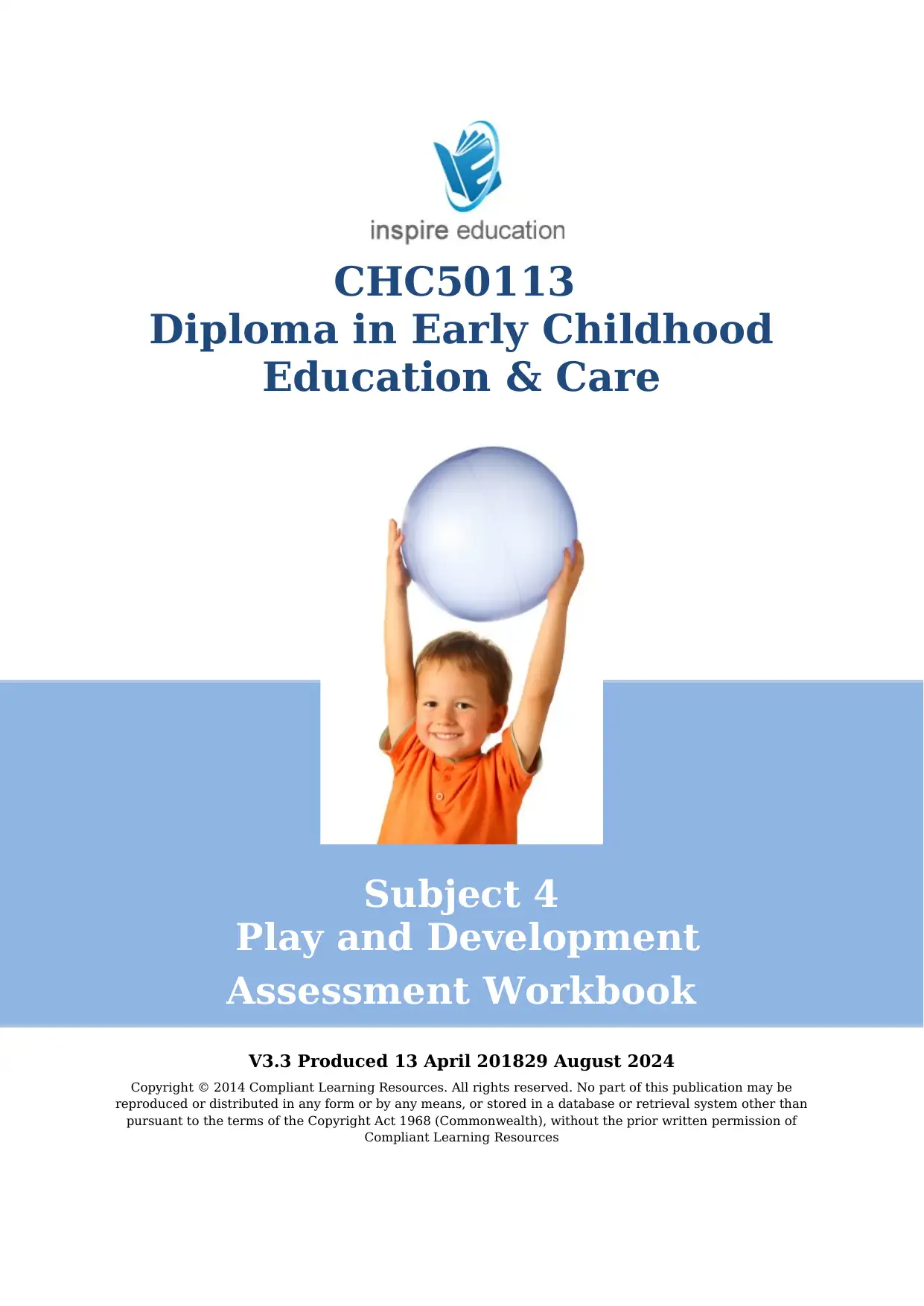
CHC50113
Diploma in Early Childhood
Education & Care
Subject 4
Play and Development
Assessment Workbook
V3.3 Produced 13 April 201829 August 2024
Copyright © 2014 Compliant Learning Resources. All rights reserved. No part of this publication may be
reproduced or distributed in any form or by any means, or stored in a database or retrieval system other than
pursuant to the terms of the Copyright Act 1968 (Commonwealth), without the prior written permission of
Compliant Learning Resources
Diploma in Early Childhood
Education & Care
Subject 4
Play and Development
Assessment Workbook
V3.3 Produced 13 April 201829 August 2024
Copyright © 2014 Compliant Learning Resources. All rights reserved. No part of this publication may be
reproduced or distributed in any form or by any means, or stored in a database or retrieval system other than
pursuant to the terms of the Copyright Act 1968 (Commonwealth), without the prior written permission of
Compliant Learning Resources
Secure Best Marks with AI Grader
Need help grading? Try our AI Grader for instant feedback on your assignments.
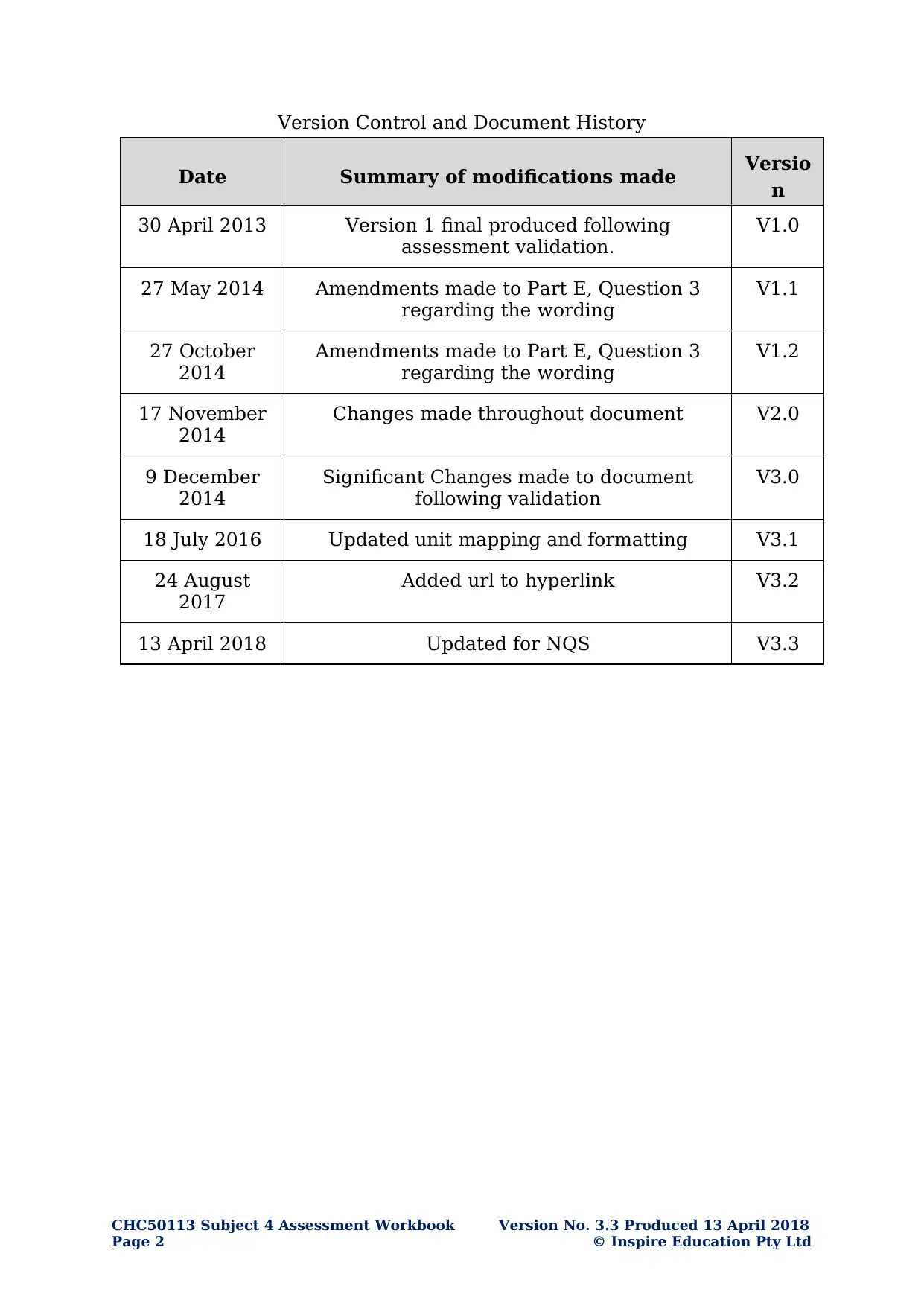
Version Control and Document History
Date Summary of modifications made Versio
n
30 April 2013 Version 1 final produced following
assessment validation.
V1.0
27 May 2014 Amendments made to Part E, Question 3
regarding the wording
V1.1
27 October
2014
Amendments made to Part E, Question 3
regarding the wording
V1.2
17 November
2014
Changes made throughout document V2.0
9 December
2014
Significant Changes made to document
following validation
V3.0
18 July 2016 Updated unit mapping and formatting V3.1
24 August
2017
Added url to hyperlink V3.2
13 April 2018 Updated for NQS V3.3
CHC50113 Subject 4 Assessment Workbook Version No. 3.3 Produced 13 April 2018
Page 2 © Inspire Education Pty Ltd
Date Summary of modifications made Versio
n
30 April 2013 Version 1 final produced following
assessment validation.
V1.0
27 May 2014 Amendments made to Part E, Question 3
regarding the wording
V1.1
27 October
2014
Amendments made to Part E, Question 3
regarding the wording
V1.2
17 November
2014
Changes made throughout document V2.0
9 December
2014
Significant Changes made to document
following validation
V3.0
18 July 2016 Updated unit mapping and formatting V3.1
24 August
2017
Added url to hyperlink V3.2
13 April 2018 Updated for NQS V3.3
CHC50113 Subject 4 Assessment Workbook Version No. 3.3 Produced 13 April 2018
Page 2 © Inspire Education Pty Ltd

TABLE OF CONTENTS
This is an interactive table of contents. If you are viewing this document
in Acrobat, clicking on a heading will transfer you to that page. If you
have this document open in Word, you will need to hold down the Control
key while clicking for this to work.
TABLE OF CONTENTS...........................................................................3
INSTRUCTIONS....................................................................................4
WHAT IS COMPETENCY BASED ASSESSMENT...........................................4
THE BASIC PRINCIPLES OF ASSESSING NATIONALLY RECOGNISED TRAINING5
The principles of assessment....................................................................................5
THE DIMENSIONS OF COMPETENCY........................................................6
THE UNIT OF COMPETENCY...................................................................7
CHCECE010 Support the holistic development of children in early childhood 7
CHCECE013 Use information about children to inform practice........................8
CHCECE006 Support behaviour of children and young people.........................10
CHCECE007 Develop positive and respectful relationships with children......11
ASSESSMENT REQUIREMENTS.............................................................13
REASONABLE ADJUSTMENT................................................................13
ASSESSMENT METHODS.....................................................................14
PRESENTATION.................................................................................15
ASSESSMENT WORKBOOK COVERSHEET...............................................16
KNOWLEDGE ASSESSMENT.................................................................17
Part A – Holistic Development.....................................................................................17
Part B – Support Play and Learning............................................................................29
Part C – Use Information about CHildren....................................................................31
Part D – Respectful and Positive with children............................................................34
Part E – Support Behaviour.........................................................................................38
CASE STUDY A – HOLISTIC DEVELOPMENT...........................................46
CASE STUDY B - DEVELOP POSITIVE AND RESPECTFUL RELATIONSHIPS
WITH CHILDREN................................................................................49
CASE STUDY C – UNDERSTANDING CHILDREN BEHAVIOUR....................53
PROJECT – OBSERVING, GATHERING AND ANALYSING INFORMATION.......60
WORKBOOK CHECKLIST.....................................................................68
FEEDBACK........................................................................................ 69
CHC50113 Subject 4 Assessment Workbook Version No. 3.3 Produced 13 April 2018
© Inspire Education Pty Ltd Page 3
This is an interactive table of contents. If you are viewing this document
in Acrobat, clicking on a heading will transfer you to that page. If you
have this document open in Word, you will need to hold down the Control
key while clicking for this to work.
TABLE OF CONTENTS...........................................................................3
INSTRUCTIONS....................................................................................4
WHAT IS COMPETENCY BASED ASSESSMENT...........................................4
THE BASIC PRINCIPLES OF ASSESSING NATIONALLY RECOGNISED TRAINING5
The principles of assessment....................................................................................5
THE DIMENSIONS OF COMPETENCY........................................................6
THE UNIT OF COMPETENCY...................................................................7
CHCECE010 Support the holistic development of children in early childhood 7
CHCECE013 Use information about children to inform practice........................8
CHCECE006 Support behaviour of children and young people.........................10
CHCECE007 Develop positive and respectful relationships with children......11
ASSESSMENT REQUIREMENTS.............................................................13
REASONABLE ADJUSTMENT................................................................13
ASSESSMENT METHODS.....................................................................14
PRESENTATION.................................................................................15
ASSESSMENT WORKBOOK COVERSHEET...............................................16
KNOWLEDGE ASSESSMENT.................................................................17
Part A – Holistic Development.....................................................................................17
Part B – Support Play and Learning............................................................................29
Part C – Use Information about CHildren....................................................................31
Part D – Respectful and Positive with children............................................................34
Part E – Support Behaviour.........................................................................................38
CASE STUDY A – HOLISTIC DEVELOPMENT...........................................46
CASE STUDY B - DEVELOP POSITIVE AND RESPECTFUL RELATIONSHIPS
WITH CHILDREN................................................................................49
CASE STUDY C – UNDERSTANDING CHILDREN BEHAVIOUR....................53
PROJECT – OBSERVING, GATHERING AND ANALYSING INFORMATION.......60
WORKBOOK CHECKLIST.....................................................................68
FEEDBACK........................................................................................ 69
CHC50113 Subject 4 Assessment Workbook Version No. 3.3 Produced 13 April 2018
© Inspire Education Pty Ltd Page 3
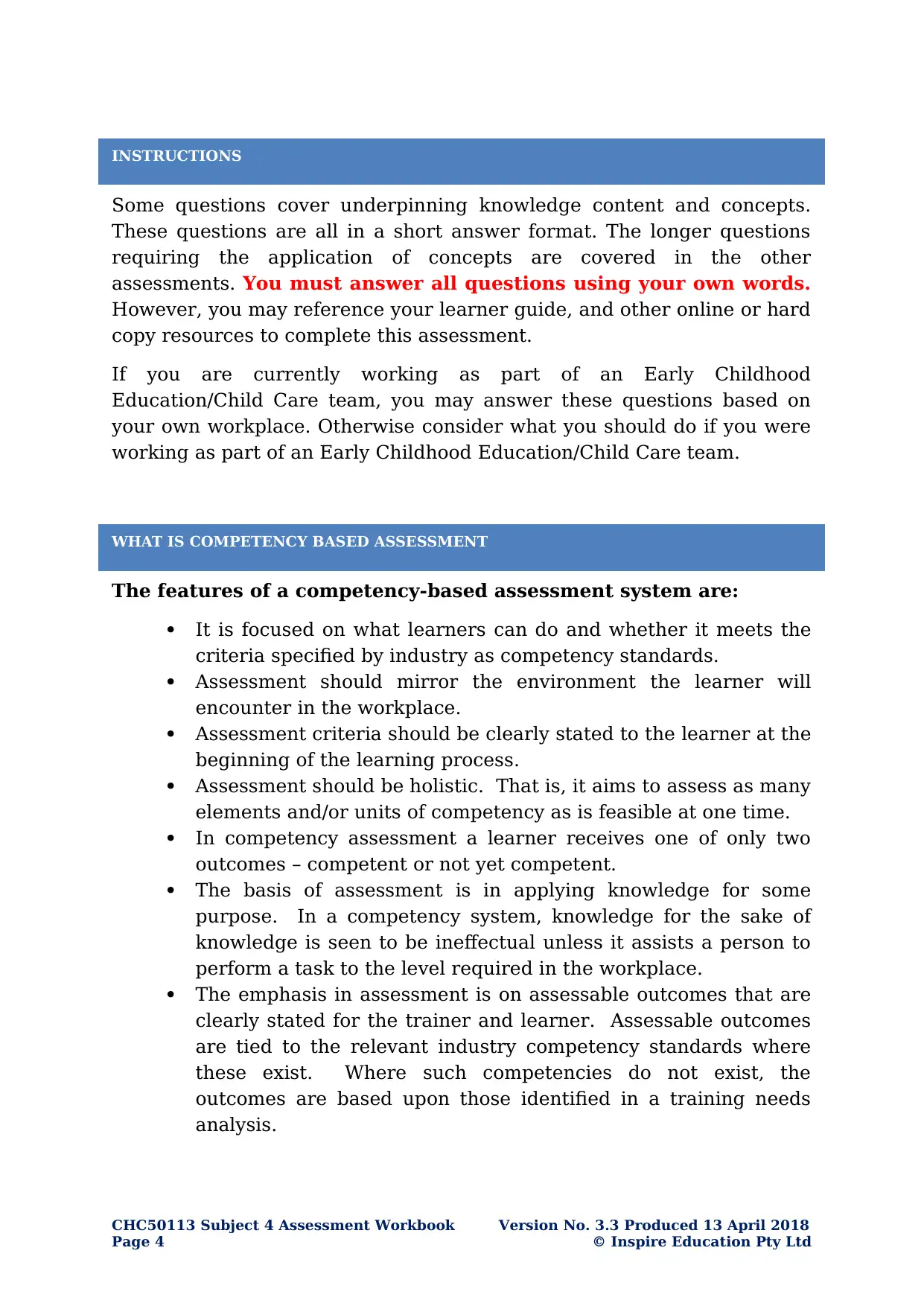
INSTRUCTIONS
Some questions cover underpinning knowledge content and concepts.
These questions are all in a short answer format. The longer questions
requiring the application of concepts are covered in the other
assessments. You must answer all questions using your own words.
However, you may reference your learner guide, and other online or hard
copy resources to complete this assessment.
If you are currently working as part of an Early Childhood
Education/Child Care team, you may answer these questions based on
your own workplace. Otherwise consider what you should do if you were
working as part of an Early Childhood Education/Child Care team.
WHAT IS COMPETENCY BASED ASSESSMENT
The features of a competency-based assessment system are:
It is focused on what learners can do and whether it meets the
criteria specified by industry as competency standards.
Assessment should mirror the environment the learner will
encounter in the workplace.
Assessment criteria should be clearly stated to the learner at the
beginning of the learning process.
Assessment should be holistic. That is, it aims to assess as many
elements and/or units of competency as is feasible at one time.
In competency assessment a learner receives one of only two
outcomes – competent or not yet competent.
The basis of assessment is in applying knowledge for some
purpose. In a competency system, knowledge for the sake of
knowledge is seen to be ineffectual unless it assists a person to
perform a task to the level required in the workplace.
The emphasis in assessment is on assessable outcomes that are
clearly stated for the trainer and learner. Assessable outcomes
are tied to the relevant industry competency standards where
these exist. Where such competencies do not exist, the
outcomes are based upon those identified in a training needs
analysis.
CHC50113 Subject 4 Assessment Workbook Version No. 3.3 Produced 13 April 2018
Page 4 © Inspire Education Pty Ltd
Some questions cover underpinning knowledge content and concepts.
These questions are all in a short answer format. The longer questions
requiring the application of concepts are covered in the other
assessments. You must answer all questions using your own words.
However, you may reference your learner guide, and other online or hard
copy resources to complete this assessment.
If you are currently working as part of an Early Childhood
Education/Child Care team, you may answer these questions based on
your own workplace. Otherwise consider what you should do if you were
working as part of an Early Childhood Education/Child Care team.
WHAT IS COMPETENCY BASED ASSESSMENT
The features of a competency-based assessment system are:
It is focused on what learners can do and whether it meets the
criteria specified by industry as competency standards.
Assessment should mirror the environment the learner will
encounter in the workplace.
Assessment criteria should be clearly stated to the learner at the
beginning of the learning process.
Assessment should be holistic. That is, it aims to assess as many
elements and/or units of competency as is feasible at one time.
In competency assessment a learner receives one of only two
outcomes – competent or not yet competent.
The basis of assessment is in applying knowledge for some
purpose. In a competency system, knowledge for the sake of
knowledge is seen to be ineffectual unless it assists a person to
perform a task to the level required in the workplace.
The emphasis in assessment is on assessable outcomes that are
clearly stated for the trainer and learner. Assessable outcomes
are tied to the relevant industry competency standards where
these exist. Where such competencies do not exist, the
outcomes are based upon those identified in a training needs
analysis.
CHC50113 Subject 4 Assessment Workbook Version No. 3.3 Produced 13 April 2018
Page 4 © Inspire Education Pty Ltd
Secure Best Marks with AI Grader
Need help grading? Try our AI Grader for instant feedback on your assignments.
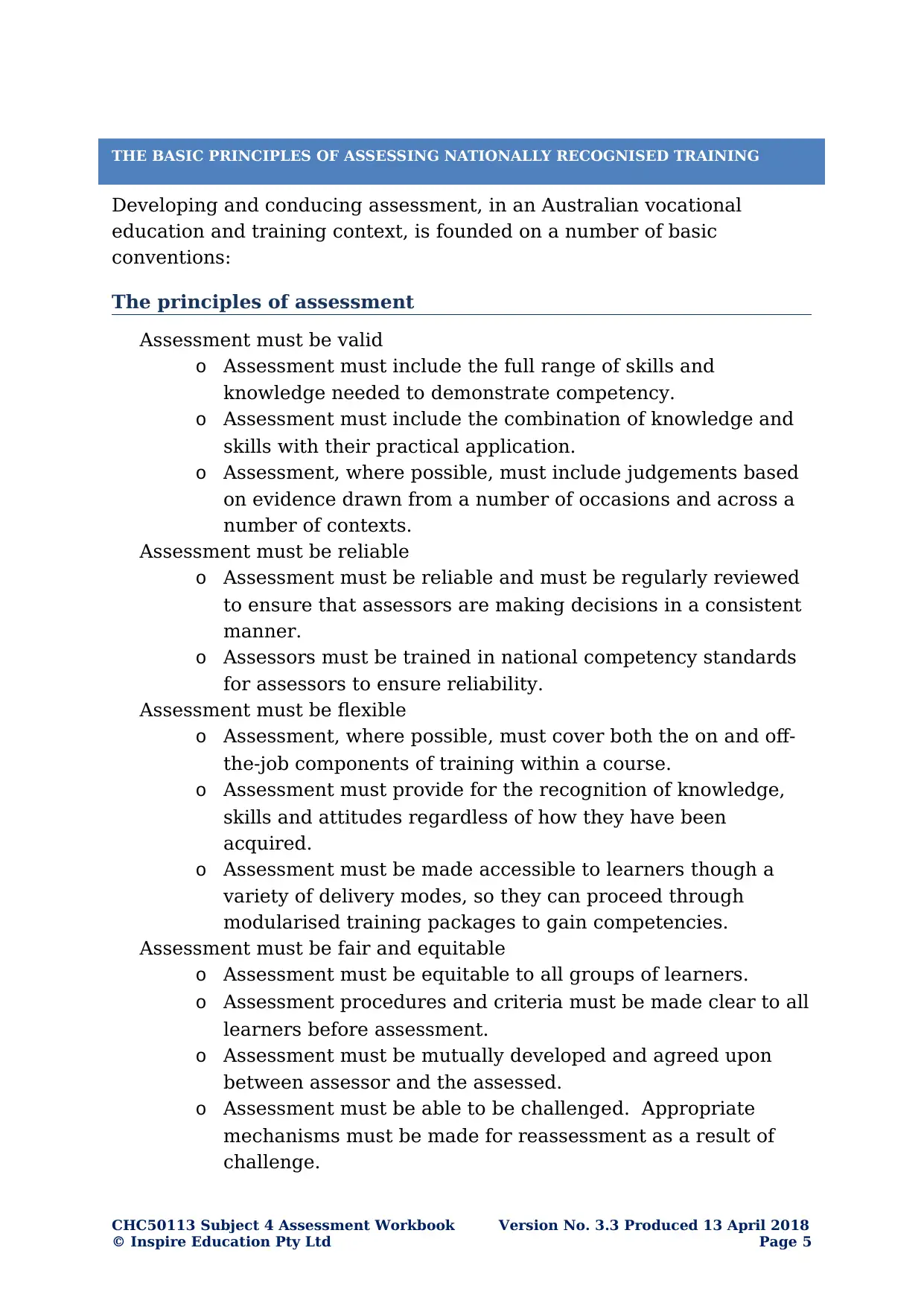
THE BASIC PRINCIPLES OF ASSESSING NATIONALLY RECOGNISED TRAINING
Developing and conducing assessment, in an Australian vocational
education and training context, is founded on a number of basic
conventions:
The principles of assessment
Assessment must be valid
o Assessment must include the full range of skills and
knowledge needed to demonstrate competency.
o Assessment must include the combination of knowledge and
skills with their practical application.
o Assessment, where possible, must include judgements based
on evidence drawn from a number of occasions and across a
number of contexts.
Assessment must be reliable
o Assessment must be reliable and must be regularly reviewed
to ensure that assessors are making decisions in a consistent
manner.
o Assessors must be trained in national competency standards
for assessors to ensure reliability.
Assessment must be flexible
o Assessment, where possible, must cover both the on and off-
the-job components of training within a course.
o Assessment must provide for the recognition of knowledge,
skills and attitudes regardless of how they have been
acquired.
o Assessment must be made accessible to learners though a
variety of delivery modes, so they can proceed through
modularised training packages to gain competencies.
Assessment must be fair and equitable
o Assessment must be equitable to all groups of learners.
o Assessment procedures and criteria must be made clear to all
learners before assessment.
o Assessment must be mutually developed and agreed upon
between assessor and the assessed.
o Assessment must be able to be challenged. Appropriate
mechanisms must be made for reassessment as a result of
challenge.
CHC50113 Subject 4 Assessment Workbook Version No. 3.3 Produced 13 April 2018
© Inspire Education Pty Ltd Page 5
Developing and conducing assessment, in an Australian vocational
education and training context, is founded on a number of basic
conventions:
The principles of assessment
Assessment must be valid
o Assessment must include the full range of skills and
knowledge needed to demonstrate competency.
o Assessment must include the combination of knowledge and
skills with their practical application.
o Assessment, where possible, must include judgements based
on evidence drawn from a number of occasions and across a
number of contexts.
Assessment must be reliable
o Assessment must be reliable and must be regularly reviewed
to ensure that assessors are making decisions in a consistent
manner.
o Assessors must be trained in national competency standards
for assessors to ensure reliability.
Assessment must be flexible
o Assessment, where possible, must cover both the on and off-
the-job components of training within a course.
o Assessment must provide for the recognition of knowledge,
skills and attitudes regardless of how they have been
acquired.
o Assessment must be made accessible to learners though a
variety of delivery modes, so they can proceed through
modularised training packages to gain competencies.
Assessment must be fair and equitable
o Assessment must be equitable to all groups of learners.
o Assessment procedures and criteria must be made clear to all
learners before assessment.
o Assessment must be mutually developed and agreed upon
between assessor and the assessed.
o Assessment must be able to be challenged. Appropriate
mechanisms must be made for reassessment as a result of
challenge.
CHC50113 Subject 4 Assessment Workbook Version No. 3.3 Produced 13 April 2018
© Inspire Education Pty Ltd Page 5
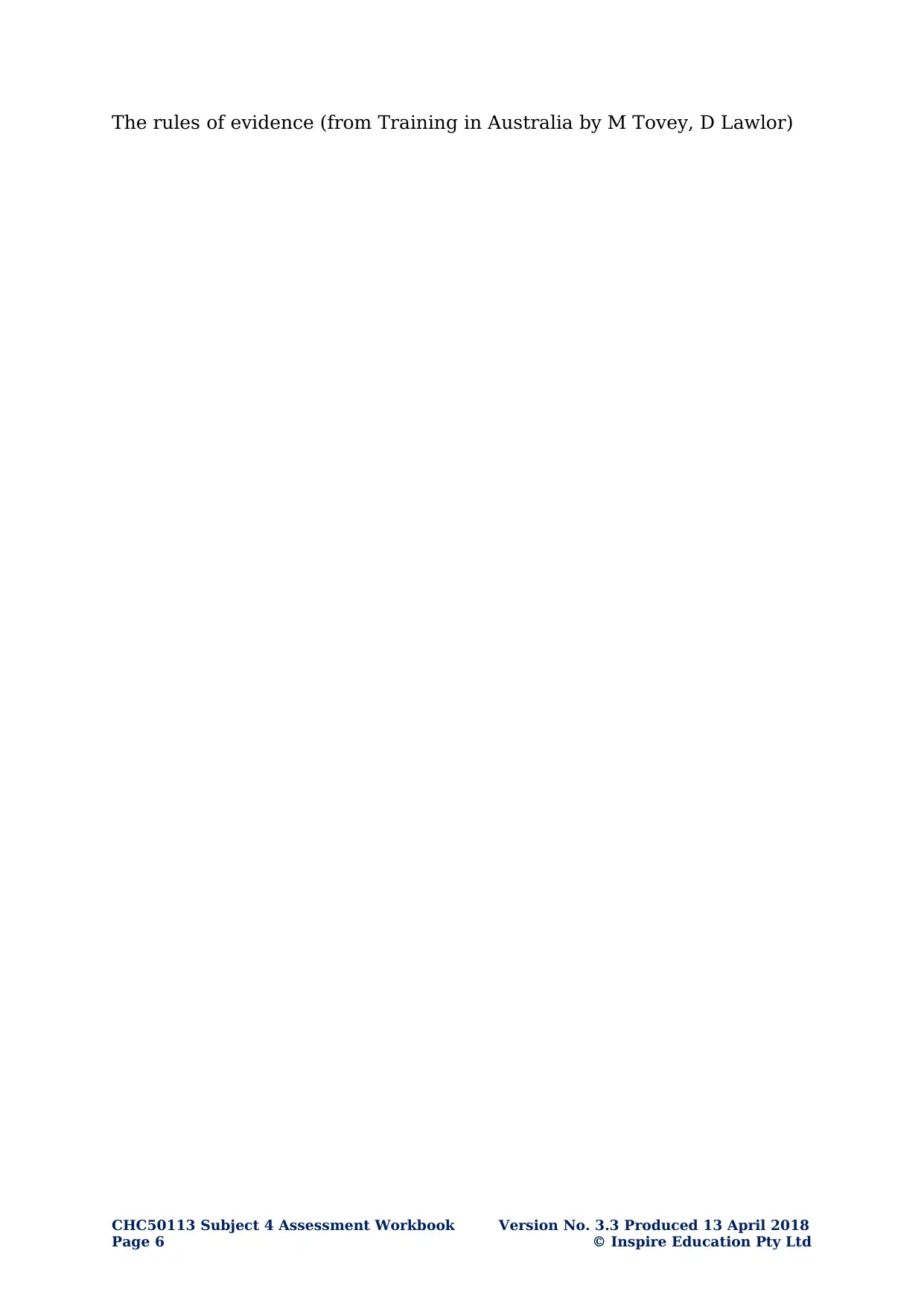
The rules of evidence (from Training in Australia by M Tovey, D Lawlor)
CHC50113 Subject 4 Assessment Workbook Version No. 3.3 Produced 13 April 2018
Page 6 © Inspire Education Pty Ltd
CHC50113 Subject 4 Assessment Workbook Version No. 3.3 Produced 13 April 2018
Page 6 © Inspire Education Pty Ltd
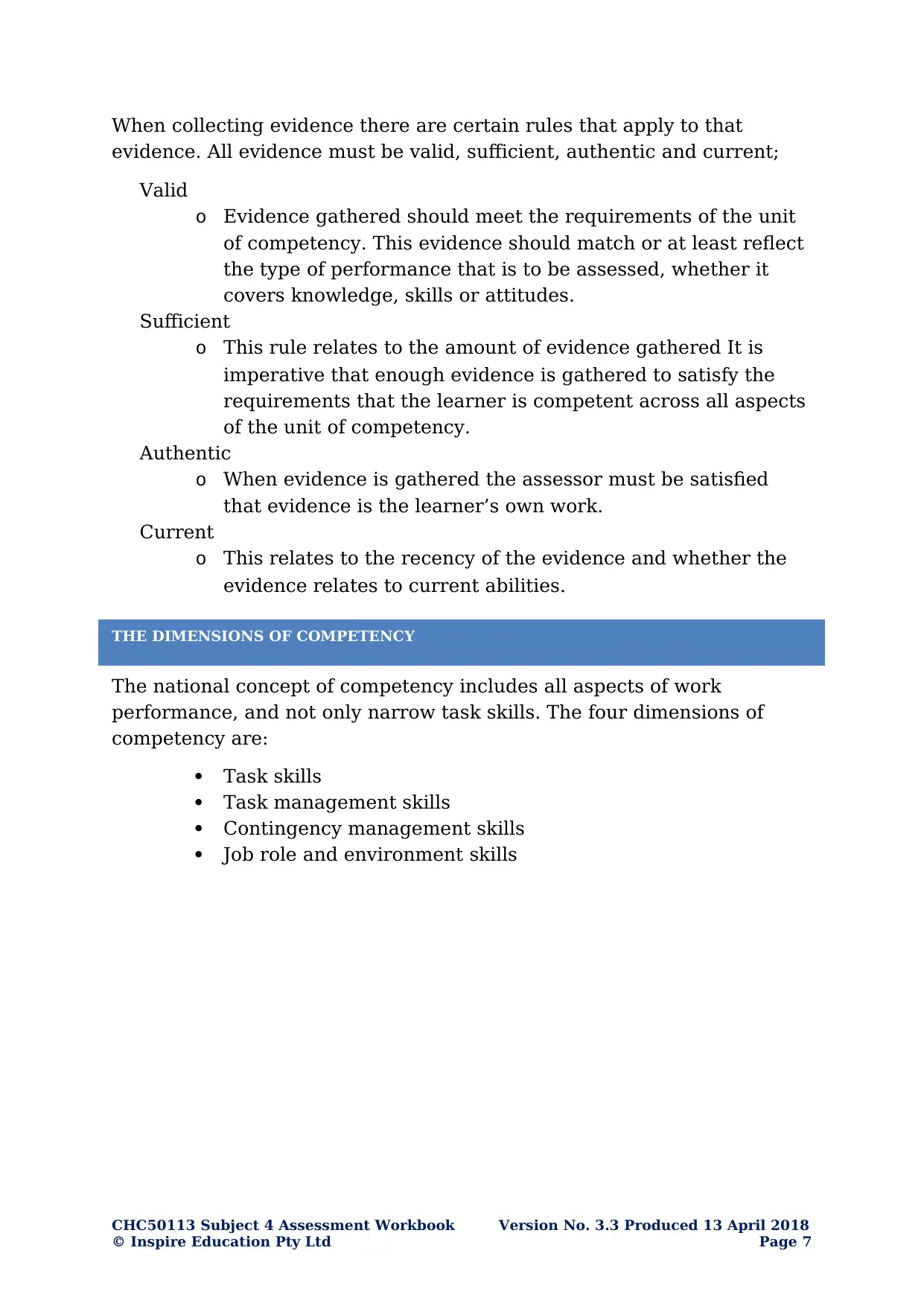
When collecting evidence there are certain rules that apply to that
evidence. All evidence must be valid, sufficient, authentic and current;
Valid
o Evidence gathered should meet the requirements of the unit
of competency. This evidence should match or at least reflect
the type of performance that is to be assessed, whether it
covers knowledge, skills or attitudes.
Sufficient
o This rule relates to the amount of evidence gathered It is
imperative that enough evidence is gathered to satisfy the
requirements that the learner is competent across all aspects
of the unit of competency.
Authentic
o When evidence is gathered the assessor must be satisfied
that evidence is the learner’s own work.
Current
o This relates to the recency of the evidence and whether the
evidence relates to current abilities.
THE DIMENSIONS OF COMPETENCY
The national concept of competency includes all aspects of work
performance, and not only narrow task skills. The four dimensions of
competency are:
Task skills
Task management skills
Contingency management skills
Job role and environment skills
CHC50113 Subject 4 Assessment Workbook Version No. 3.3 Produced 13 April 2018
© Inspire Education Pty Ltd Page 7
evidence. All evidence must be valid, sufficient, authentic and current;
Valid
o Evidence gathered should meet the requirements of the unit
of competency. This evidence should match or at least reflect
the type of performance that is to be assessed, whether it
covers knowledge, skills or attitudes.
Sufficient
o This rule relates to the amount of evidence gathered It is
imperative that enough evidence is gathered to satisfy the
requirements that the learner is competent across all aspects
of the unit of competency.
Authentic
o When evidence is gathered the assessor must be satisfied
that evidence is the learner’s own work.
Current
o This relates to the recency of the evidence and whether the
evidence relates to current abilities.
THE DIMENSIONS OF COMPETENCY
The national concept of competency includes all aspects of work
performance, and not only narrow task skills. The four dimensions of
competency are:
Task skills
Task management skills
Contingency management skills
Job role and environment skills
CHC50113 Subject 4 Assessment Workbook Version No. 3.3 Produced 13 April 2018
© Inspire Education Pty Ltd Page 7
Paraphrase This Document
Need a fresh take? Get an instant paraphrase of this document with our AI Paraphraser
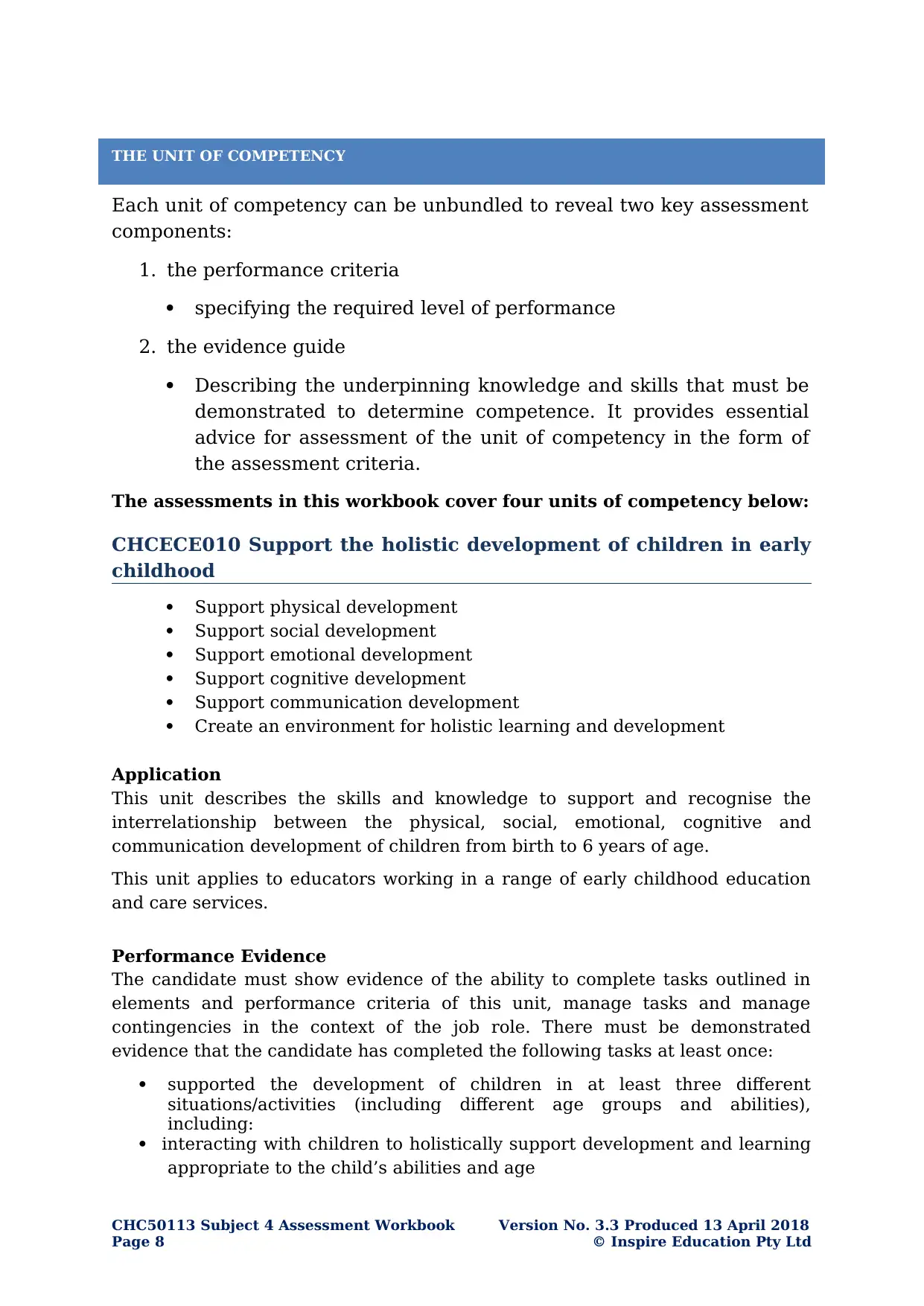
THE UNIT OF COMPETENCY
Each unit of competency can be unbundled to reveal two key assessment
components:
1. the performance criteria
specifying the required level of performance
2. the evidence guide
Describing the underpinning knowledge and skills that must be
demonstrated to determine competence. It provides essential
advice for assessment of the unit of competency in the form of
the assessment criteria.
The assessments in this workbook cover four units of competency below:
CHCECE010 Support the holistic development of children in early
childhood
Support physical development
Support social development
Support emotional development
Support cognitive development
Support communication development
Create an environment for holistic learning and development
Application
This unit describes the skills and knowledge to support and recognise the
interrelationship between the physical, social, emotional, cognitive and
communication development of children from birth to 6 years of age.
This unit applies to educators working in a range of early childhood education
and care services.
Performance Evidence
The candidate must show evidence of the ability to complete tasks outlined in
elements and performance criteria of this unit, manage tasks and manage
contingencies in the context of the job role. There must be demonstrated
evidence that the candidate has completed the following tasks at least once:
supported the development of children in at least three different
situations/activities (including different age groups and abilities),
including:
interacting with children to holistically support development and learning
appropriate to the child’s abilities and age
CHC50113 Subject 4 Assessment Workbook Version No. 3.3 Produced 13 April 2018
Page 8 © Inspire Education Pty Ltd
Each unit of competency can be unbundled to reveal two key assessment
components:
1. the performance criteria
specifying the required level of performance
2. the evidence guide
Describing the underpinning knowledge and skills that must be
demonstrated to determine competence. It provides essential
advice for assessment of the unit of competency in the form of
the assessment criteria.
The assessments in this workbook cover four units of competency below:
CHCECE010 Support the holistic development of children in early
childhood
Support physical development
Support social development
Support emotional development
Support cognitive development
Support communication development
Create an environment for holistic learning and development
Application
This unit describes the skills and knowledge to support and recognise the
interrelationship between the physical, social, emotional, cognitive and
communication development of children from birth to 6 years of age.
This unit applies to educators working in a range of early childhood education
and care services.
Performance Evidence
The candidate must show evidence of the ability to complete tasks outlined in
elements and performance criteria of this unit, manage tasks and manage
contingencies in the context of the job role. There must be demonstrated
evidence that the candidate has completed the following tasks at least once:
supported the development of children in at least three different
situations/activities (including different age groups and abilities),
including:
interacting with children to holistically support development and learning
appropriate to the child’s abilities and age
CHC50113 Subject 4 Assessment Workbook Version No. 3.3 Produced 13 April 2018
Page 8 © Inspire Education Pty Ltd
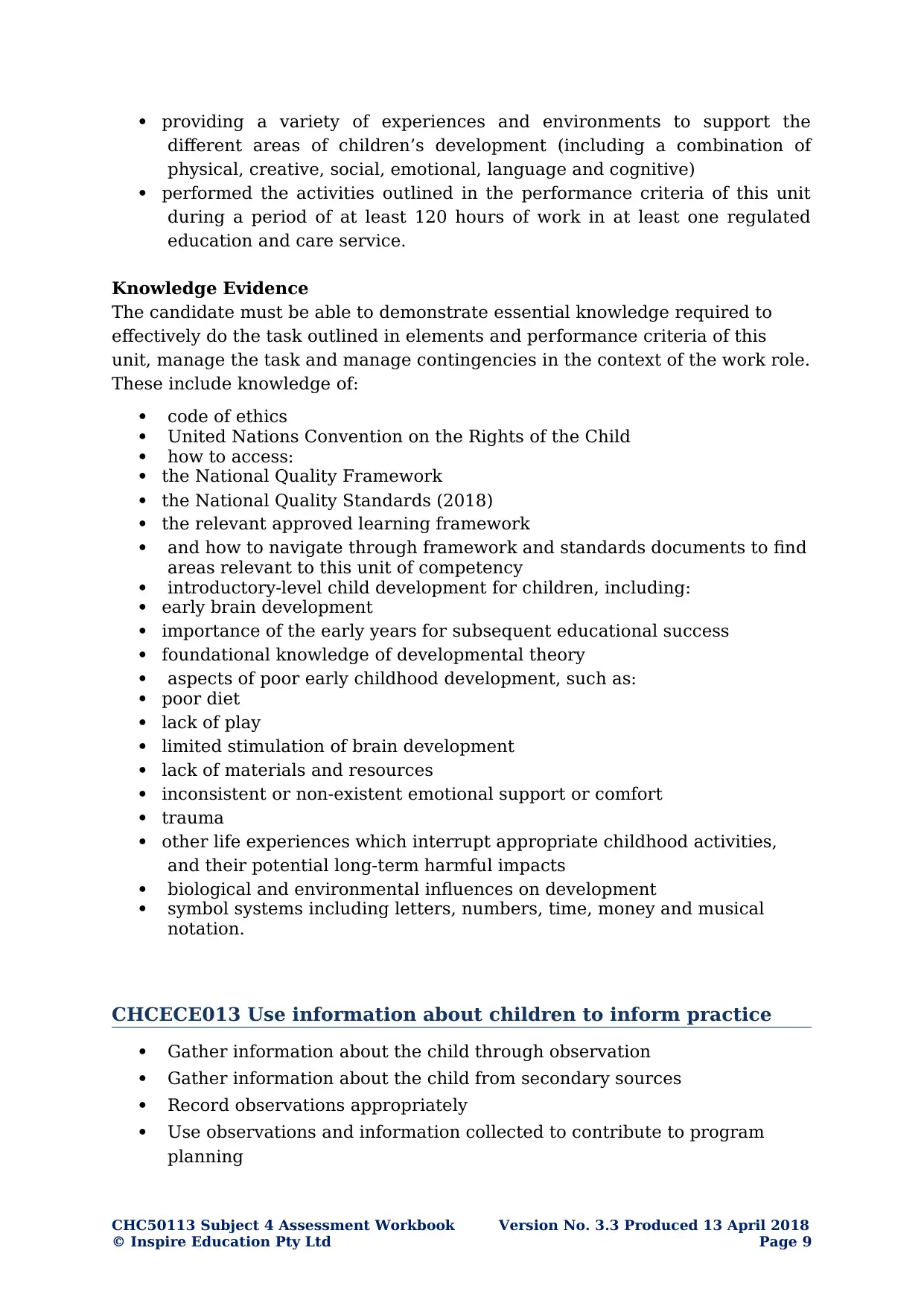
providing a variety of experiences and environments to support the
different areas of children’s development (including a combination of
physical, creative, social, emotional, language and cognitive)
performed the activities outlined in the performance criteria of this unit
during a period of at least 120 hours of work in at least one regulated
education and care service.
Knowledge Evidence
The candidate must be able to demonstrate essential knowledge required to
effectively do the task outlined in elements and performance criteria of this
unit, manage the task and manage contingencies in the context of the work role.
These include knowledge of:
code of ethics
United Nations Convention on the Rights of the Child
how to access:
the National Quality Framework
the National Quality Standards (2018)
the relevant approved learning framework
and how to navigate through framework and standards documents to find
areas relevant to this unit of competency
introductory-level child development for children, including:
early brain development
importance of the early years for subsequent educational success
foundational knowledge of developmental theory
aspects of poor early childhood development, such as:
poor diet
lack of play
limited stimulation of brain development
lack of materials and resources
inconsistent or non-existent emotional support or comfort
trauma
other life experiences which interrupt appropriate childhood activities,
and their potential long-term harmful impacts
biological and environmental influences on development
symbol systems including letters, numbers, time, money and musical
notation.
CHCECE013 Use information about children to inform practice
Gather information about the child through observation
Gather information about the child from secondary sources
Record observations appropriately
Use observations and information collected to contribute to program
planning
CHC50113 Subject 4 Assessment Workbook Version No. 3.3 Produced 13 April 2018
© Inspire Education Pty Ltd Page 9
different areas of children’s development (including a combination of
physical, creative, social, emotional, language and cognitive)
performed the activities outlined in the performance criteria of this unit
during a period of at least 120 hours of work in at least one regulated
education and care service.
Knowledge Evidence
The candidate must be able to demonstrate essential knowledge required to
effectively do the task outlined in elements and performance criteria of this
unit, manage the task and manage contingencies in the context of the work role.
These include knowledge of:
code of ethics
United Nations Convention on the Rights of the Child
how to access:
the National Quality Framework
the National Quality Standards (2018)
the relevant approved learning framework
and how to navigate through framework and standards documents to find
areas relevant to this unit of competency
introductory-level child development for children, including:
early brain development
importance of the early years for subsequent educational success
foundational knowledge of developmental theory
aspects of poor early childhood development, such as:
poor diet
lack of play
limited stimulation of brain development
lack of materials and resources
inconsistent or non-existent emotional support or comfort
trauma
other life experiences which interrupt appropriate childhood activities,
and their potential long-term harmful impacts
biological and environmental influences on development
symbol systems including letters, numbers, time, money and musical
notation.
CHCECE013 Use information about children to inform practice
Gather information about the child through observation
Gather information about the child from secondary sources
Record observations appropriately
Use observations and information collected to contribute to program
planning
CHC50113 Subject 4 Assessment Workbook Version No. 3.3 Produced 13 April 2018
© Inspire Education Pty Ltd Page 9

This unit describes the skills and knowledge required to gather information
about children through observation and other sources as a basis to inform
program-planning cycles and to share with children and their families.
This unit applies to educators working in a range of education and care
services.
Performance Evidence
The candidate must show evidence of the ability to complete tasks outlined in
elements and performance criteria of this unit, manage tasks and manage
contingencies in the context of the job role. There must be demonstrated
evidence that the candidate has completed the following tasks:
observed, documented and analysed information regarding at least three
children of varying ages, including:
o gathering and recording information using:
observations
questioning
discussion with families
anecdotal information
learning stories
jottings
digital images
samples of children’s work
o analysing observations of the children’s behaviour,
including:
aspects of child’s development
knowledge, ideas, abilities and interests
social interactions
reactions to play environment
o writing reports that record observations accurately and
respectfully to the level of detail expected in the service
o using information to contribute to program/planning.
Knowledge Evidence
The candidate must be able to demonstrate essential knowledge required to
effectively do the task outlined in elements and performance criteria of this
unit, manage the task and manage contingencies in the context of the work
role. These include knowledge of:
how to access:
o the National Quality Framework
o the National Quality Standards (2018)
o the relevant approved learning framework
how to navigate through standards and framework documents to find
areas relevant to this unit of competency
United Nations Convention on the Rights of the Child
code of ethics
reflective practice
CHC50113 Subject 4 Assessment Workbook Version No. 3.3 Produced 13 April 2018
Page 10 © Inspire Education Pty Ltd
about children through observation and other sources as a basis to inform
program-planning cycles and to share with children and their families.
This unit applies to educators working in a range of education and care
services.
Performance Evidence
The candidate must show evidence of the ability to complete tasks outlined in
elements and performance criteria of this unit, manage tasks and manage
contingencies in the context of the job role. There must be demonstrated
evidence that the candidate has completed the following tasks:
observed, documented and analysed information regarding at least three
children of varying ages, including:
o gathering and recording information using:
observations
questioning
discussion with families
anecdotal information
learning stories
jottings
digital images
samples of children’s work
o analysing observations of the children’s behaviour,
including:
aspects of child’s development
knowledge, ideas, abilities and interests
social interactions
reactions to play environment
o writing reports that record observations accurately and
respectfully to the level of detail expected in the service
o using information to contribute to program/planning.
Knowledge Evidence
The candidate must be able to demonstrate essential knowledge required to
effectively do the task outlined in elements and performance criteria of this
unit, manage the task and manage contingencies in the context of the work
role. These include knowledge of:
how to access:
o the National Quality Framework
o the National Quality Standards (2018)
o the relevant approved learning framework
how to navigate through standards and framework documents to find
areas relevant to this unit of competency
United Nations Convention on the Rights of the Child
code of ethics
reflective practice
CHC50113 Subject 4 Assessment Workbook Version No. 3.3 Produced 13 April 2018
Page 10 © Inspire Education Pty Ltd
Secure Best Marks with AI Grader
Need help grading? Try our AI Grader for instant feedback on your assignments.
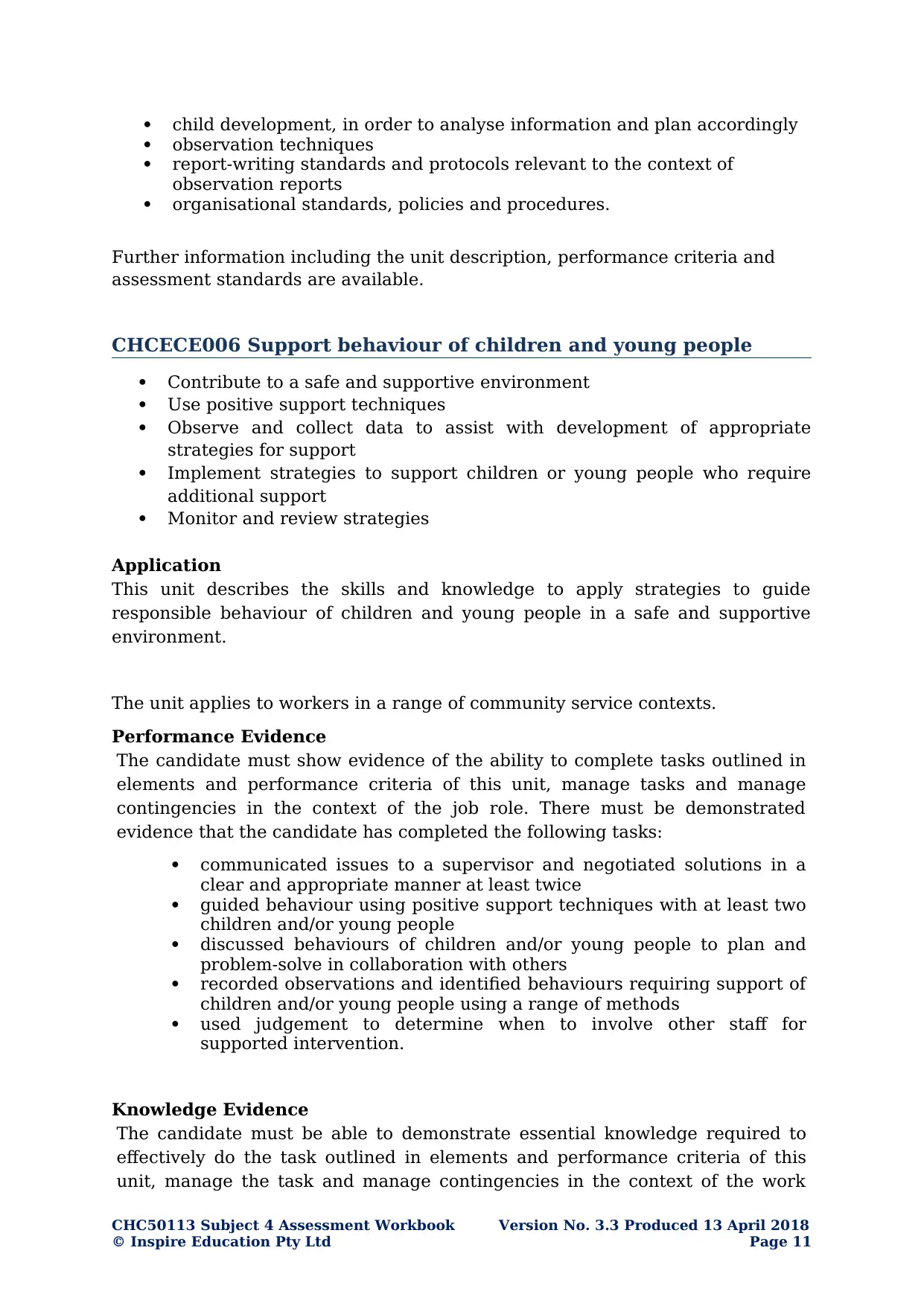
child development, in order to analyse information and plan accordingly
observation techniques
report-writing standards and protocols relevant to the context of
observation reports
organisational standards, policies and procedures.
Further information including the unit description, performance criteria and
assessment standards are available.
CHCECE006 Support behaviour of children and young people
Contribute to a safe and supportive environment
Use positive support techniques
Observe and collect data to assist with development of appropriate
strategies for support
Implement strategies to support children or young people who require
additional support
Monitor and review strategies
Application
This unit describes the skills and knowledge to apply strategies to guide
responsible behaviour of children and young people in a safe and supportive
environment.
The unit applies to workers in a range of community service contexts.
Performance Evidence
The candidate must show evidence of the ability to complete tasks outlined in
elements and performance criteria of this unit, manage tasks and manage
contingencies in the context of the job role. There must be demonstrated
evidence that the candidate has completed the following tasks:
communicated issues to a supervisor and negotiated solutions in a
clear and appropriate manner at least twice
guided behaviour using positive support techniques with at least two
children and/or young people
discussed behaviours of children and/or young people to plan and
problem-solve in collaboration with others
recorded observations and identified behaviours requiring support of
children and/or young people using a range of methods
used judgement to determine when to involve other staff for
supported intervention.
Knowledge Evidence
The candidate must be able to demonstrate essential knowledge required to
effectively do the task outlined in elements and performance criteria of this
unit, manage the task and manage contingencies in the context of the work
CHC50113 Subject 4 Assessment Workbook Version No. 3.3 Produced 13 April 2018
© Inspire Education Pty Ltd Page 11
observation techniques
report-writing standards and protocols relevant to the context of
observation reports
organisational standards, policies and procedures.
Further information including the unit description, performance criteria and
assessment standards are available.
CHCECE006 Support behaviour of children and young people
Contribute to a safe and supportive environment
Use positive support techniques
Observe and collect data to assist with development of appropriate
strategies for support
Implement strategies to support children or young people who require
additional support
Monitor and review strategies
Application
This unit describes the skills and knowledge to apply strategies to guide
responsible behaviour of children and young people in a safe and supportive
environment.
The unit applies to workers in a range of community service contexts.
Performance Evidence
The candidate must show evidence of the ability to complete tasks outlined in
elements and performance criteria of this unit, manage tasks and manage
contingencies in the context of the job role. There must be demonstrated
evidence that the candidate has completed the following tasks:
communicated issues to a supervisor and negotiated solutions in a
clear and appropriate manner at least twice
guided behaviour using positive support techniques with at least two
children and/or young people
discussed behaviours of children and/or young people to plan and
problem-solve in collaboration with others
recorded observations and identified behaviours requiring support of
children and/or young people using a range of methods
used judgement to determine when to involve other staff for
supported intervention.
Knowledge Evidence
The candidate must be able to demonstrate essential knowledge required to
effectively do the task outlined in elements and performance criteria of this
unit, manage the task and manage contingencies in the context of the work
CHC50113 Subject 4 Assessment Workbook Version No. 3.3 Produced 13 April 2018
© Inspire Education Pty Ltd Page 11

role. These include knowledge of:
definitions of and differences between disruptive behaviour and
behaviours of concern
how learning difficulties or mental health issues may affect behaviour
impacts of environment and culture on behaviour of children and/or
young people
communicative function of behaviour and positive support strategies
to redirect behaviour and defuse situations
organisational standards, policies and procedures.
CHCECE007 Develop positive and respectful relationships with
children
Communicate positively with children
Interact positively with children
Support and respect children
Maintain the dignity and rights of children
Application
This unit describes the skills and knowledge required by educators working
with children to ensure they can develop and maintain effective relationships
and promote positive behaviour.
This unit applies to educators who work with children in a range of education
and care service settings.
Foundation Skills
The foundation skills described those required skills (language, literacy and
numeracy) that are essential to performance.
Oral communication – in order to engage in sustained conversations with
children.
The remaining foundation skills essential to performance are explicit in the
performance criteria of this unit.
Performance Evidence
The candidate must show evidence of the ability to complete tasks outlined in
elements and performance criteria of this unit, manage tasks and manage
contingencies in the context of the job role. There must be demonstrated
evidence that the candidate has completed the following tasks at least once:
communicated positively and respectfully and interacted effectively
with at least three children, including:
o active listening
o consideration of a child’s age, activities, interests, culture and
needs
o interpreting non-verbal cues of children
CHC50113 Subject 4 Assessment Workbook Version No. 3.3 Produced 13 April 2018
Page 12 © Inspire Education Pty Ltd
definitions of and differences between disruptive behaviour and
behaviours of concern
how learning difficulties or mental health issues may affect behaviour
impacts of environment and culture on behaviour of children and/or
young people
communicative function of behaviour and positive support strategies
to redirect behaviour and defuse situations
organisational standards, policies and procedures.
CHCECE007 Develop positive and respectful relationships with
children
Communicate positively with children
Interact positively with children
Support and respect children
Maintain the dignity and rights of children
Application
This unit describes the skills and knowledge required by educators working
with children to ensure they can develop and maintain effective relationships
and promote positive behaviour.
This unit applies to educators who work with children in a range of education
and care service settings.
Foundation Skills
The foundation skills described those required skills (language, literacy and
numeracy) that are essential to performance.
Oral communication – in order to engage in sustained conversations with
children.
The remaining foundation skills essential to performance are explicit in the
performance criteria of this unit.
Performance Evidence
The candidate must show evidence of the ability to complete tasks outlined in
elements and performance criteria of this unit, manage tasks and manage
contingencies in the context of the job role. There must be demonstrated
evidence that the candidate has completed the following tasks at least once:
communicated positively and respectfully and interacted effectively
with at least three children, including:
o active listening
o consideration of a child’s age, activities, interests, culture and
needs
o interpreting non-verbal cues of children
CHC50113 Subject 4 Assessment Workbook Version No. 3.3 Produced 13 April 2018
Page 12 © Inspire Education Pty Ltd

o responding to distress in ways that meets the child’s need
o communication of care and respect through all interactions
assessed and responded appropriately to behaviours of concern
encouraged children to respect similarities and differences between
each other
involved and encouraged children in decision-making and planning
performed the activities outlined in the performance criteria of this
unit during a period of at least 120 hours of work in at least one
regulated education and care service
Knowledge Evidence
The candidate must be able to demonstrate essential knowledge required to
effectively do the task outlined in elements and performance criteria of this
unit, manage the task and manage contingencies in the context of the work
role. These include knowledge of:
how to access:
o the National Quality Framework
o the National Quality Standards (2018)
o the relevant approved learning framework
how to navigate through framework and standards documents to find
areas relevant to this unit of competency
effective communication techniques including verbal and non-verbal
ways to show respect
techniques to guide children’s behaviour
United Nations Convention on the Rights of the Child
organisational standards, policies and procedures.
CHC50113 Subject 4 Assessment Workbook Version No. 3.3 Produced 13 April 2018
© Inspire Education Pty Ltd Page 13
o communication of care and respect through all interactions
assessed and responded appropriately to behaviours of concern
encouraged children to respect similarities and differences between
each other
involved and encouraged children in decision-making and planning
performed the activities outlined in the performance criteria of this
unit during a period of at least 120 hours of work in at least one
regulated education and care service
Knowledge Evidence
The candidate must be able to demonstrate essential knowledge required to
effectively do the task outlined in elements and performance criteria of this
unit, manage the task and manage contingencies in the context of the work
role. These include knowledge of:
how to access:
o the National Quality Framework
o the National Quality Standards (2018)
o the relevant approved learning framework
how to navigate through framework and standards documents to find
areas relevant to this unit of competency
effective communication techniques including verbal and non-verbal
ways to show respect
techniques to guide children’s behaviour
United Nations Convention on the Rights of the Child
organisational standards, policies and procedures.
CHC50113 Subject 4 Assessment Workbook Version No. 3.3 Produced 13 April 2018
© Inspire Education Pty Ltd Page 13
Paraphrase This Document
Need a fresh take? Get an instant paraphrase of this document with our AI Paraphraser
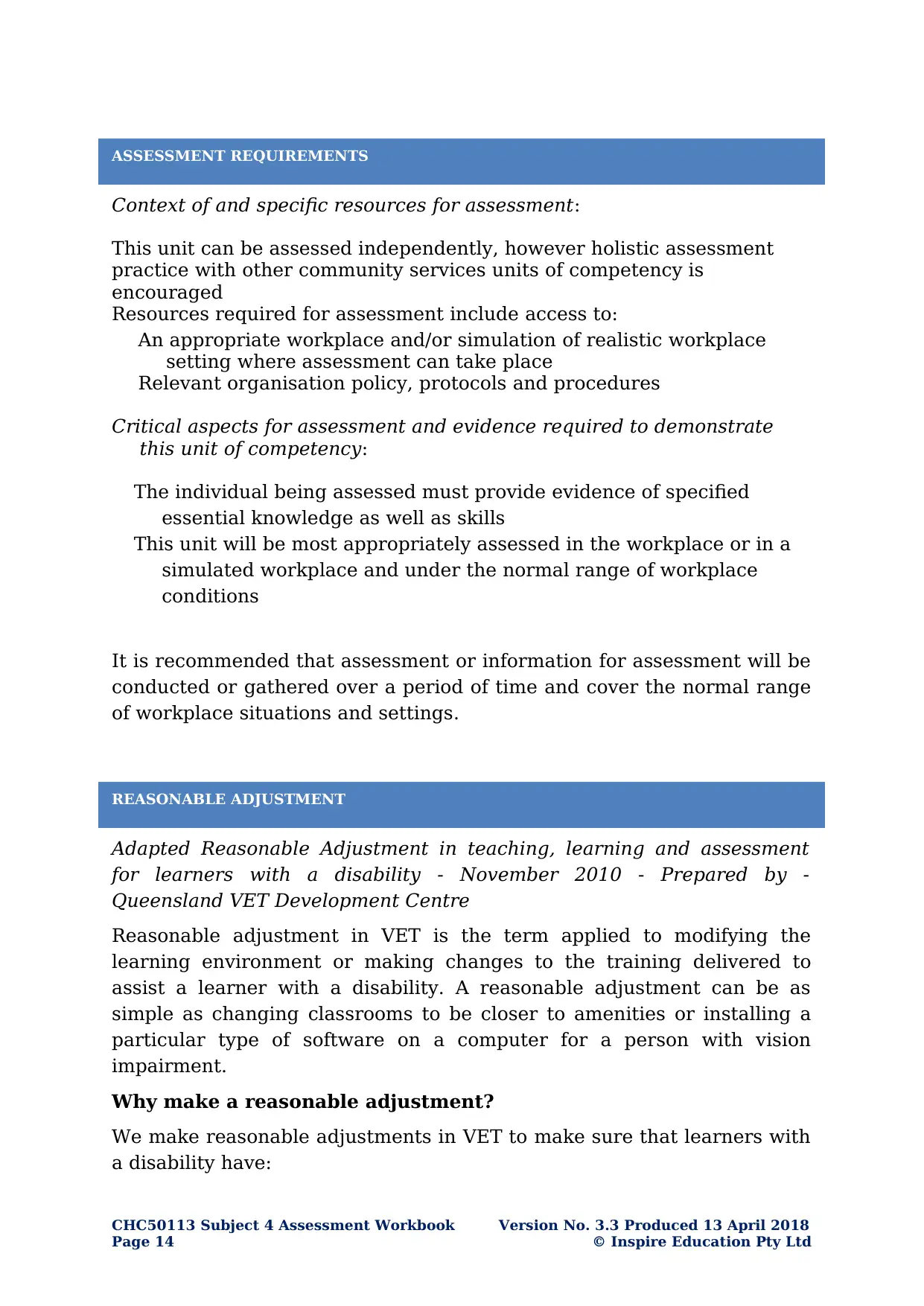
ASSESSMENT REQUIREMENTS
Context of and specific resources for assessment:
This unit can be assessed independently, however holistic assessment
practice with other community services units of competency is
encouraged
Resources required for assessment include access to:
An appropriate workplace and/or simulation of realistic workplace
setting where assessment can take place
Relevant organisation policy, protocols and procedures
Critical aspects for assessment and evidence required to demonstrate
this unit of competency:
The individual being assessed must provide evidence of specified
essential knowledge as well as skills
This unit will be most appropriately assessed in the workplace or in a
simulated workplace and under the normal range of workplace
conditions
It is recommended that assessment or information for assessment will be
conducted or gathered over a period of time and cover the normal range
of workplace situations and settings.
REASONABLE ADJUSTMENT
Adapted Reasonable Adjustment in teaching, learning and assessment
for learners with a disability - November 2010 - Prepared by -
Queensland VET Development Centre
Reasonable adjustment in VET is the term applied to modifying the
learning environment or making changes to the training delivered to
assist a learner with a disability. A reasonable adjustment can be as
simple as changing classrooms to be closer to amenities or installing a
particular type of software on a computer for a person with vision
impairment.
Why make a reasonable adjustment?
We make reasonable adjustments in VET to make sure that learners with
a disability have:
CHC50113 Subject 4 Assessment Workbook Version No. 3.3 Produced 13 April 2018
Page 14 © Inspire Education Pty Ltd
Context of and specific resources for assessment:
This unit can be assessed independently, however holistic assessment
practice with other community services units of competency is
encouraged
Resources required for assessment include access to:
An appropriate workplace and/or simulation of realistic workplace
setting where assessment can take place
Relevant organisation policy, protocols and procedures
Critical aspects for assessment and evidence required to demonstrate
this unit of competency:
The individual being assessed must provide evidence of specified
essential knowledge as well as skills
This unit will be most appropriately assessed in the workplace or in a
simulated workplace and under the normal range of workplace
conditions
It is recommended that assessment or information for assessment will be
conducted or gathered over a period of time and cover the normal range
of workplace situations and settings.
REASONABLE ADJUSTMENT
Adapted Reasonable Adjustment in teaching, learning and assessment
for learners with a disability - November 2010 - Prepared by -
Queensland VET Development Centre
Reasonable adjustment in VET is the term applied to modifying the
learning environment or making changes to the training delivered to
assist a learner with a disability. A reasonable adjustment can be as
simple as changing classrooms to be closer to amenities or installing a
particular type of software on a computer for a person with vision
impairment.
Why make a reasonable adjustment?
We make reasonable adjustments in VET to make sure that learners with
a disability have:
CHC50113 Subject 4 Assessment Workbook Version No. 3.3 Produced 13 April 2018
Page 14 © Inspire Education Pty Ltd
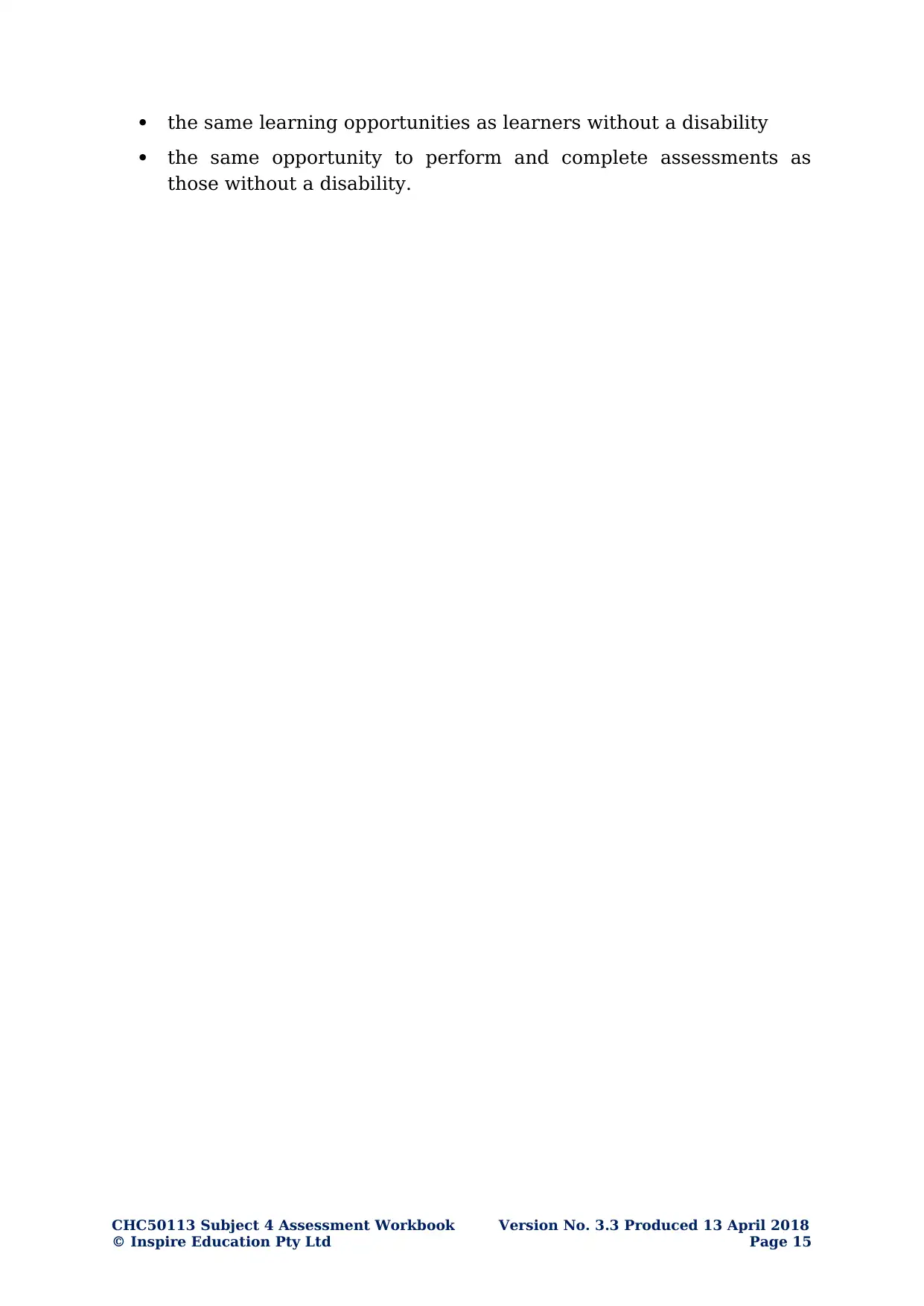
the same learning opportunities as learners without a disability
the same opportunity to perform and complete assessments as
those without a disability.
CHC50113 Subject 4 Assessment Workbook Version No. 3.3 Produced 13 April 2018
© Inspire Education Pty Ltd Page 15
the same opportunity to perform and complete assessments as
those without a disability.
CHC50113 Subject 4 Assessment Workbook Version No. 3.3 Produced 13 April 2018
© Inspire Education Pty Ltd Page 15
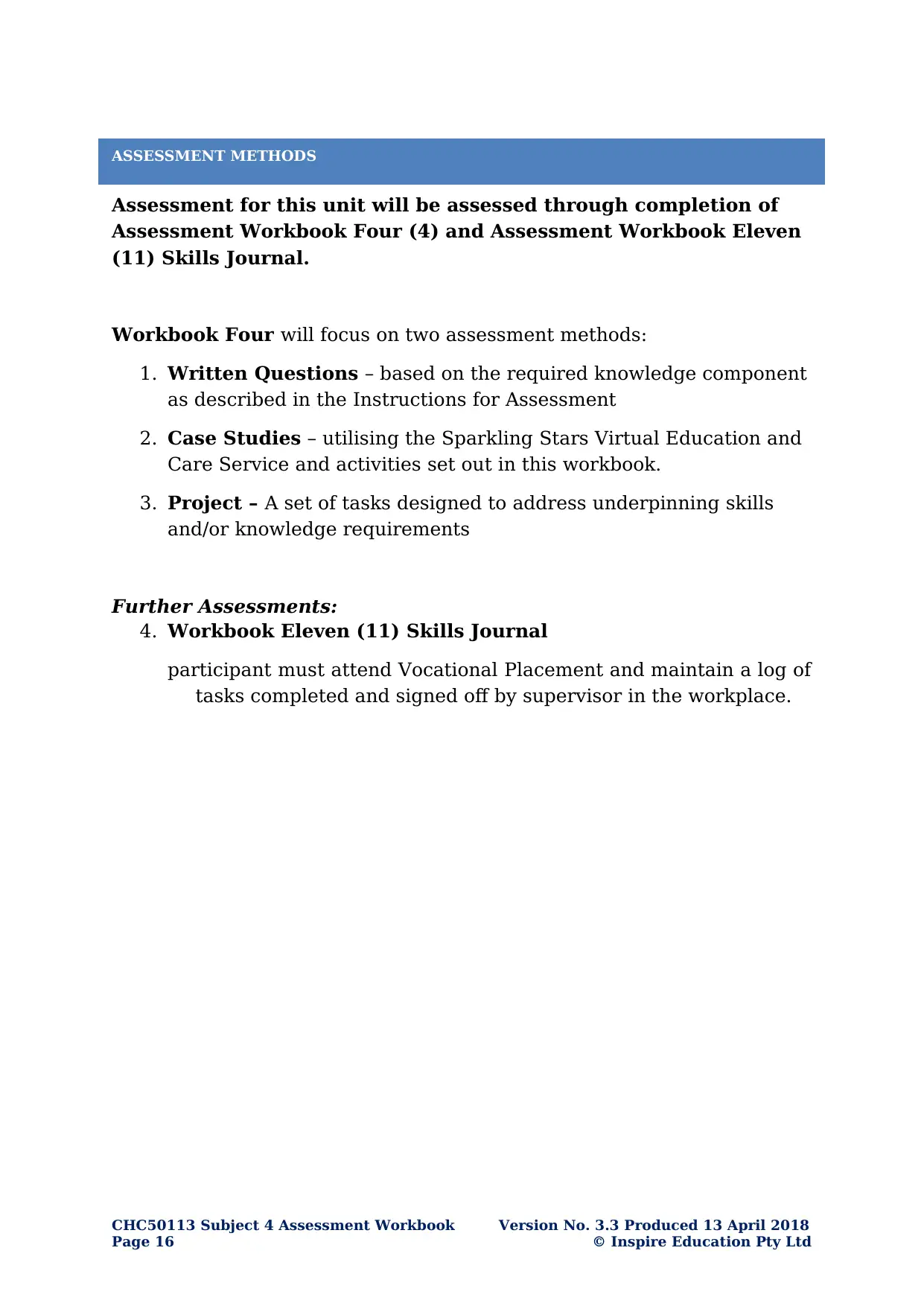
ASSESSMENT METHODS
Assessment for this unit will be assessed through completion of
Assessment Workbook Four (4) and Assessment Workbook Eleven
(11) Skills Journal.
Workbook Four will focus on two assessment methods:
1. Written Questions – based on the required knowledge component
as described in the Instructions for Assessment
2. Case Studies – utilising the Sparkling Stars Virtual Education and
Care Service and activities set out in this workbook.
3. Project – A set of tasks designed to address underpinning skills
and/or knowledge requirements
Further Assessments:
4. Workbook Eleven (11) Skills Journal
participant must attend Vocational Placement and maintain a log of
tasks completed and signed off by supervisor in the workplace.
CHC50113 Subject 4 Assessment Workbook Version No. 3.3 Produced 13 April 2018
Page 16 © Inspire Education Pty Ltd
Assessment for this unit will be assessed through completion of
Assessment Workbook Four (4) and Assessment Workbook Eleven
(11) Skills Journal.
Workbook Four will focus on two assessment methods:
1. Written Questions – based on the required knowledge component
as described in the Instructions for Assessment
2. Case Studies – utilising the Sparkling Stars Virtual Education and
Care Service and activities set out in this workbook.
3. Project – A set of tasks designed to address underpinning skills
and/or knowledge requirements
Further Assessments:
4. Workbook Eleven (11) Skills Journal
participant must attend Vocational Placement and maintain a log of
tasks completed and signed off by supervisor in the workplace.
CHC50113 Subject 4 Assessment Workbook Version No. 3.3 Produced 13 April 2018
Page 16 © Inspire Education Pty Ltd
Secure Best Marks with AI Grader
Need help grading? Try our AI Grader for instant feedback on your assignments.
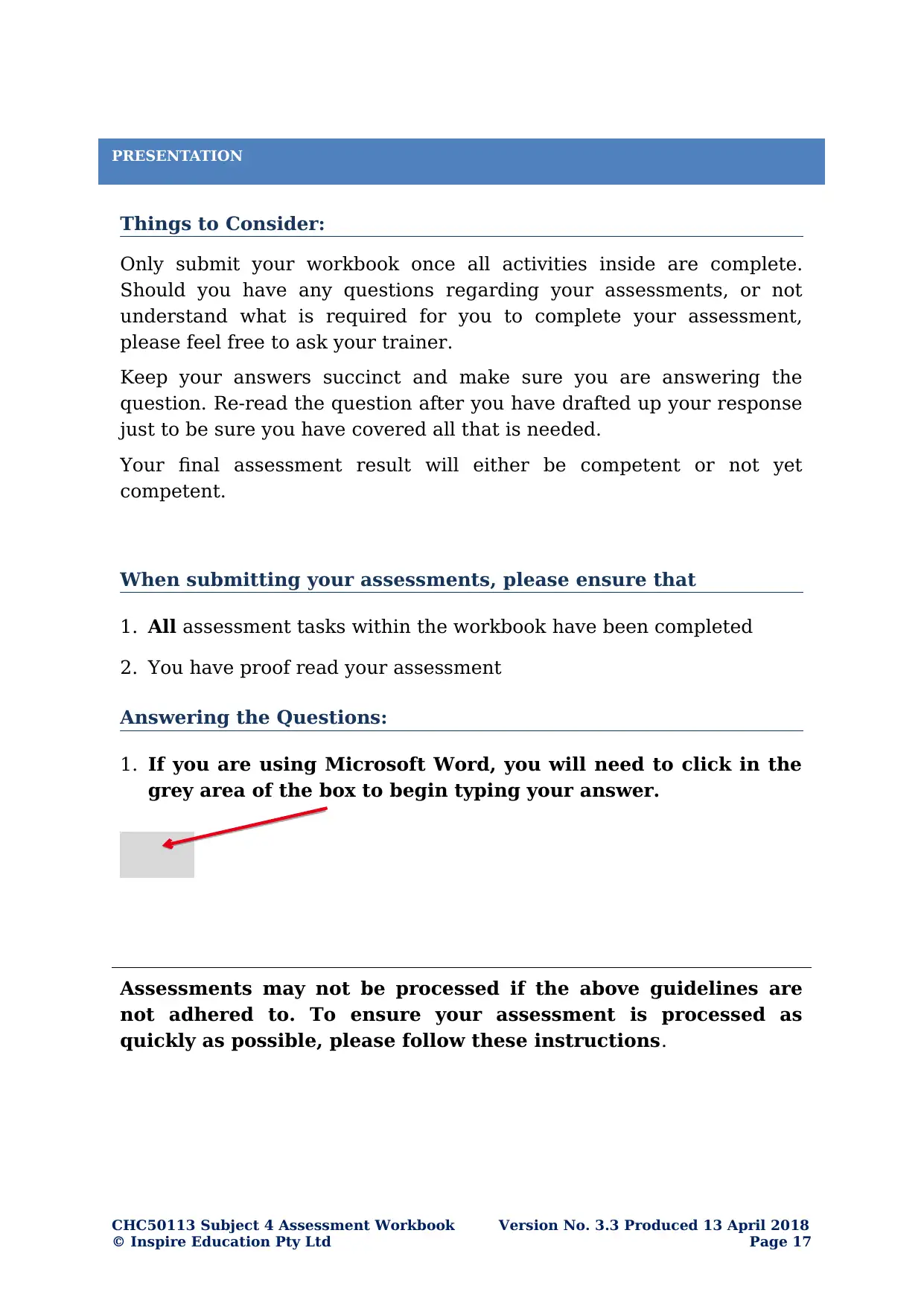
PRESENTATION
Things to Consider:
Only submit your workbook once all activities inside are complete.
Should you have any questions regarding your assessments, or not
understand what is required for you to complete your assessment,
please feel free to ask your trainer.
Keep your answers succinct and make sure you are answering the
question. Re-read the question after you have drafted up your response
just to be sure you have covered all that is needed.
Your final assessment result will either be competent or not yet
competent.
When submitting your assessments, please ensure that
1. All assessment tasks within the workbook have been completed
2. You have proof read your assessment
Answering the Questions:
1. If you are using Microsoft Word, you will need to click in the
grey area of the box to begin typing your answer.
Assessments may not be processed if the above guidelines are
not adhered to. To ensure your assessment is processed as
quickly as possible, please follow these instructions.
CHC50113 Subject 4 Assessment Workbook Version No. 3.3 Produced 13 April 2018
© Inspire Education Pty Ltd Page 17
Things to Consider:
Only submit your workbook once all activities inside are complete.
Should you have any questions regarding your assessments, or not
understand what is required for you to complete your assessment,
please feel free to ask your trainer.
Keep your answers succinct and make sure you are answering the
question. Re-read the question after you have drafted up your response
just to be sure you have covered all that is needed.
Your final assessment result will either be competent or not yet
competent.
When submitting your assessments, please ensure that
1. All assessment tasks within the workbook have been completed
2. You have proof read your assessment
Answering the Questions:
1. If you are using Microsoft Word, you will need to click in the
grey area of the box to begin typing your answer.
Assessments may not be processed if the above guidelines are
not adhered to. To ensure your assessment is processed as
quickly as possible, please follow these instructions.
CHC50113 Subject 4 Assessment Workbook Version No. 3.3 Produced 13 April 2018
© Inspire Education Pty Ltd Page 17
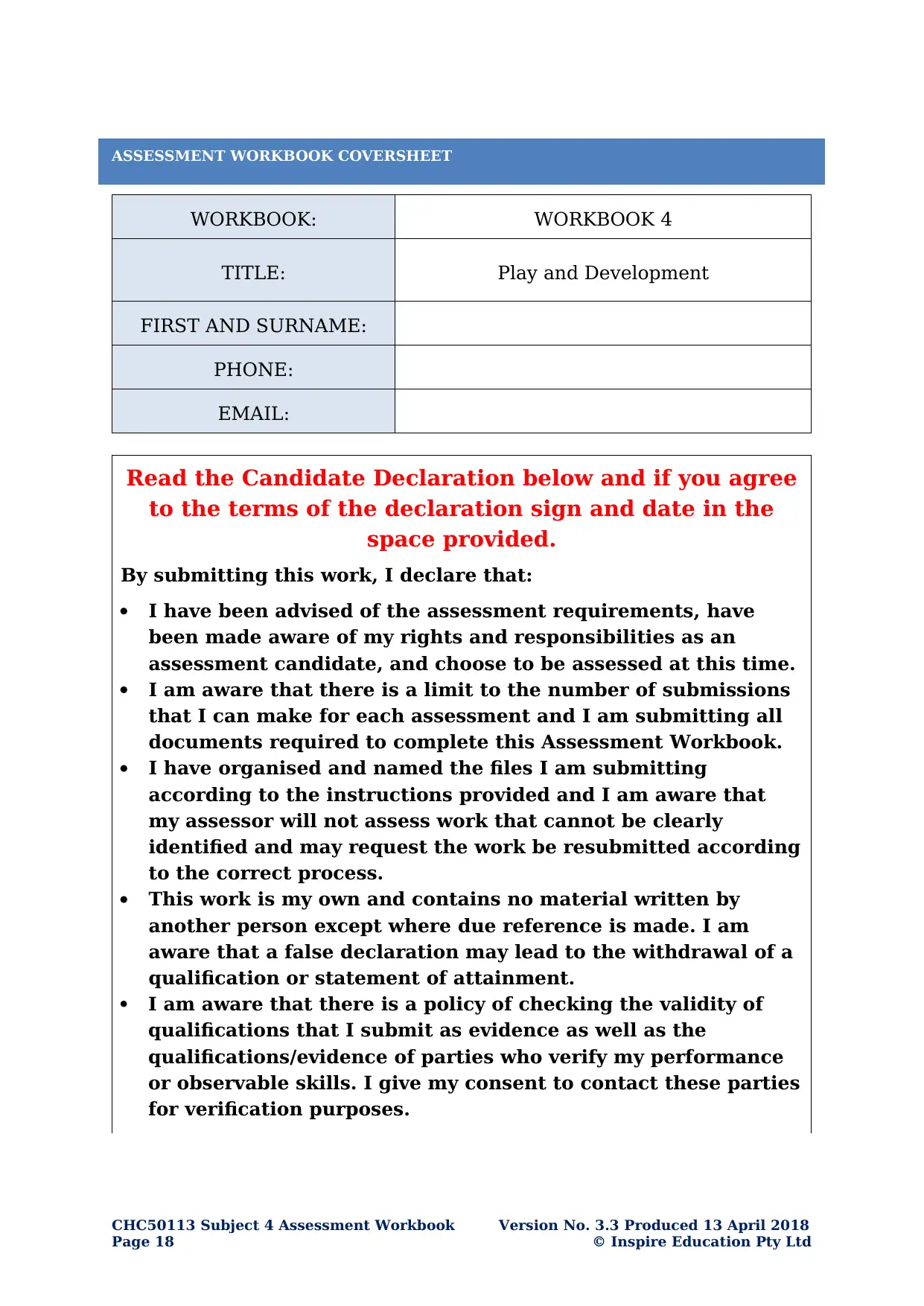
ASSESSMENT WORKBOOK COVERSHEET
WORKBOOK: WORKBOOK 4
TITLE: Play and Development
FIRST AND SURNAME:
PHONE:
EMAIL:
Read the Candidate Declaration below and if you agree
to the terms of the declaration sign and date in the
space provided.
By submitting this work, I declare that:
I have been advised of the assessment requirements, have
been made aware of my rights and responsibilities as an
assessment candidate, and choose to be assessed at this time.
I am aware that there is a limit to the number of submissions
that I can make for each assessment and I am submitting all
documents required to complete this Assessment Workbook.
I have organised and named the files I am submitting
according to the instructions provided and I am aware that
my assessor will not assess work that cannot be clearly
identified and may request the work be resubmitted according
to the correct process.
This work is my own and contains no material written by
another person except where due reference is made. I am
aware that a false declaration may lead to the withdrawal of a
qualification or statement of attainment.
I am aware that there is a policy of checking the validity of
qualifications that I submit as evidence as well as the
qualifications/evidence of parties who verify my performance
or observable skills. I give my consent to contact these parties
for verification purposes.
CHC50113 Subject 4 Assessment Workbook Version No. 3.3 Produced 13 April 2018
Page 18 © Inspire Education Pty Ltd
WORKBOOK: WORKBOOK 4
TITLE: Play and Development
FIRST AND SURNAME:
PHONE:
EMAIL:
Read the Candidate Declaration below and if you agree
to the terms of the declaration sign and date in the
space provided.
By submitting this work, I declare that:
I have been advised of the assessment requirements, have
been made aware of my rights and responsibilities as an
assessment candidate, and choose to be assessed at this time.
I am aware that there is a limit to the number of submissions
that I can make for each assessment and I am submitting all
documents required to complete this Assessment Workbook.
I have organised and named the files I am submitting
according to the instructions provided and I am aware that
my assessor will not assess work that cannot be clearly
identified and may request the work be resubmitted according
to the correct process.
This work is my own and contains no material written by
another person except where due reference is made. I am
aware that a false declaration may lead to the withdrawal of a
qualification or statement of attainment.
I am aware that there is a policy of checking the validity of
qualifications that I submit as evidence as well as the
qualifications/evidence of parties who verify my performance
or observable skills. I give my consent to contact these parties
for verification purposes.
CHC50113 Subject 4 Assessment Workbook Version No. 3.3 Produced 13 April 2018
Page 18 © Inspire Education Pty Ltd

CHC50113 Subject 4 Assessment Workbook Version No. 3.3 Produced 13 April 2018
© Inspire Education Pty Ltd Page 19
© Inspire Education Pty Ltd Page 19
Paraphrase This Document
Need a fresh take? Get an instant paraphrase of this document with our AI Paraphraser

KNOWLEDGE ASSESSMENT
Part A – Holistic Development
1. Nutrition is extremely important in relation to a child’s brain
development.
a) Explain how adequate nutrition before a child’s birth is
important.
b) Explain how adequate nutrition after a child’s birth is
important.
a) There is extensive evidence to show that adequate nutrition
support brain development and enhance later school
performance. Adequate nutrition for pregnant mothers and
infants is necessary for normal brain development. Pregnancy
and infancy are important periods for the formation of the brain,
laying the foundation for the development of cognitive, motor,
and socio emotional skills throughout childhood and
adulthood.Undernutrition may influence brain development by
directly affecting brain processes or indirectly by affecting
children’s experiences and behavior. First, inadequate availability
of nutrients during gestation and infancy affects the structural
and functional development of the brain. Gestation and infancy
are periods of rapid brain development. The neural tube begins to
form 16 days after conception and within 7 months takes on a
form that resembles the adult brain. Nutrients are required for
many of the biological processes that drive this transformation.
For example, they are needed for the creation of new neurons.
The potential mechanisms through which breastfeeding may
improve cognitive development relate both to the composition of
breastmilk and to the experience of breastfeeding. Breastmilk
contains a suite of nutrients, growth factors, and hormones that
are important for brain development, including critical building
blocks such as docosahexaenoic acid (DHA) and choline. In high-
income countries, school-age children who were breastfed as
infants tend to have higher IQs than children who were fed with
formula. Adequate nutrition is important to a child’s brain
development during pregnancy and after birth as it provides all
CHC50113 Subject 4 Assessment Workbook Version No. 3.3 Produced 13 April 2018
Page 20 © Inspire Education Pty Ltd
Part A – Holistic Development
1. Nutrition is extremely important in relation to a child’s brain
development.
a) Explain how adequate nutrition before a child’s birth is
important.
b) Explain how adequate nutrition after a child’s birth is
important.
a) There is extensive evidence to show that adequate nutrition
support brain development and enhance later school
performance. Adequate nutrition for pregnant mothers and
infants is necessary for normal brain development. Pregnancy
and infancy are important periods for the formation of the brain,
laying the foundation for the development of cognitive, motor,
and socio emotional skills throughout childhood and
adulthood.Undernutrition may influence brain development by
directly affecting brain processes or indirectly by affecting
children’s experiences and behavior. First, inadequate availability
of nutrients during gestation and infancy affects the structural
and functional development of the brain. Gestation and infancy
are periods of rapid brain development. The neural tube begins to
form 16 days after conception and within 7 months takes on a
form that resembles the adult brain. Nutrients are required for
many of the biological processes that drive this transformation.
For example, they are needed for the creation of new neurons.
The potential mechanisms through which breastfeeding may
improve cognitive development relate both to the composition of
breastmilk and to the experience of breastfeeding. Breastmilk
contains a suite of nutrients, growth factors, and hormones that
are important for brain development, including critical building
blocks such as docosahexaenoic acid (DHA) and choline. In high-
income countries, school-age children who were breastfed as
infants tend to have higher IQs than children who were fed with
formula. Adequate nutrition is important to a child’s brain
development during pregnancy and after birth as it provides all
CHC50113 Subject 4 Assessment Workbook Version No. 3.3 Produced 13 April 2018
Page 20 © Inspire Education Pty Ltd
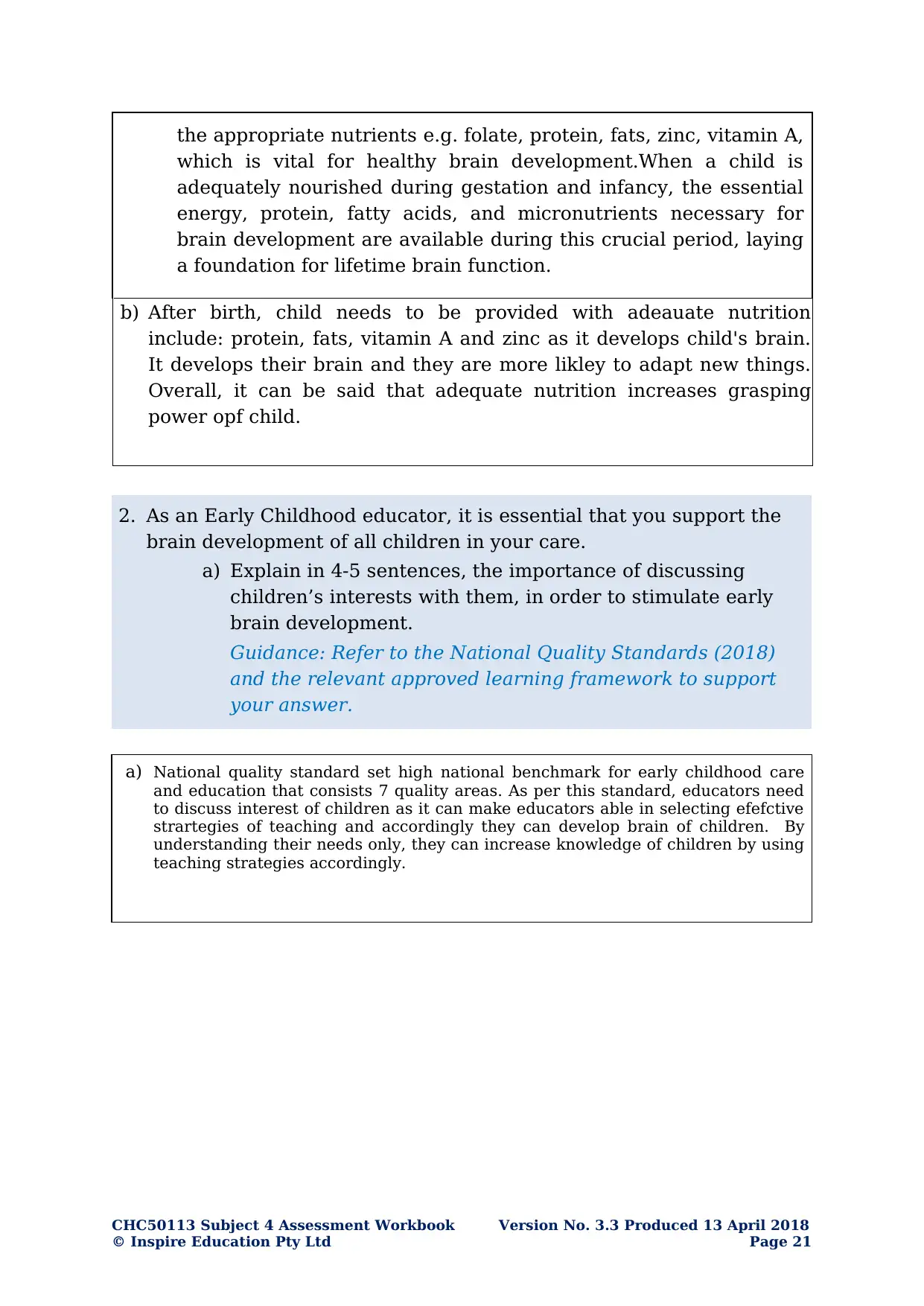
the appropriate nutrients e.g. folate, protein, fats, zinc, vitamin A,
which is vital for healthy brain development.When a child is
adequately nourished during gestation and infancy, the essential
energy, protein, fatty acids, and micronutrients necessary for
brain development are available during this crucial period, laying
a foundation for lifetime brain function.
b) After birth, child needs to be provided with adeauate nutrition
include: protein, fats, vitamin A and zinc as it develops child's brain.
It develops their brain and they are more likley to adapt new things.
Overall, it can be said that adequate nutrition increases grasping
power opf child.
2. As an Early Childhood educator, it is essential that you support the
brain development of all children in your care.
a) Explain in 4-5 sentences, the importance of discussing
children’s interests with them, in order to stimulate early
brain development.
Guidance: Refer to the National Quality Standards (2018)
and the relevant approved learning framework to support
your answer.
a) National quality standard set high national benchmark for early childhood care
and education that consists 7 quality areas. As per this standard, educators need
to discuss interest of children as it can make educators able in selecting efefctive
strartegies of teaching and accordingly they can develop brain of children. By
understanding their needs only, they can increase knowledge of children by using
teaching strategies accordingly.
CHC50113 Subject 4 Assessment Workbook Version No. 3.3 Produced 13 April 2018
© Inspire Education Pty Ltd Page 21
which is vital for healthy brain development.When a child is
adequately nourished during gestation and infancy, the essential
energy, protein, fatty acids, and micronutrients necessary for
brain development are available during this crucial period, laying
a foundation for lifetime brain function.
b) After birth, child needs to be provided with adeauate nutrition
include: protein, fats, vitamin A and zinc as it develops child's brain.
It develops their brain and they are more likley to adapt new things.
Overall, it can be said that adequate nutrition increases grasping
power opf child.
2. As an Early Childhood educator, it is essential that you support the
brain development of all children in your care.
a) Explain in 4-5 sentences, the importance of discussing
children’s interests with them, in order to stimulate early
brain development.
Guidance: Refer to the National Quality Standards (2018)
and the relevant approved learning framework to support
your answer.
a) National quality standard set high national benchmark for early childhood care
and education that consists 7 quality areas. As per this standard, educators need
to discuss interest of children as it can make educators able in selecting efefctive
strartegies of teaching and accordingly they can develop brain of children. By
understanding their needs only, they can increase knowledge of children by using
teaching strategies accordingly.
CHC50113 Subject 4 Assessment Workbook Version No. 3.3 Produced 13 April 2018
© Inspire Education Pty Ltd Page 21
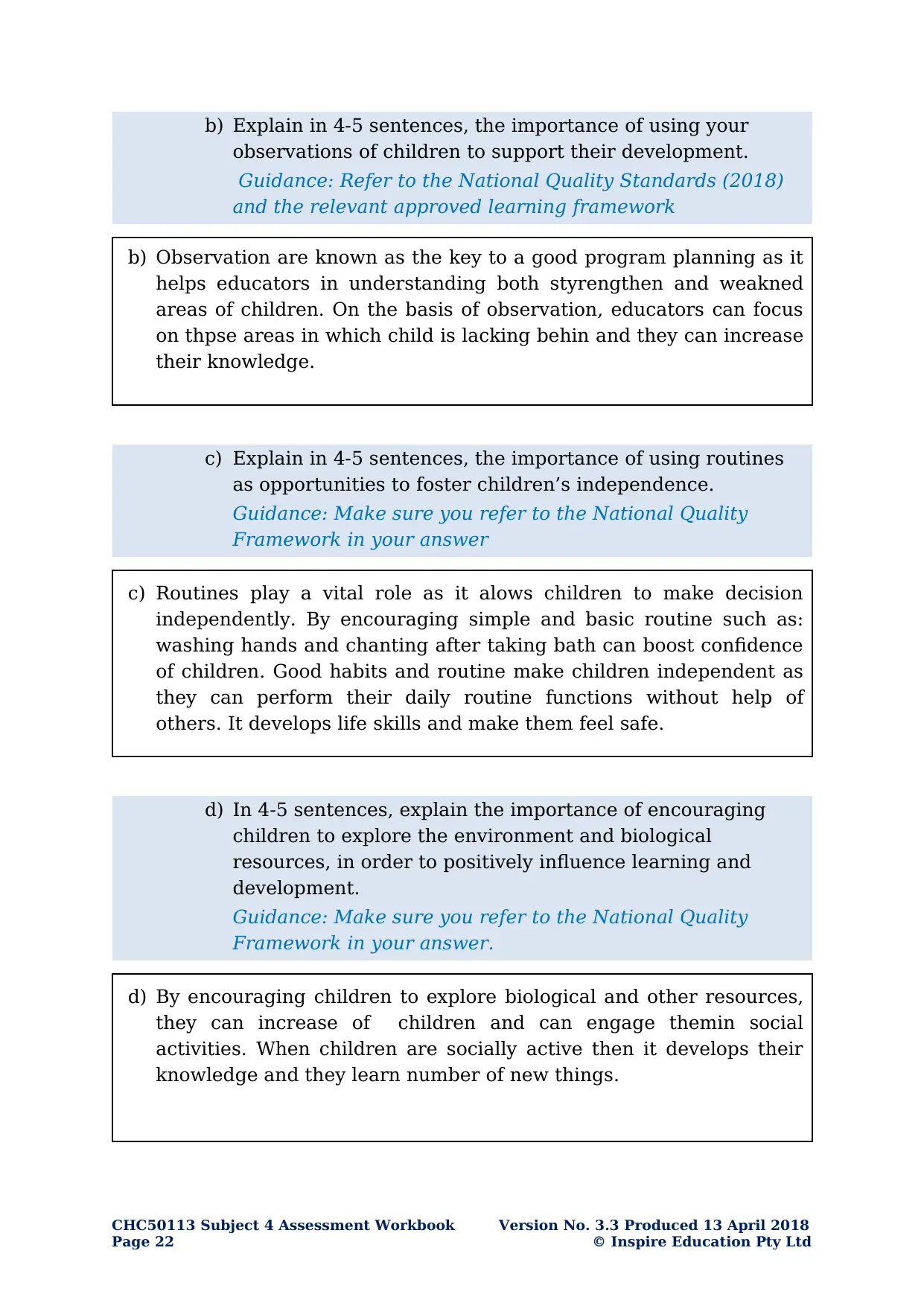
b) Explain in 4-5 sentences, the importance of using your
observations of children to support their development.
Guidance: Refer to the National Quality Standards (2018)
and the relevant approved learning framework
b) Observation are known as the key to a good program planning as it
helps educators in understanding both styrengthen and weakned
areas of children. On the basis of observation, educators can focus
on thpse areas in which child is lacking behin and they can increase
their knowledge.
c) Explain in 4-5 sentences, the importance of using routines
as opportunities to foster children’s independence.
Guidance: Make sure you refer to the National Quality
Framework in your answer
c) Routines play a vital role as it alows children to make decision
independently. By encouraging simple and basic routine such as:
washing hands and chanting after taking bath can boost confidence
of children. Good habits and routine make children independent as
they can perform their daily routine functions without help of
others. It develops life skills and make them feel safe.
d) In 4-5 sentences, explain the importance of encouraging
children to explore the environment and biological
resources, in order to positively influence learning and
development.
Guidance: Make sure you refer to the National Quality
Framework in your answer.
d) By encouraging children to explore biological and other resources,
they can increase of children and can engage themin social
activities. When children are socially active then it develops their
knowledge and they learn number of new things.
CHC50113 Subject 4 Assessment Workbook Version No. 3.3 Produced 13 April 2018
Page 22 © Inspire Education Pty Ltd
observations of children to support their development.
Guidance: Refer to the National Quality Standards (2018)
and the relevant approved learning framework
b) Observation are known as the key to a good program planning as it
helps educators in understanding both styrengthen and weakned
areas of children. On the basis of observation, educators can focus
on thpse areas in which child is lacking behin and they can increase
their knowledge.
c) Explain in 4-5 sentences, the importance of using routines
as opportunities to foster children’s independence.
Guidance: Make sure you refer to the National Quality
Framework in your answer
c) Routines play a vital role as it alows children to make decision
independently. By encouraging simple and basic routine such as:
washing hands and chanting after taking bath can boost confidence
of children. Good habits and routine make children independent as
they can perform their daily routine functions without help of
others. It develops life skills and make them feel safe.
d) In 4-5 sentences, explain the importance of encouraging
children to explore the environment and biological
resources, in order to positively influence learning and
development.
Guidance: Make sure you refer to the National Quality
Framework in your answer.
d) By encouraging children to explore biological and other resources,
they can increase of children and can engage themin social
activities. When children are socially active then it develops their
knowledge and they learn number of new things.
CHC50113 Subject 4 Assessment Workbook Version No. 3.3 Produced 13 April 2018
Page 22 © Inspire Education Pty Ltd
Secure Best Marks with AI Grader
Need help grading? Try our AI Grader for instant feedback on your assignments.
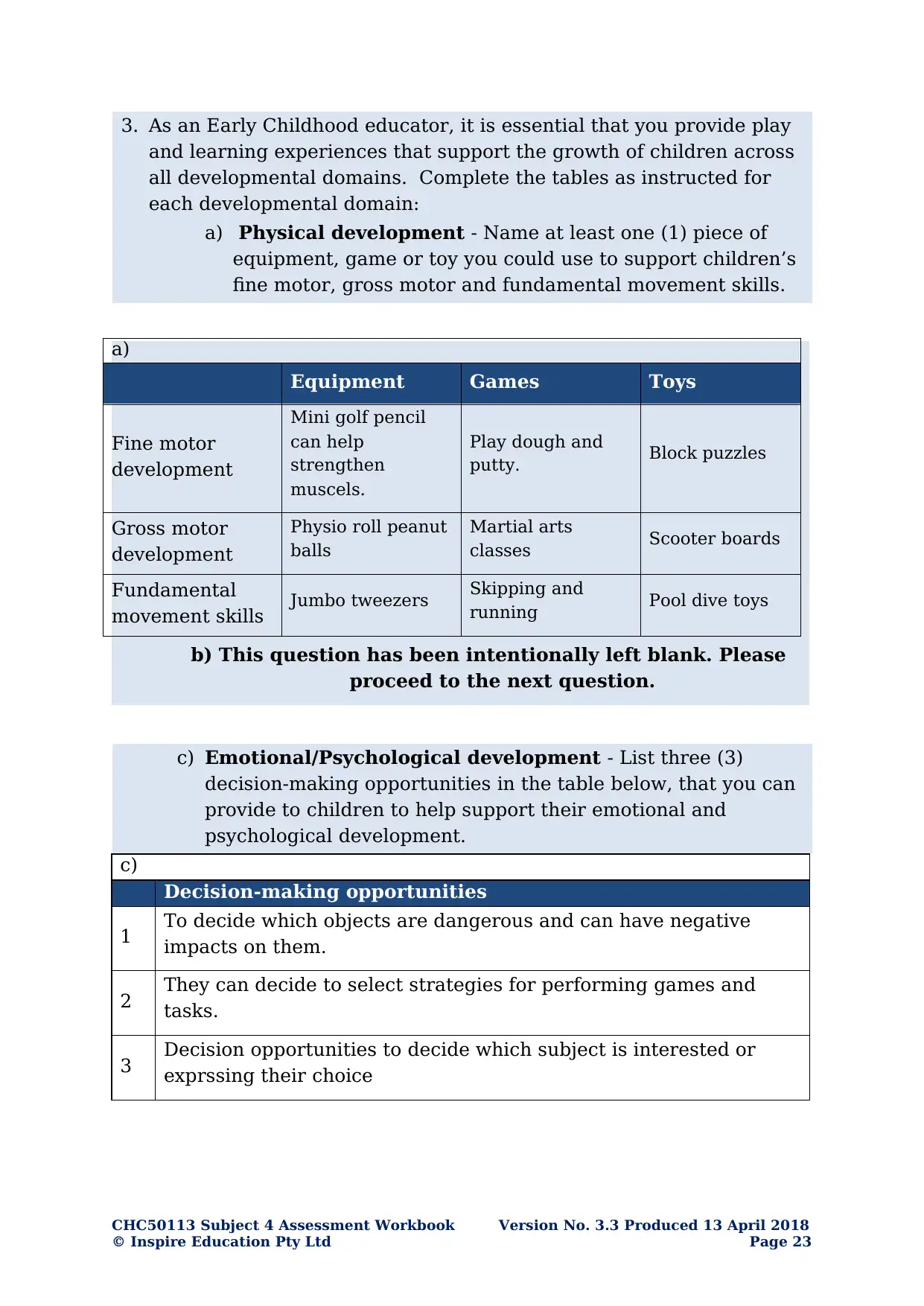
3. As an Early Childhood educator, it is essential that you provide play
and learning experiences that support the growth of children across
all developmental domains. Complete the tables as instructed for
each developmental domain:
a) Physical development - Name at least one (1) piece of
equipment, game or toy you could use to support children’s
fine motor, gross motor and fundamental movement skills.
b) This question has been intentionally left blank. Please
proceed to the next question.
c) Emotional/Psychological development - List three (3)
decision-making opportunities in the table below, that you can
provide to children to help support their emotional and
psychological development.
c)
Decision-making opportunities
1 To decide which objects are dangerous and can have negative
impacts on them.
2 They can decide to select strategies for performing games and
tasks.
3 Decision opportunities to decide which subject is interested or
exprssing their choice
CHC50113 Subject 4 Assessment Workbook Version No. 3.3 Produced 13 April 2018
© Inspire Education Pty Ltd Page 23
a)
Equipment Games Toys
Fine motor
development
Mini golf pencil
can help
strengthen
muscels.
Play dough and
putty. Block puzzles
Gross motor
development
Physio roll peanut
balls
Martial arts
classes Scooter boards
Fundamental
movement skills Jumbo tweezers Skipping and
running Pool dive toys
and learning experiences that support the growth of children across
all developmental domains. Complete the tables as instructed for
each developmental domain:
a) Physical development - Name at least one (1) piece of
equipment, game or toy you could use to support children’s
fine motor, gross motor and fundamental movement skills.
b) This question has been intentionally left blank. Please
proceed to the next question.
c) Emotional/Psychological development - List three (3)
decision-making opportunities in the table below, that you can
provide to children to help support their emotional and
psychological development.
c)
Decision-making opportunities
1 To decide which objects are dangerous and can have negative
impacts on them.
2 They can decide to select strategies for performing games and
tasks.
3 Decision opportunities to decide which subject is interested or
exprssing their choice
CHC50113 Subject 4 Assessment Workbook Version No. 3.3 Produced 13 April 2018
© Inspire Education Pty Ltd Page 23
a)
Equipment Games Toys
Fine motor
development
Mini golf pencil
can help
strengthen
muscels.
Play dough and
putty. Block puzzles
Gross motor
development
Physio roll peanut
balls
Martial arts
classes Scooter boards
Fundamental
movement skills Jumbo tweezers Skipping and
running Pool dive toys
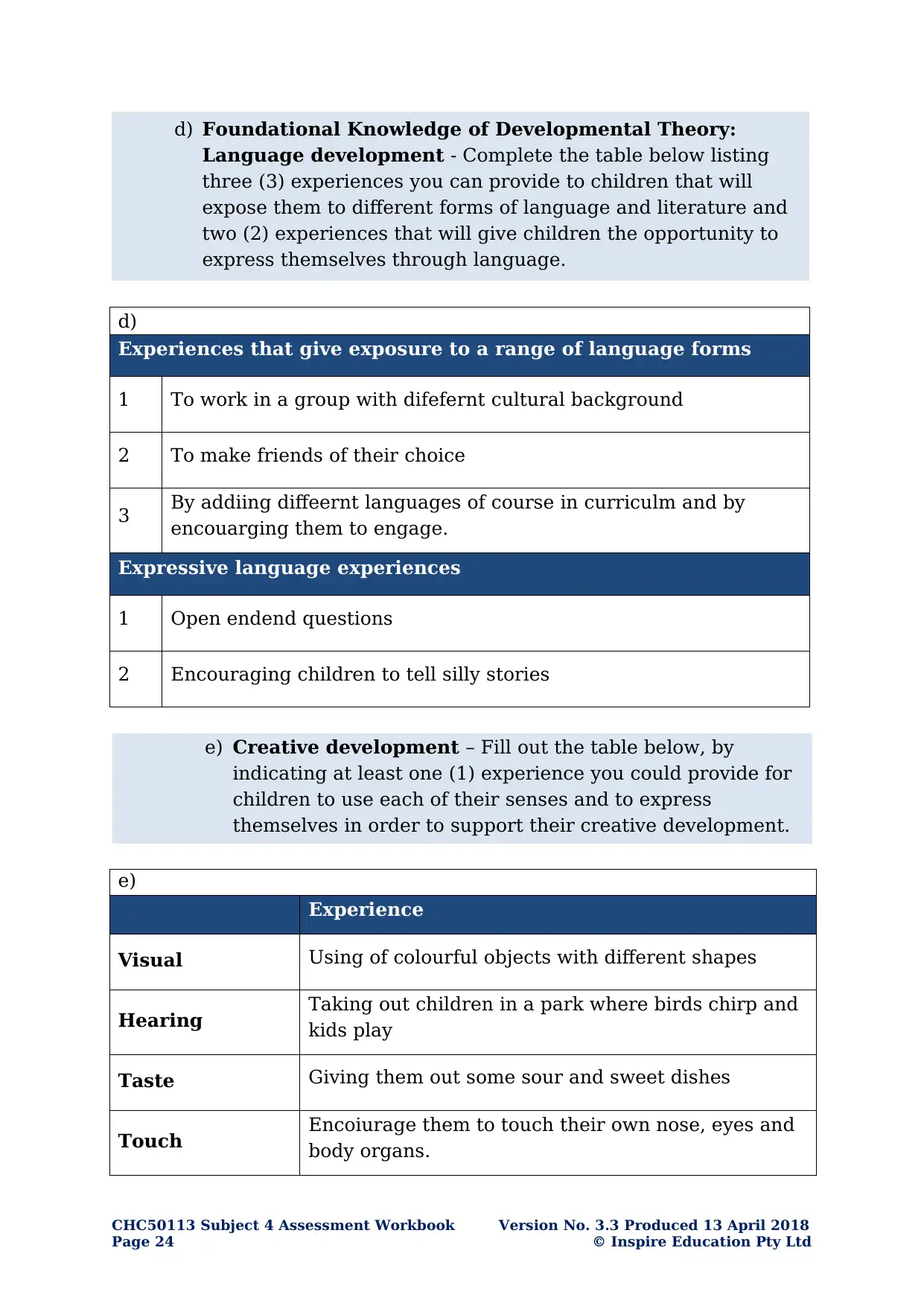
d) Foundational Knowledge of Developmental Theory:
Language development - Complete the table below listing
three (3) experiences you can provide to children that will
expose them to different forms of language and literature and
two (2) experiences that will give children the opportunity to
express themselves through language.
d)
Experiences that give exposure to a range of language forms
1 To work in a group with difefernt cultural background
2 To make friends of their choice
3 By addiing diffeernt languages of course in curriculm and by
encouarging them to engage.
Expressive language experiences
1 Open endend questions
2 Encouraging children to tell silly stories
e) Creative development – Fill out the table below, by
indicating at least one (1) experience you could provide for
children to use each of their senses and to express
themselves in order to support their creative development.
e)
Experience
Visual Using of colourful objects with different shapes
Hearing Taking out children in a park where birds chirp and
kids play
Taste Giving them out some sour and sweet dishes
Touch Encoiurage them to touch their own nose, eyes and
body organs.
CHC50113 Subject 4 Assessment Workbook Version No. 3.3 Produced 13 April 2018
Page 24 © Inspire Education Pty Ltd
Language development - Complete the table below listing
three (3) experiences you can provide to children that will
expose them to different forms of language and literature and
two (2) experiences that will give children the opportunity to
express themselves through language.
d)
Experiences that give exposure to a range of language forms
1 To work in a group with difefernt cultural background
2 To make friends of their choice
3 By addiing diffeernt languages of course in curriculm and by
encouarging them to engage.
Expressive language experiences
1 Open endend questions
2 Encouraging children to tell silly stories
e) Creative development – Fill out the table below, by
indicating at least one (1) experience you could provide for
children to use each of their senses and to express
themselves in order to support their creative development.
e)
Experience
Visual Using of colourful objects with different shapes
Hearing Taking out children in a park where birds chirp and
kids play
Taste Giving them out some sour and sweet dishes
Touch Encoiurage them to touch their own nose, eyes and
body organs.
CHC50113 Subject 4 Assessment Workbook Version No. 3.3 Produced 13 April 2018
Page 24 © Inspire Education Pty Ltd
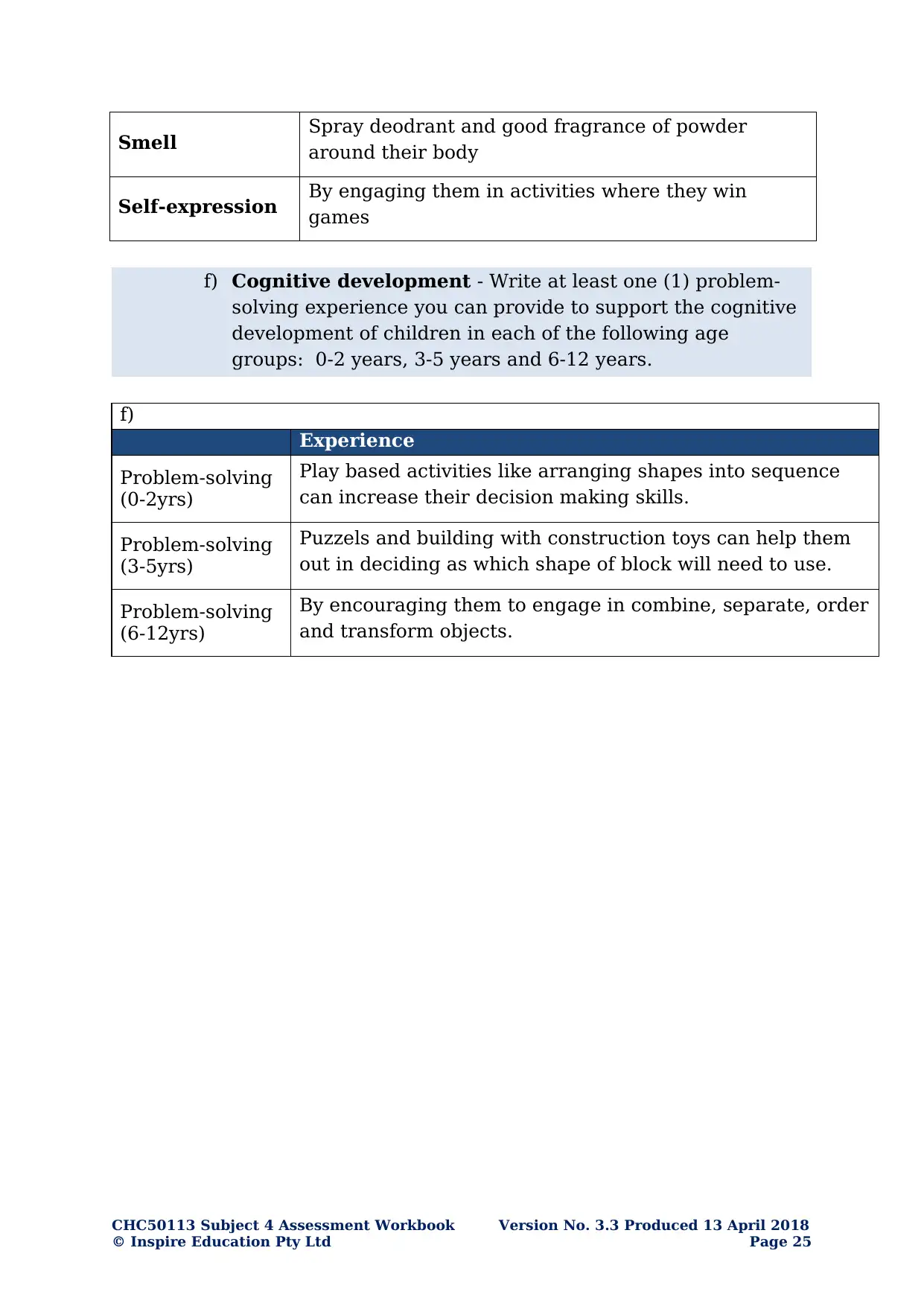
Smell Spray deodrant and good fragrance of powder
around their body
Self-expression By engaging them in activities where they win
games
f) Cognitive development - Write at least one (1) problem-
solving experience you can provide to support the cognitive
development of children in each of the following age
groups: 0-2 years, 3-5 years and 6-12 years.
f)
Experience
Problem-solving
(0-2yrs)
Play based activities like arranging shapes into sequence
can increase their decision making skills.
Problem-solving
(3-5yrs)
Puzzels and building with construction toys can help them
out in deciding as which shape of block will need to use.
Problem-solving
(6-12yrs)
By encouraging them to engage in combine, separate, order
and transform objects.
CHC50113 Subject 4 Assessment Workbook Version No. 3.3 Produced 13 April 2018
© Inspire Education Pty Ltd Page 25
around their body
Self-expression By engaging them in activities where they win
games
f) Cognitive development - Write at least one (1) problem-
solving experience you can provide to support the cognitive
development of children in each of the following age
groups: 0-2 years, 3-5 years and 6-12 years.
f)
Experience
Problem-solving
(0-2yrs)
Play based activities like arranging shapes into sequence
can increase their decision making skills.
Problem-solving
(3-5yrs)
Puzzels and building with construction toys can help them
out in deciding as which shape of block will need to use.
Problem-solving
(6-12yrs)
By encouraging them to engage in combine, separate, order
and transform objects.
CHC50113 Subject 4 Assessment Workbook Version No. 3.3 Produced 13 April 2018
© Inspire Education Pty Ltd Page 25
Paraphrase This Document
Need a fresh take? Get an instant paraphrase of this document with our AI Paraphraser
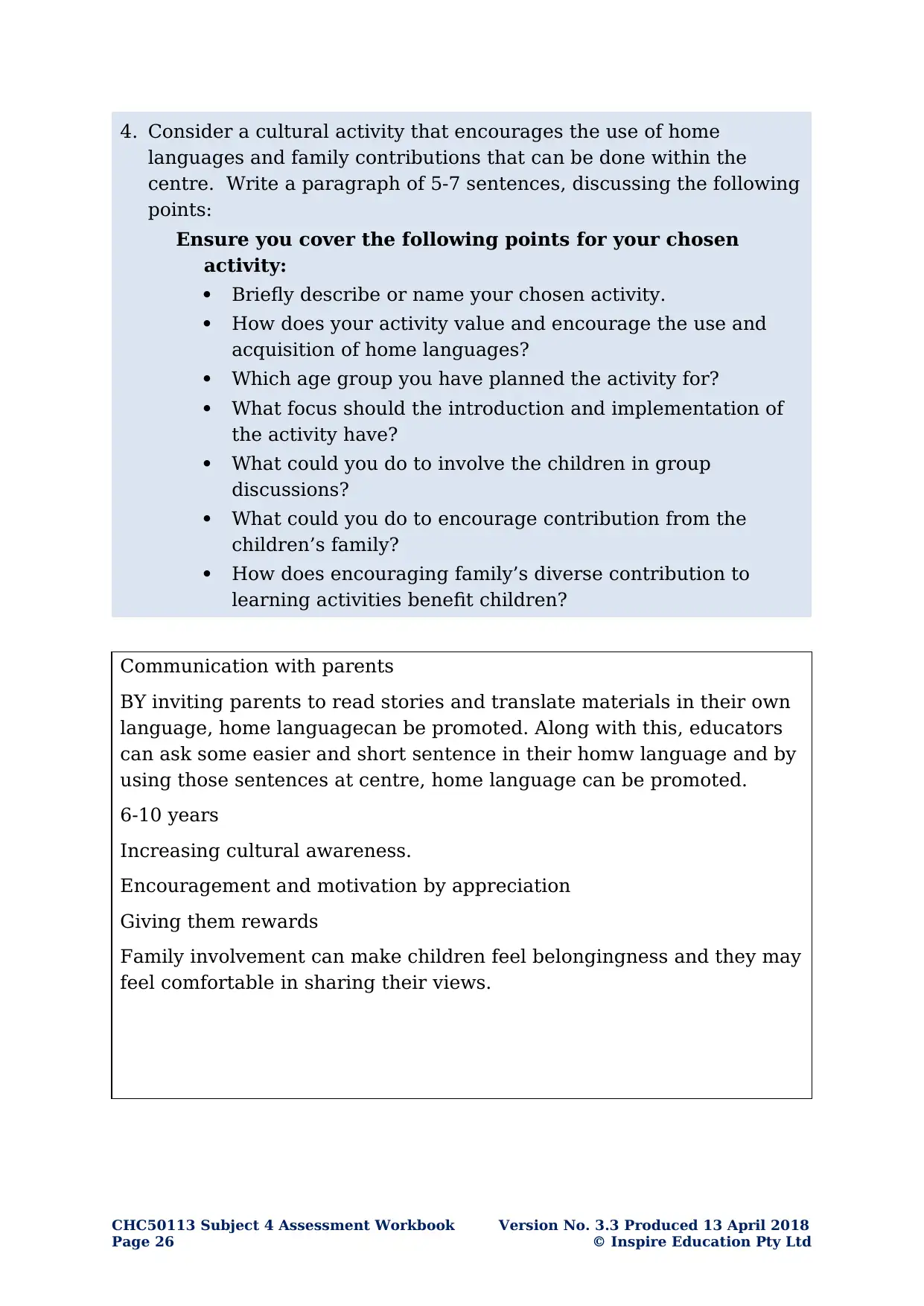
4. Consider a cultural activity that encourages the use of home
languages and family contributions that can be done within the
centre. Write a paragraph of 5-7 sentences, discussing the following
points:
Ensure you cover the following points for your chosen
activity:
Briefly describe or name your chosen activity.
How does your activity value and encourage the use and
acquisition of home languages?
Which age group you have planned the activity for?
What focus should the introduction and implementation of
the activity have?
What could you do to involve the children in group
discussions?
What could you do to encourage contribution from the
children’s family?
How does encouraging family’s diverse contribution to
learning activities benefit children?
Communication with parents
BY inviting parents to read stories and translate materials in their own
language, home languagecan be promoted. Along with this, educators
can ask some easier and short sentence in their homw language and by
using those sentences at centre, home language can be promoted.
6-10 years
Increasing cultural awareness.
Encouragement and motivation by appreciation
Giving them rewards
Family involvement can make children feel belongingness and they may
feel comfortable in sharing their views.
CHC50113 Subject 4 Assessment Workbook Version No. 3.3 Produced 13 April 2018
Page 26 © Inspire Education Pty Ltd
languages and family contributions that can be done within the
centre. Write a paragraph of 5-7 sentences, discussing the following
points:
Ensure you cover the following points for your chosen
activity:
Briefly describe or name your chosen activity.
How does your activity value and encourage the use and
acquisition of home languages?
Which age group you have planned the activity for?
What focus should the introduction and implementation of
the activity have?
What could you do to involve the children in group
discussions?
What could you do to encourage contribution from the
children’s family?
How does encouraging family’s diverse contribution to
learning activities benefit children?
Communication with parents
BY inviting parents to read stories and translate materials in their own
language, home languagecan be promoted. Along with this, educators
can ask some easier and short sentence in their homw language and by
using those sentences at centre, home language can be promoted.
6-10 years
Increasing cultural awareness.
Encouragement and motivation by appreciation
Giving them rewards
Family involvement can make children feel belongingness and they may
feel comfortable in sharing their views.
CHC50113 Subject 4 Assessment Workbook Version No. 3.3 Produced 13 April 2018
Page 26 © Inspire Education Pty Ltd
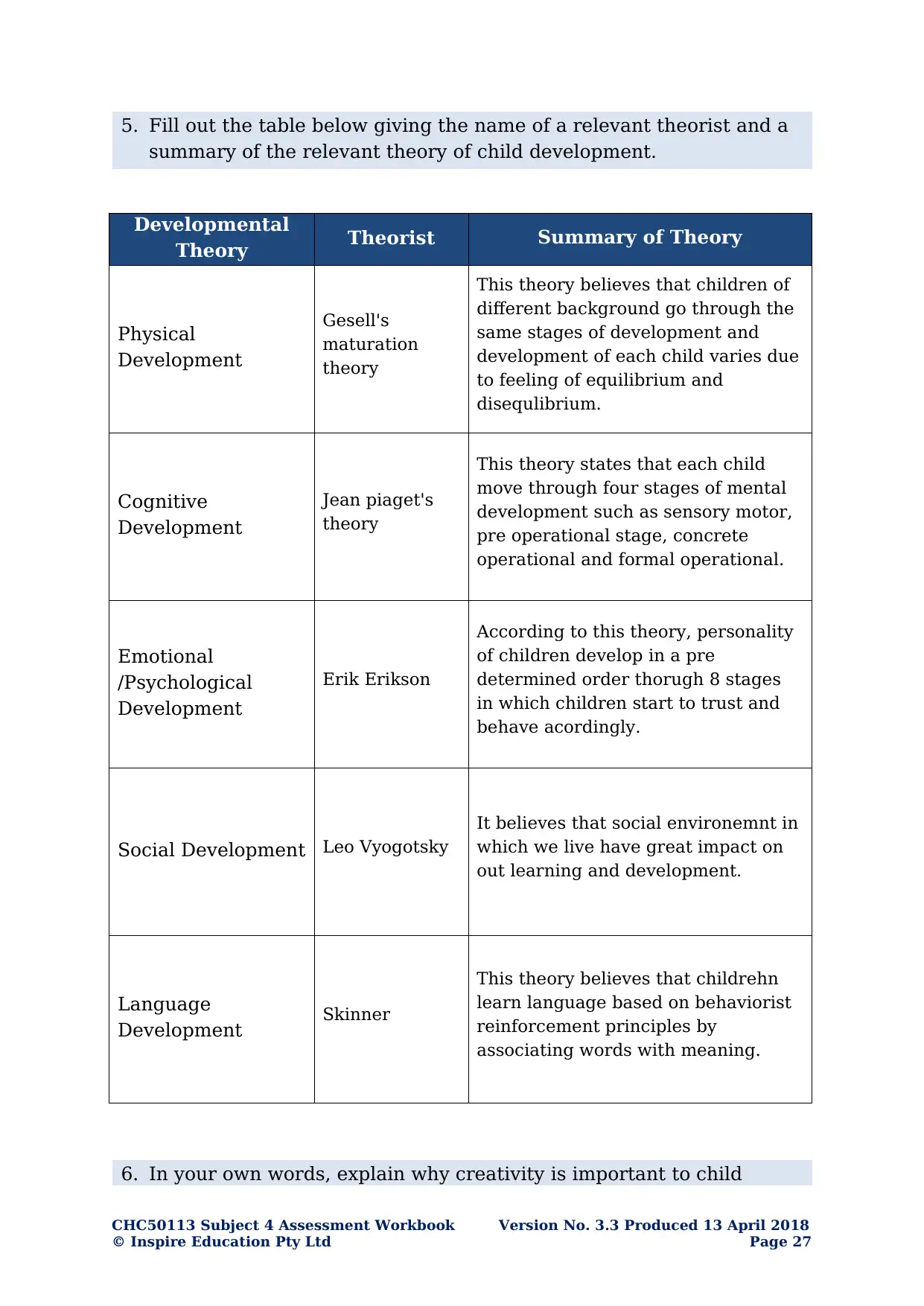
5. Fill out the table below giving the name of a relevant theorist and a
summary of the relevant theory of child development.
Developmental
Theory Theorist Summary of Theory
Physical
Development
Gesell's
maturation
theory
This theory believes that children of
different background go through the
same stages of development and
development of each child varies due
to feeling of equilibrium and
disequlibrium.
Cognitive
Development
Jean piaget's
theory
This theory states that each child
move through four stages of mental
development such as sensory motor,
pre operational stage, concrete
operational and formal operational.
Emotional
/Psychological
Development
Erik Erikson
According to this theory, personality
of children develop in a pre
determined order thorugh 8 stages
in which children start to trust and
behave acordingly.
Social Development Leo Vyogotsky
It believes that social environemnt in
which we live have great impact on
out learning and development.
Language
Development Skinner
This theory believes that childrehn
learn language based on behaviorist
reinforcement principles by
associating words with meaning.
6. In your own words, explain why creativity is important to child
CHC50113 Subject 4 Assessment Workbook Version No. 3.3 Produced 13 April 2018
© Inspire Education Pty Ltd Page 27
summary of the relevant theory of child development.
Developmental
Theory Theorist Summary of Theory
Physical
Development
Gesell's
maturation
theory
This theory believes that children of
different background go through the
same stages of development and
development of each child varies due
to feeling of equilibrium and
disequlibrium.
Cognitive
Development
Jean piaget's
theory
This theory states that each child
move through four stages of mental
development such as sensory motor,
pre operational stage, concrete
operational and formal operational.
Emotional
/Psychological
Development
Erik Erikson
According to this theory, personality
of children develop in a pre
determined order thorugh 8 stages
in which children start to trust and
behave acordingly.
Social Development Leo Vyogotsky
It believes that social environemnt in
which we live have great impact on
out learning and development.
Language
Development Skinner
This theory believes that childrehn
learn language based on behaviorist
reinforcement principles by
associating words with meaning.
6. In your own words, explain why creativity is important to child
CHC50113 Subject 4 Assessment Workbook Version No. 3.3 Produced 13 April 2018
© Inspire Education Pty Ltd Page 27
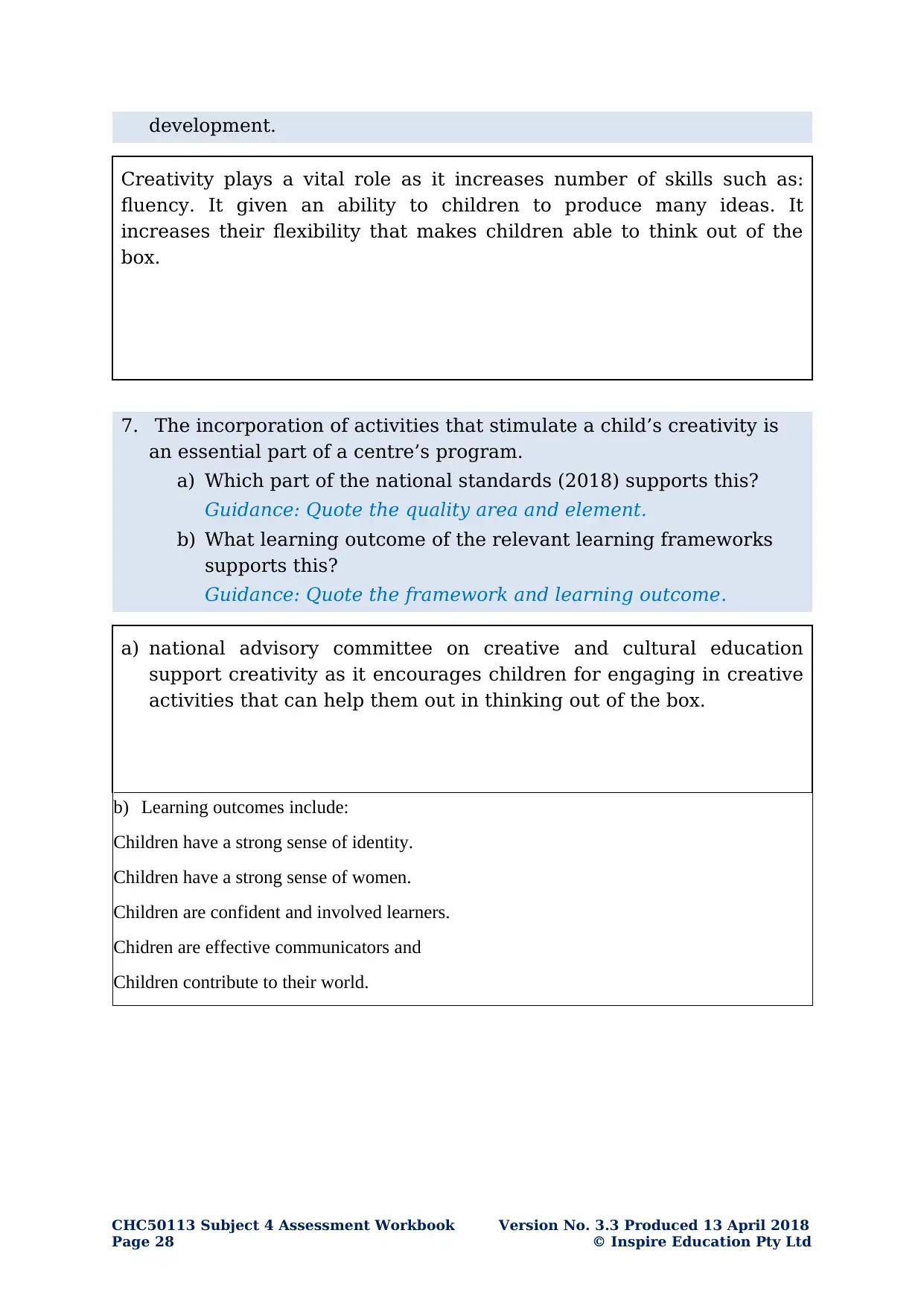
development.
Creativity plays a vital role as it increases number of skills such as:
fluency. It given an ability to children to produce many ideas. It
increases their flexibility that makes children able to think out of the
box.
7. The incorporation of activities that stimulate a child’s creativity is
an essential part of a centre’s program.
a) Which part of the national standards (2018) supports this?
Guidance: Quote the quality area and element.
b) What learning outcome of the relevant learning frameworks
supports this?
Guidance: Quote the framework and learning outcome.
a) national advisory committee on creative and cultural education
support creativity as it encourages children for engaging in creative
activities that can help them out in thinking out of the box.
b) Learning outcomes include:
Children have a strong sense of identity.
Children have a strong sense of women.
Children are confident and involved learners.
Chidren are effective communicators and
Children contribute to their world.
CHC50113 Subject 4 Assessment Workbook Version No. 3.3 Produced 13 April 2018
Page 28 © Inspire Education Pty Ltd
Creativity plays a vital role as it increases number of skills such as:
fluency. It given an ability to children to produce many ideas. It
increases their flexibility that makes children able to think out of the
box.
7. The incorporation of activities that stimulate a child’s creativity is
an essential part of a centre’s program.
a) Which part of the national standards (2018) supports this?
Guidance: Quote the quality area and element.
b) What learning outcome of the relevant learning frameworks
supports this?
Guidance: Quote the framework and learning outcome.
a) national advisory committee on creative and cultural education
support creativity as it encourages children for engaging in creative
activities that can help them out in thinking out of the box.
b) Learning outcomes include:
Children have a strong sense of identity.
Children have a strong sense of women.
Children are confident and involved learners.
Chidren are effective communicators and
Children contribute to their world.
CHC50113 Subject 4 Assessment Workbook Version No. 3.3 Produced 13 April 2018
Page 28 © Inspire Education Pty Ltd
Secure Best Marks with AI Grader
Need help grading? Try our AI Grader for instant feedback on your assignments.
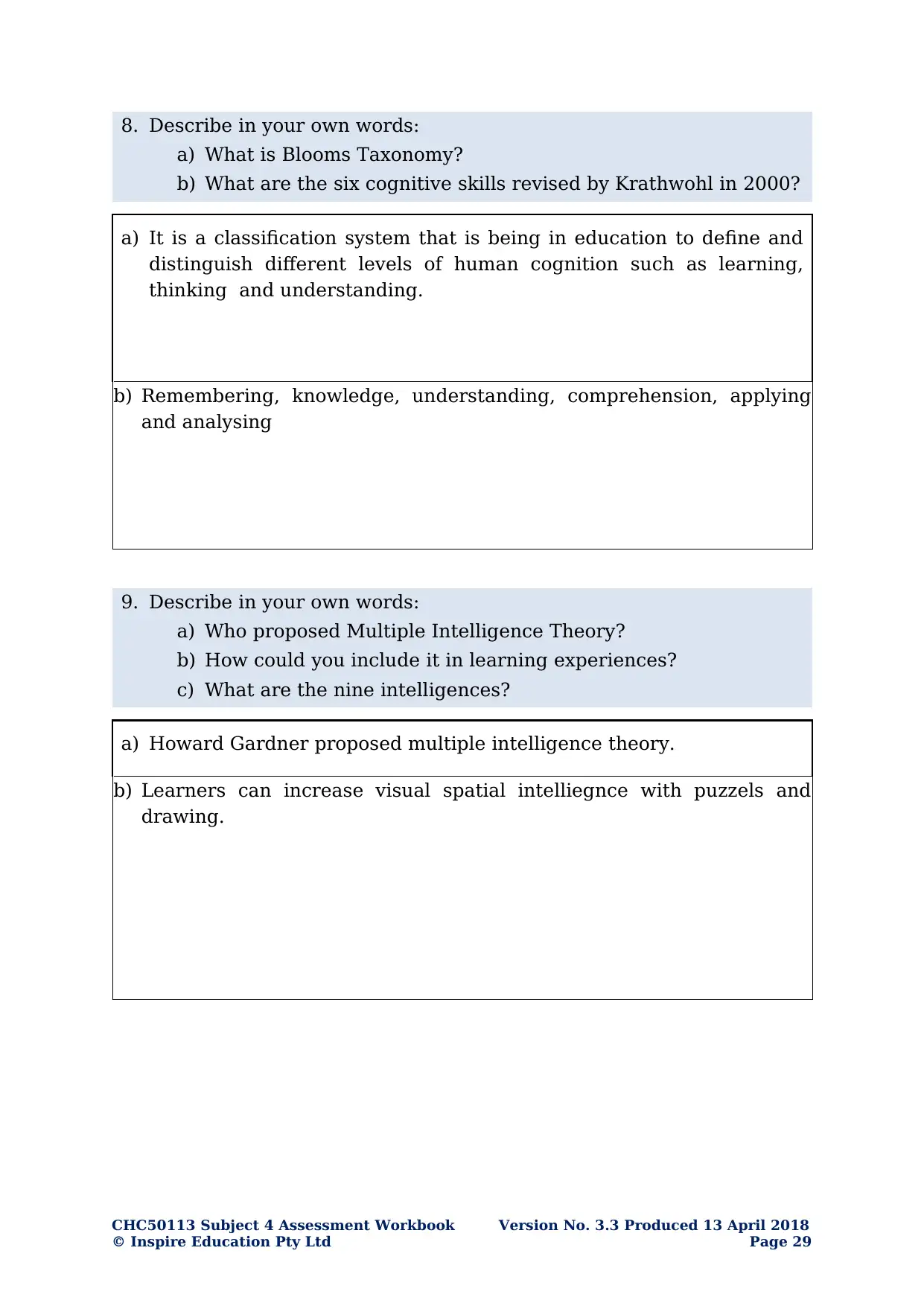
8. Describe in your own words:
a) What is Blooms Taxonomy?
b) What are the six cognitive skills revised by Krathwohl in 2000?
a) It is a classification system that is being in education to define and
distinguish different levels of human cognition such as learning,
thinking and understanding.
b) Remembering, knowledge, understanding, comprehension, applying
and analysing
9. Describe in your own words:
a) Who proposed Multiple Intelligence Theory?
b) How could you include it in learning experiences?
c) What are the nine intelligences?
a) Howard Gardner proposed multiple intelligence theory.
b) Learners can increase visual spatial intelliegnce with puzzels and
drawing.
CHC50113 Subject 4 Assessment Workbook Version No. 3.3 Produced 13 April 2018
© Inspire Education Pty Ltd Page 29
a) What is Blooms Taxonomy?
b) What are the six cognitive skills revised by Krathwohl in 2000?
a) It is a classification system that is being in education to define and
distinguish different levels of human cognition such as learning,
thinking and understanding.
b) Remembering, knowledge, understanding, comprehension, applying
and analysing
9. Describe in your own words:
a) Who proposed Multiple Intelligence Theory?
b) How could you include it in learning experiences?
c) What are the nine intelligences?
a) Howard Gardner proposed multiple intelligence theory.
b) Learners can increase visual spatial intelliegnce with puzzels and
drawing.
CHC50113 Subject 4 Assessment Workbook Version No. 3.3 Produced 13 April 2018
© Inspire Education Pty Ltd Page 29
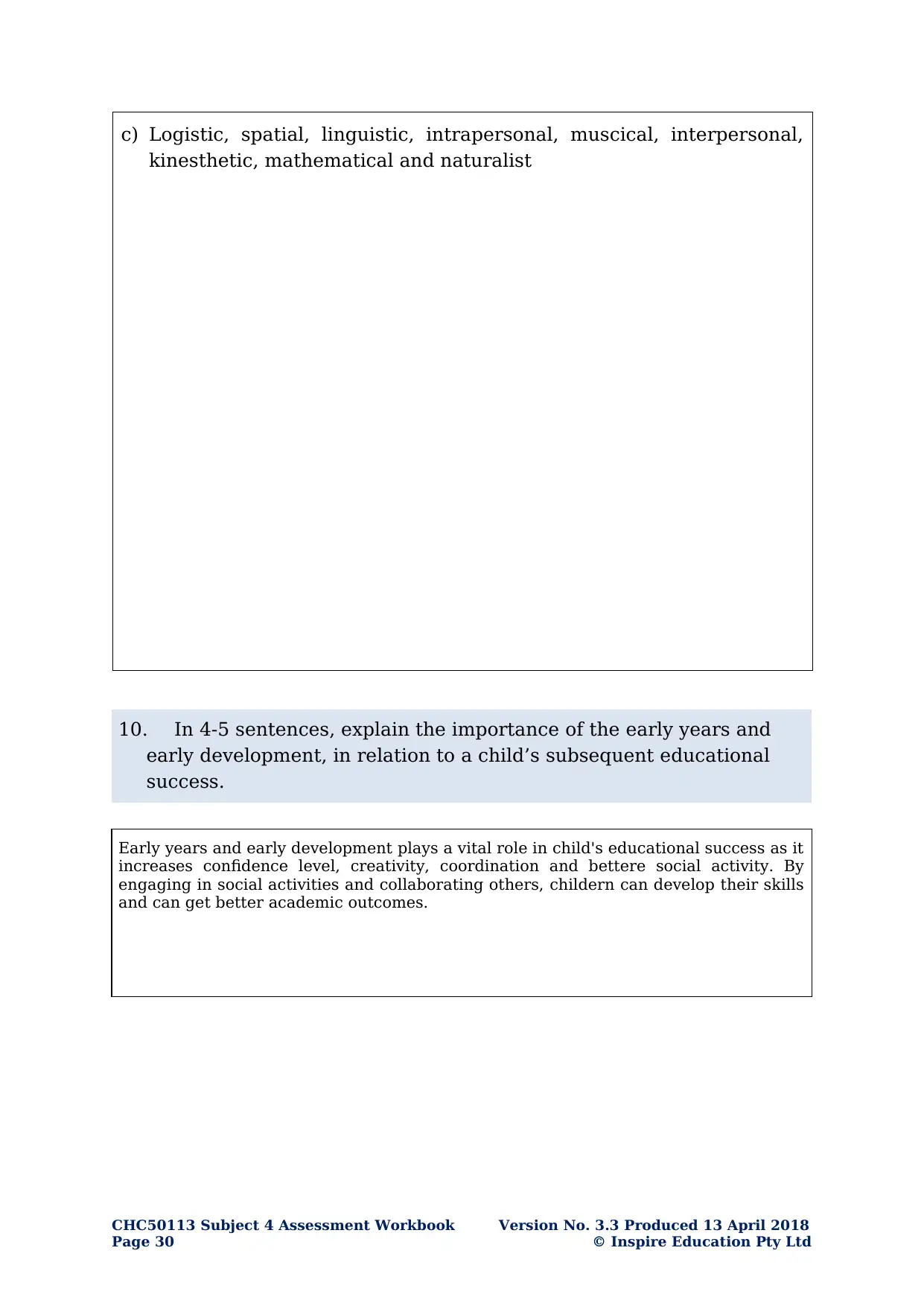
c) Logistic, spatial, linguistic, intrapersonal, muscical, interpersonal,
kinesthetic, mathematical and naturalist
10. In 4-5 sentences, explain the importance of the early years and
early development, in relation to a child’s subsequent educational
success.
Early years and early development plays a vital role in child's educational success as it
increases confidence level, creativity, coordination and bettere social activity. By
engaging in social activities and collaborating others, childern can develop their skills
and can get better academic outcomes.
CHC50113 Subject 4 Assessment Workbook Version No. 3.3 Produced 13 April 2018
Page 30 © Inspire Education Pty Ltd
kinesthetic, mathematical and naturalist
10. In 4-5 sentences, explain the importance of the early years and
early development, in relation to a child’s subsequent educational
success.
Early years and early development plays a vital role in child's educational success as it
increases confidence level, creativity, coordination and bettere social activity. By
engaging in social activities and collaborating others, childern can develop their skills
and can get better academic outcomes.
CHC50113 Subject 4 Assessment Workbook Version No. 3.3 Produced 13 April 2018
Page 30 © Inspire Education Pty Ltd
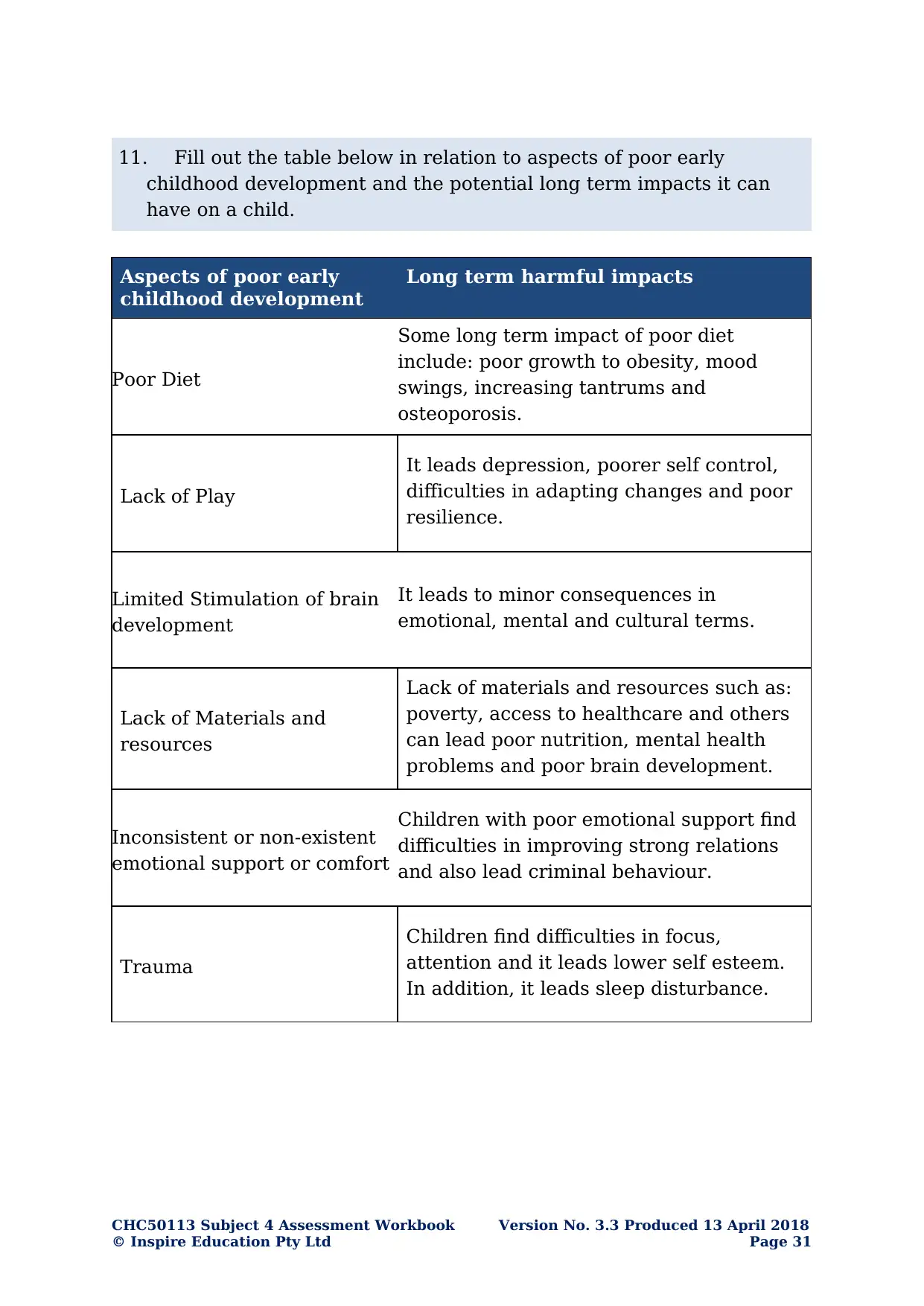
11. Fill out the table below in relation to aspects of poor early
childhood development and the potential long term impacts it can
have on a child.
Aspects of poor early
childhood development
Long term harmful impacts
Poor Diet
Some long term impact of poor diet
include: poor growth to obesity, mood
swings, increasing tantrums and
osteoporosis.
Lack of Play
It leads depression, poorer self control,
difficulties in adapting changes and poor
resilience.
Limited Stimulation of brain
development
It leads to minor consequences in
emotional, mental and cultural terms.
Lack of Materials and
resources
Lack of materials and resources such as:
poverty, access to healthcare and others
can lead poor nutrition, mental health
problems and poor brain development.
Inconsistent or non-existent
emotional support or comfort
Children with poor emotional support find
difficulties in improving strong relations
and also lead criminal behaviour.
Trauma
Children find difficulties in focus,
attention and it leads lower self esteem.
In addition, it leads sleep disturbance.
CHC50113 Subject 4 Assessment Workbook Version No. 3.3 Produced 13 April 2018
© Inspire Education Pty Ltd Page 31
childhood development and the potential long term impacts it can
have on a child.
Aspects of poor early
childhood development
Long term harmful impacts
Poor Diet
Some long term impact of poor diet
include: poor growth to obesity, mood
swings, increasing tantrums and
osteoporosis.
Lack of Play
It leads depression, poorer self control,
difficulties in adapting changes and poor
resilience.
Limited Stimulation of brain
development
It leads to minor consequences in
emotional, mental and cultural terms.
Lack of Materials and
resources
Lack of materials and resources such as:
poverty, access to healthcare and others
can lead poor nutrition, mental health
problems and poor brain development.
Inconsistent or non-existent
emotional support or comfort
Children with poor emotional support find
difficulties in improving strong relations
and also lead criminal behaviour.
Trauma
Children find difficulties in focus,
attention and it leads lower self esteem.
In addition, it leads sleep disturbance.
CHC50113 Subject 4 Assessment Workbook Version No. 3.3 Produced 13 April 2018
© Inspire Education Pty Ltd Page 31
Paraphrase This Document
Need a fresh take? Get an instant paraphrase of this document with our AI Paraphraser
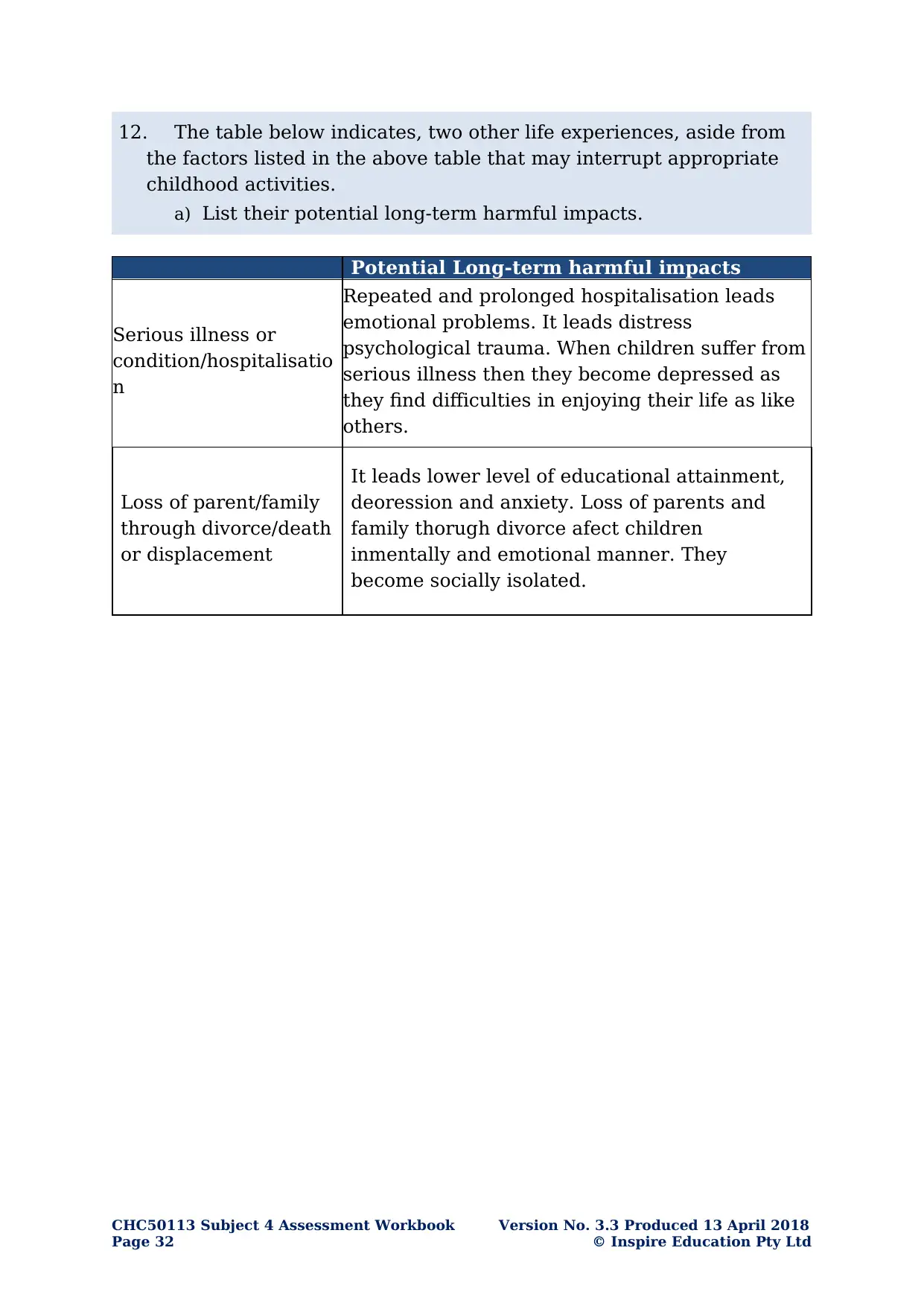
12. The table below indicates, two other life experiences, aside from
the factors listed in the above table that may interrupt appropriate
childhood activities.
a) List their potential long-term harmful impacts.
Potential Long-term harmful impacts
Serious illness or
condition/hospitalisatio
n
Repeated and prolonged hospitalisation leads
emotional problems. It leads distress
psychological trauma. When children suffer from
serious illness then they become depressed as
they find difficulties in enjoying their life as like
others.
Loss of parent/family
through divorce/death
or displacement
It leads lower level of educational attainment,
deoression and anxiety. Loss of parents and
family thorugh divorce afect children
inmentally and emotional manner. They
become socially isolated.
CHC50113 Subject 4 Assessment Workbook Version No. 3.3 Produced 13 April 2018
Page 32 © Inspire Education Pty Ltd
the factors listed in the above table that may interrupt appropriate
childhood activities.
a) List their potential long-term harmful impacts.
Potential Long-term harmful impacts
Serious illness or
condition/hospitalisatio
n
Repeated and prolonged hospitalisation leads
emotional problems. It leads distress
psychological trauma. When children suffer from
serious illness then they become depressed as
they find difficulties in enjoying their life as like
others.
Loss of parent/family
through divorce/death
or displacement
It leads lower level of educational attainment,
deoression and anxiety. Loss of parents and
family thorugh divorce afect children
inmentally and emotional manner. They
become socially isolated.
CHC50113 Subject 4 Assessment Workbook Version No. 3.3 Produced 13 April 2018
Page 32 © Inspire Education Pty Ltd
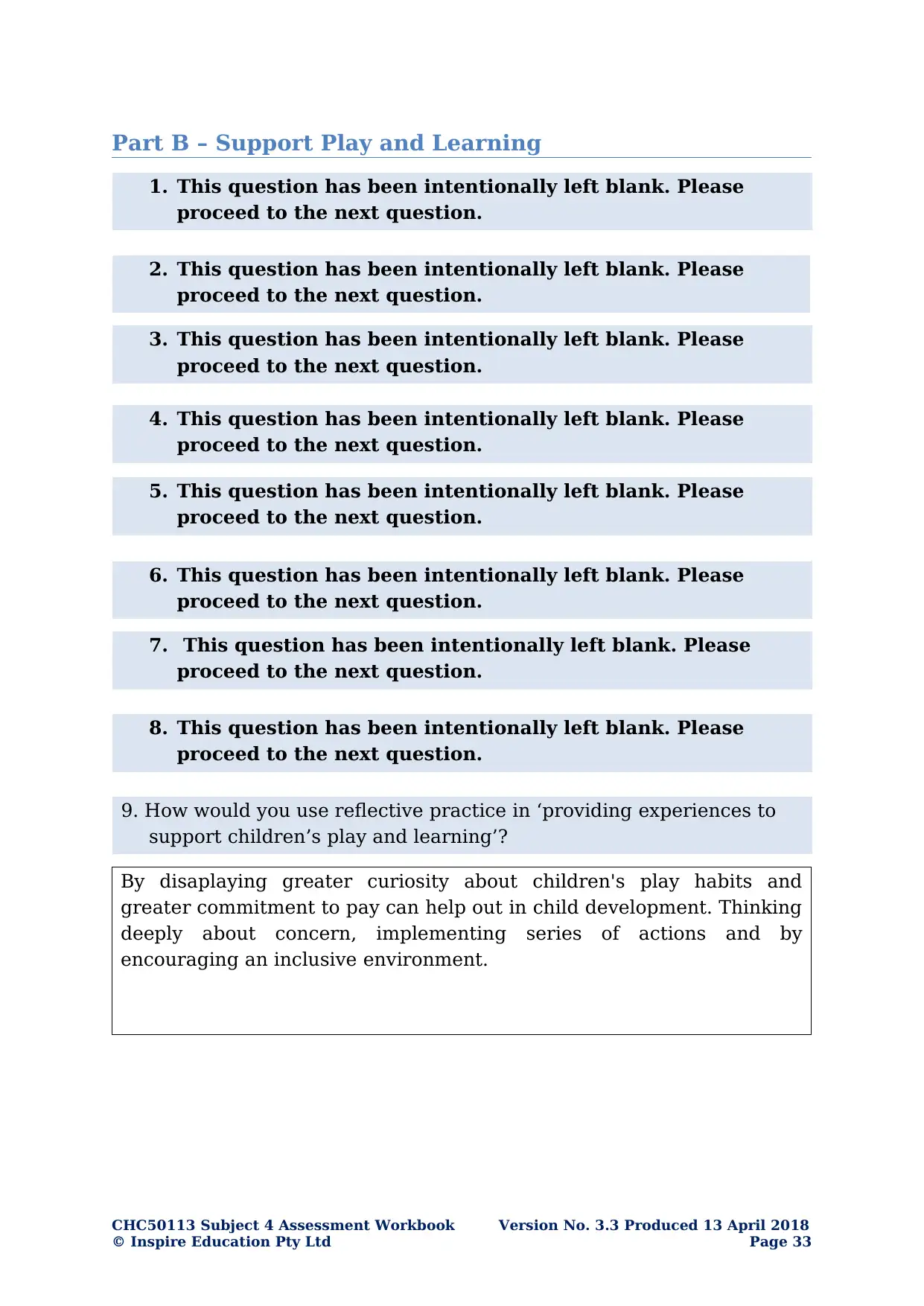
Part B – Support Play and Learning
1. This question has been intentionally left blank. Please
proceed to the next question.
2. This question has been intentionally left blank. Please
proceed to the next question.
3. This question has been intentionally left blank. Please
proceed to the next question.
4. This question has been intentionally left blank. Please
proceed to the next question.
5. This question has been intentionally left blank. Please
proceed to the next question.
6. This question has been intentionally left blank. Please
proceed to the next question.
7. This question has been intentionally left blank. Please
proceed to the next question.
8. This question has been intentionally left blank. Please
proceed to the next question.
9. How would you use reflective practice in ‘providing experiences to
support children’s play and learning’?
By disaplaying greater curiosity about children's play habits and
greater commitment to pay can help out in child development. Thinking
deeply about concern, implementing series of actions and by
encouraging an inclusive environment.
CHC50113 Subject 4 Assessment Workbook Version No. 3.3 Produced 13 April 2018
© Inspire Education Pty Ltd Page 33
1. This question has been intentionally left blank. Please
proceed to the next question.
2. This question has been intentionally left blank. Please
proceed to the next question.
3. This question has been intentionally left blank. Please
proceed to the next question.
4. This question has been intentionally left blank. Please
proceed to the next question.
5. This question has been intentionally left blank. Please
proceed to the next question.
6. This question has been intentionally left blank. Please
proceed to the next question.
7. This question has been intentionally left blank. Please
proceed to the next question.
8. This question has been intentionally left blank. Please
proceed to the next question.
9. How would you use reflective practice in ‘providing experiences to
support children’s play and learning’?
By disaplaying greater curiosity about children's play habits and
greater commitment to pay can help out in child development. Thinking
deeply about concern, implementing series of actions and by
encouraging an inclusive environment.
CHC50113 Subject 4 Assessment Workbook Version No. 3.3 Produced 13 April 2018
© Inspire Education Pty Ltd Page 33
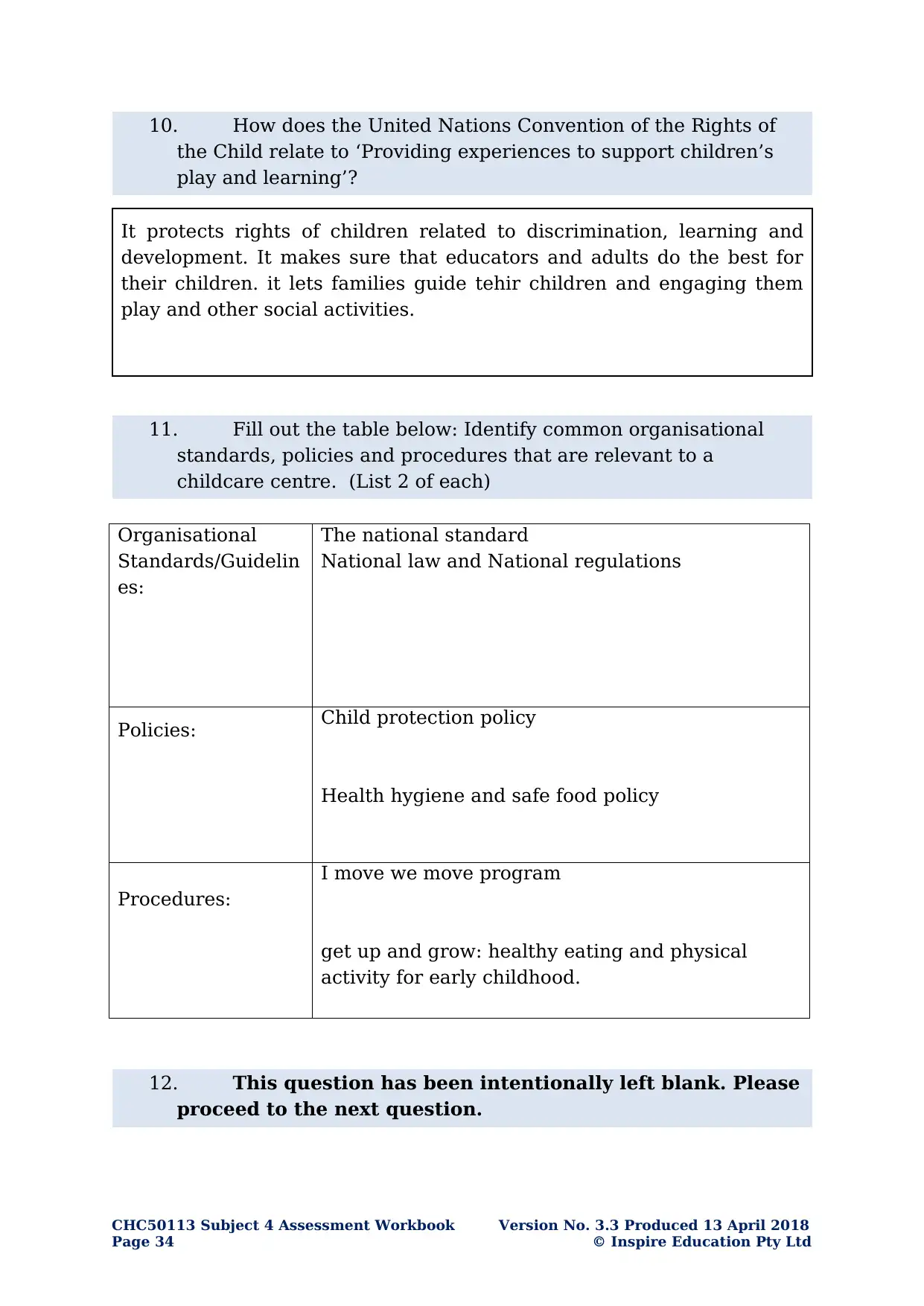
10. How does the United Nations Convention of the Rights of
the Child relate to ‘Providing experiences to support children’s
play and learning’?
It protects rights of children related to discrimination, learning and
development. It makes sure that educators and adults do the best for
their children. it lets families guide tehir children and engaging them
play and other social activities.
11. Fill out the table below: Identify common organisational
standards, policies and procedures that are relevant to a
childcare centre. (List 2 of each)
Organisational
Standards/Guidelin
es:
The national standard
National law and National regulations
Policies: Child protection policy
Health hygiene and safe food policy
Procedures:
I move we move program
get up and grow: healthy eating and physical
activity for early childhood.
12. This question has been intentionally left blank. Please
proceed to the next question.
CHC50113 Subject 4 Assessment Workbook Version No. 3.3 Produced 13 April 2018
Page 34 © Inspire Education Pty Ltd
the Child relate to ‘Providing experiences to support children’s
play and learning’?
It protects rights of children related to discrimination, learning and
development. It makes sure that educators and adults do the best for
their children. it lets families guide tehir children and engaging them
play and other social activities.
11. Fill out the table below: Identify common organisational
standards, policies and procedures that are relevant to a
childcare centre. (List 2 of each)
Organisational
Standards/Guidelin
es:
The national standard
National law and National regulations
Policies: Child protection policy
Health hygiene and safe food policy
Procedures:
I move we move program
get up and grow: healthy eating and physical
activity for early childhood.
12. This question has been intentionally left blank. Please
proceed to the next question.
CHC50113 Subject 4 Assessment Workbook Version No. 3.3 Produced 13 April 2018
Page 34 © Inspire Education Pty Ltd
Secure Best Marks with AI Grader
Need help grading? Try our AI Grader for instant feedback on your assignments.
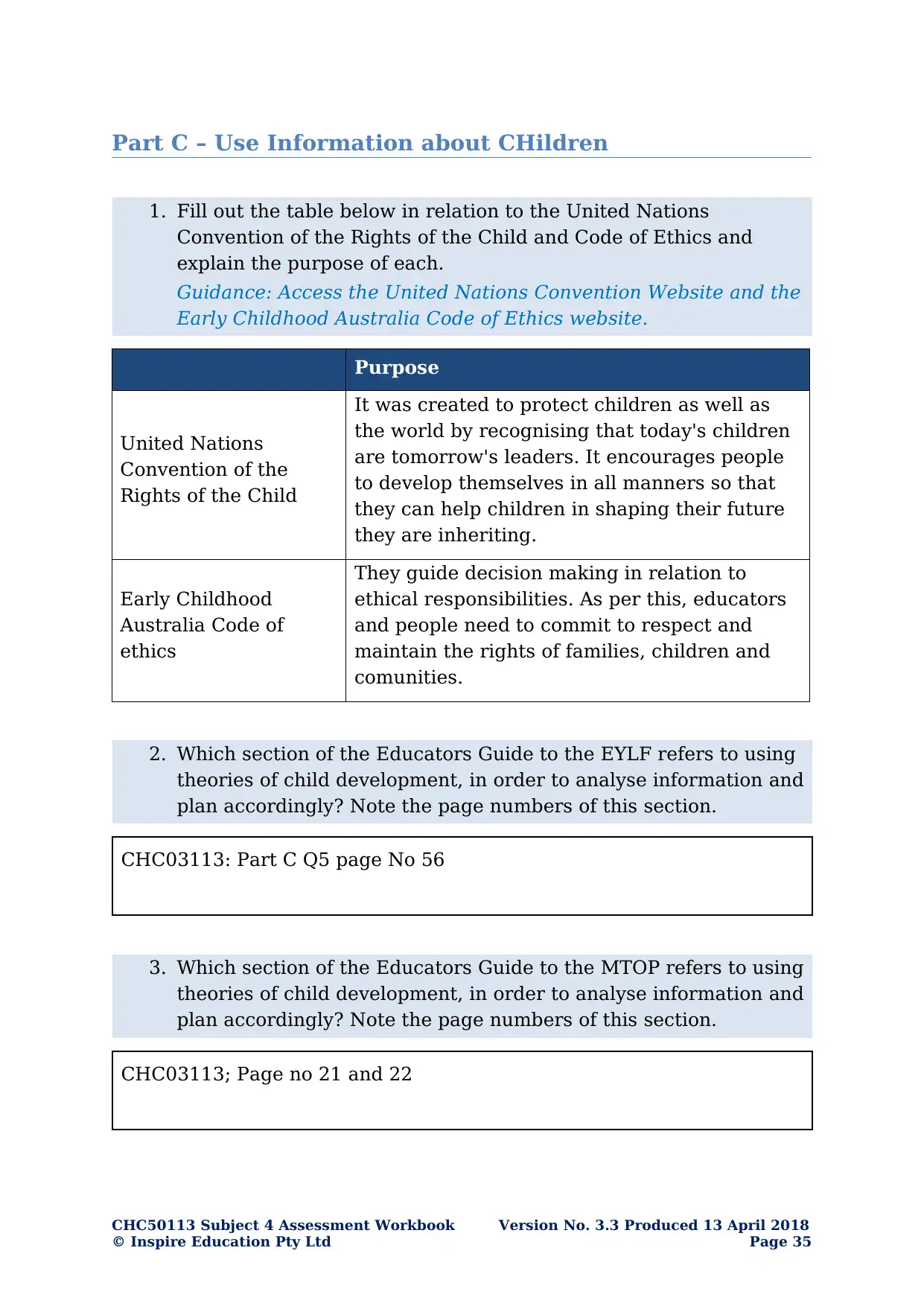
Part C – Use Information about CHildren
1. Fill out the table below in relation to the United Nations
Convention of the Rights of the Child and Code of Ethics and
explain the purpose of each.
Guidance: Access the United Nations Convention Website and the
Early Childhood Australia Code of Ethics website.
Purpose
United Nations
Convention of the
Rights of the Child
It was created to protect children as well as
the world by recognising that today's children
are tomorrow's leaders. It encourages people
to develop themselves in all manners so that
they can help children in shaping their future
they are inheriting.
Early Childhood
Australia Code of
ethics
They guide decision making in relation to
ethical responsibilities. As per this, educators
and people need to commit to respect and
maintain the rights of families, children and
comunities.
2. Which section of the Educators Guide to the EYLF refers to using
theories of child development, in order to analyse information and
plan accordingly? Note the page numbers of this section.
CHC03113: Part C Q5 page No 56
3. Which section of the Educators Guide to the MTOP refers to using
theories of child development, in order to analyse information and
plan accordingly? Note the page numbers of this section.
CHC03113; Page no 21 and 22
CHC50113 Subject 4 Assessment Workbook Version No. 3.3 Produced 13 April 2018
© Inspire Education Pty Ltd Page 35
1. Fill out the table below in relation to the United Nations
Convention of the Rights of the Child and Code of Ethics and
explain the purpose of each.
Guidance: Access the United Nations Convention Website and the
Early Childhood Australia Code of Ethics website.
Purpose
United Nations
Convention of the
Rights of the Child
It was created to protect children as well as
the world by recognising that today's children
are tomorrow's leaders. It encourages people
to develop themselves in all manners so that
they can help children in shaping their future
they are inheriting.
Early Childhood
Australia Code of
ethics
They guide decision making in relation to
ethical responsibilities. As per this, educators
and people need to commit to respect and
maintain the rights of families, children and
comunities.
2. Which section of the Educators Guide to the EYLF refers to using
theories of child development, in order to analyse information and
plan accordingly? Note the page numbers of this section.
CHC03113: Part C Q5 page No 56
3. Which section of the Educators Guide to the MTOP refers to using
theories of child development, in order to analyse information and
plan accordingly? Note the page numbers of this section.
CHC03113; Page no 21 and 22
CHC50113 Subject 4 Assessment Workbook Version No. 3.3 Produced 13 April 2018
© Inspire Education Pty Ltd Page 35

4. Describe in your own words how you can use observations on
child development and analyse a child’s information to assist in
planning?
By using an active listening skill and by listening to children,
behaviours can be developed. By creating an environment of social
activities and good habits and an open communication, children's
development can be done.
5. In the table below, provide a description of the following
observation techniques and outline what they are best used to
observe.
Observation Technique Description Best Use
Anecdotal Something based on
stories and retelling.
For changing behaviour
of childrenm recorded
anecdotal can be used.
Learning Stories Ley methods for
increasing knowledge of
children.
Writing, reading,
planning and
connecting to families.
Developmental
Checklist
An effective method to
identify child's
development in each
social domain.
By creating a
development profile for
child.
Event Sample An observation
technique
By usig ABC model such
as: by identifying
possible triggers,
behaviour and
consequences, event
samples can be
developed.
Running Record An assessment tool It is being used to know
score of word reading
accuracy and readers'
errors.
CHC50113 Subject 4 Assessment Workbook Version No. 3.3 Produced 13 April 2018
Page 36 © Inspire Education Pty Ltd
child development and analyse a child’s information to assist in
planning?
By using an active listening skill and by listening to children,
behaviours can be developed. By creating an environment of social
activities and good habits and an open communication, children's
development can be done.
5. In the table below, provide a description of the following
observation techniques and outline what they are best used to
observe.
Observation Technique Description Best Use
Anecdotal Something based on
stories and retelling.
For changing behaviour
of childrenm recorded
anecdotal can be used.
Learning Stories Ley methods for
increasing knowledge of
children.
Writing, reading,
planning and
connecting to families.
Developmental
Checklist
An effective method to
identify child's
development in each
social domain.
By creating a
development profile for
child.
Event Sample An observation
technique
By usig ABC model such
as: by identifying
possible triggers,
behaviour and
consequences, event
samples can be
developed.
Running Record An assessment tool It is being used to know
score of word reading
accuracy and readers'
errors.
CHC50113 Subject 4 Assessment Workbook Version No. 3.3 Produced 13 April 2018
Page 36 © Inspire Education Pty Ltd
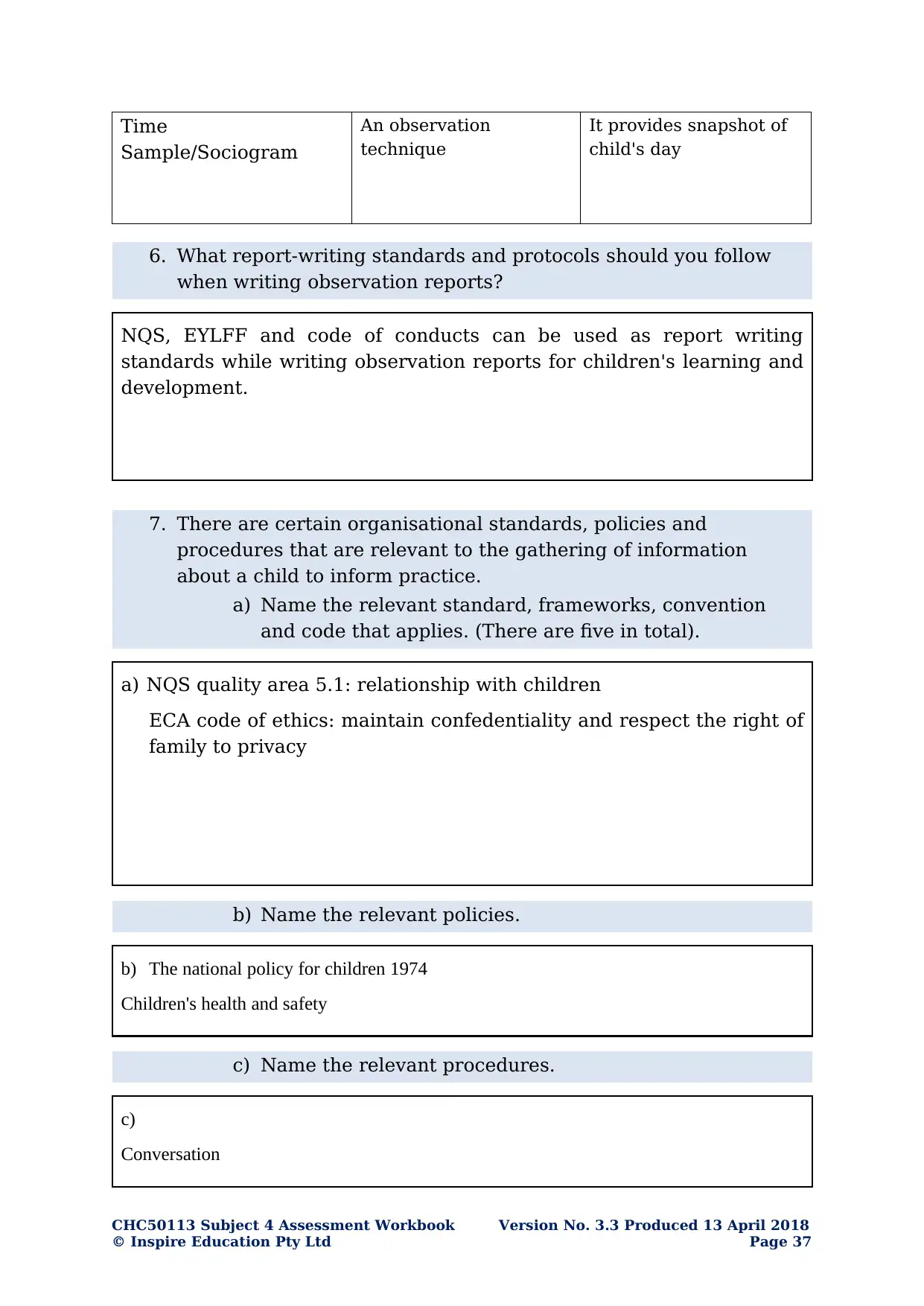
Time
Sample/Sociogram
An observation
technique
It provides snapshot of
child's day
6. What report-writing standards and protocols should you follow
when writing observation reports?
NQS, EYLFF and code of conducts can be used as report writing
standards while writing observation reports for children's learning and
development.
7. There are certain organisational standards, policies and
procedures that are relevant to the gathering of information
about a child to inform practice.
a) Name the relevant standard, frameworks, convention
and code that applies. (There are five in total).
a) NQS quality area 5.1: relationship with children
ECA code of ethics: maintain confedentiality and respect the right of
family to privacy
b) Name the relevant policies.
b) The national policy for children 1974
Children's health and safety
c) Name the relevant procedures.
c)
Conversation
CHC50113 Subject 4 Assessment Workbook Version No. 3.3 Produced 13 April 2018
© Inspire Education Pty Ltd Page 37
Sample/Sociogram
An observation
technique
It provides snapshot of
child's day
6. What report-writing standards and protocols should you follow
when writing observation reports?
NQS, EYLFF and code of conducts can be used as report writing
standards while writing observation reports for children's learning and
development.
7. There are certain organisational standards, policies and
procedures that are relevant to the gathering of information
about a child to inform practice.
a) Name the relevant standard, frameworks, convention
and code that applies. (There are five in total).
a) NQS quality area 5.1: relationship with children
ECA code of ethics: maintain confedentiality and respect the right of
family to privacy
b) Name the relevant policies.
b) The national policy for children 1974
Children's health and safety
c) Name the relevant procedures.
c)
Conversation
CHC50113 Subject 4 Assessment Workbook Version No. 3.3 Produced 13 April 2018
© Inspire Education Pty Ltd Page 37
Paraphrase This Document
Need a fresh take? Get an instant paraphrase of this document with our AI Paraphraser

questionnaire
CHC50113 Subject 4 Assessment Workbook Version No. 3.3 Produced 13 April 2018
Page 38 © Inspire Education Pty Ltd
CHC50113 Subject 4 Assessment Workbook Version No. 3.3 Produced 13 April 2018
Page 38 © Inspire Education Pty Ltd
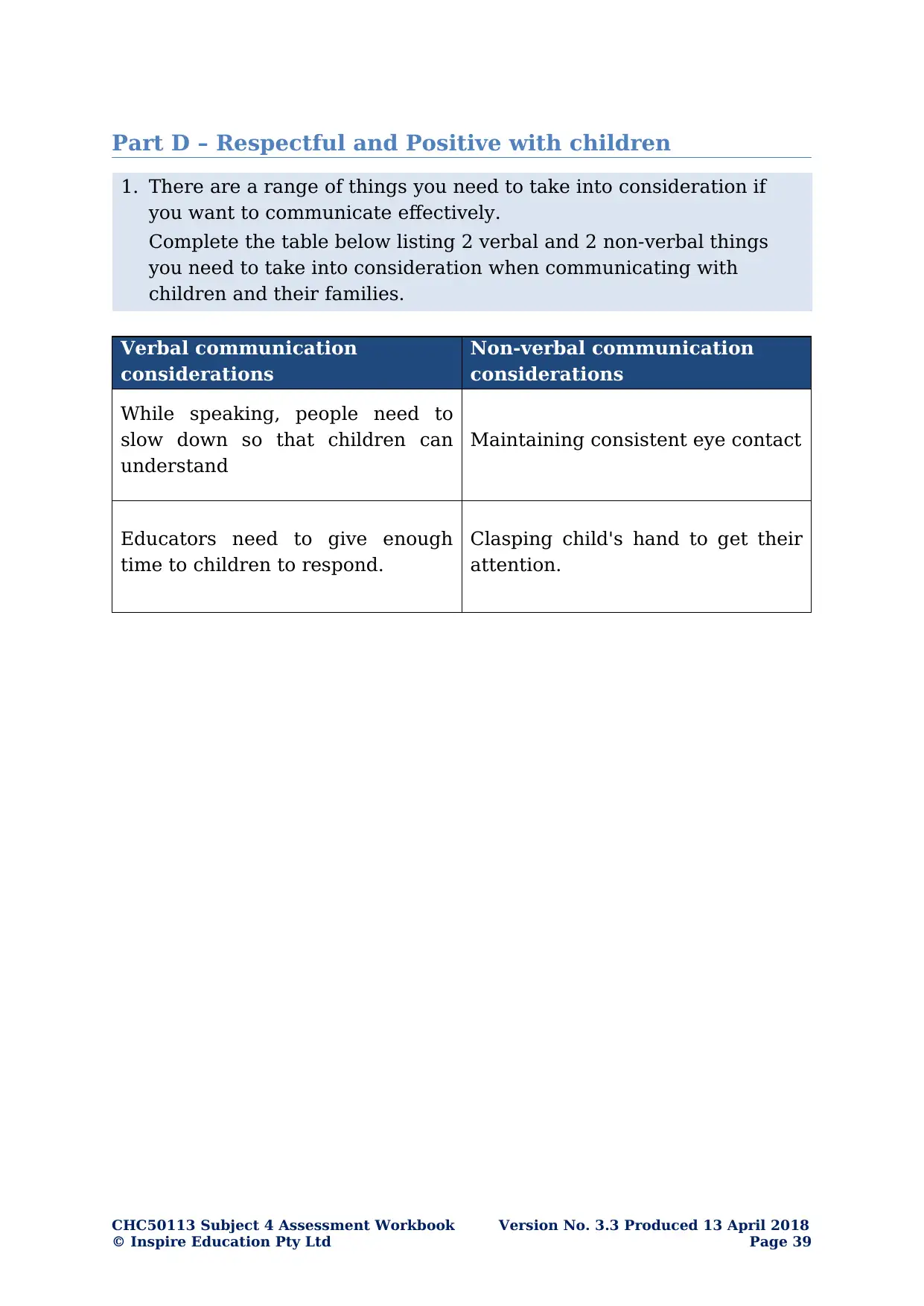
Part D – Respectful and Positive with children
1. There are a range of things you need to take into consideration if
you want to communicate effectively.
Complete the table below listing 2 verbal and 2 non-verbal things
you need to take into consideration when communicating with
children and their families.
Verbal communication
considerations
Non-verbal communication
considerations
While speaking, people need to
slow down so that children can
understand
Maintaining consistent eye contact
Educators need to give enough
time to children to respond.
Clasping child's hand to get their
attention.
CHC50113 Subject 4 Assessment Workbook Version No. 3.3 Produced 13 April 2018
© Inspire Education Pty Ltd Page 39
1. There are a range of things you need to take into consideration if
you want to communicate effectively.
Complete the table below listing 2 verbal and 2 non-verbal things
you need to take into consideration when communicating with
children and their families.
Verbal communication
considerations
Non-verbal communication
considerations
While speaking, people need to
slow down so that children can
understand
Maintaining consistent eye contact
Educators need to give enough
time to children to respond.
Clasping child's hand to get their
attention.
CHC50113 Subject 4 Assessment Workbook Version No. 3.3 Produced 13 April 2018
© Inspire Education Pty Ltd Page 39
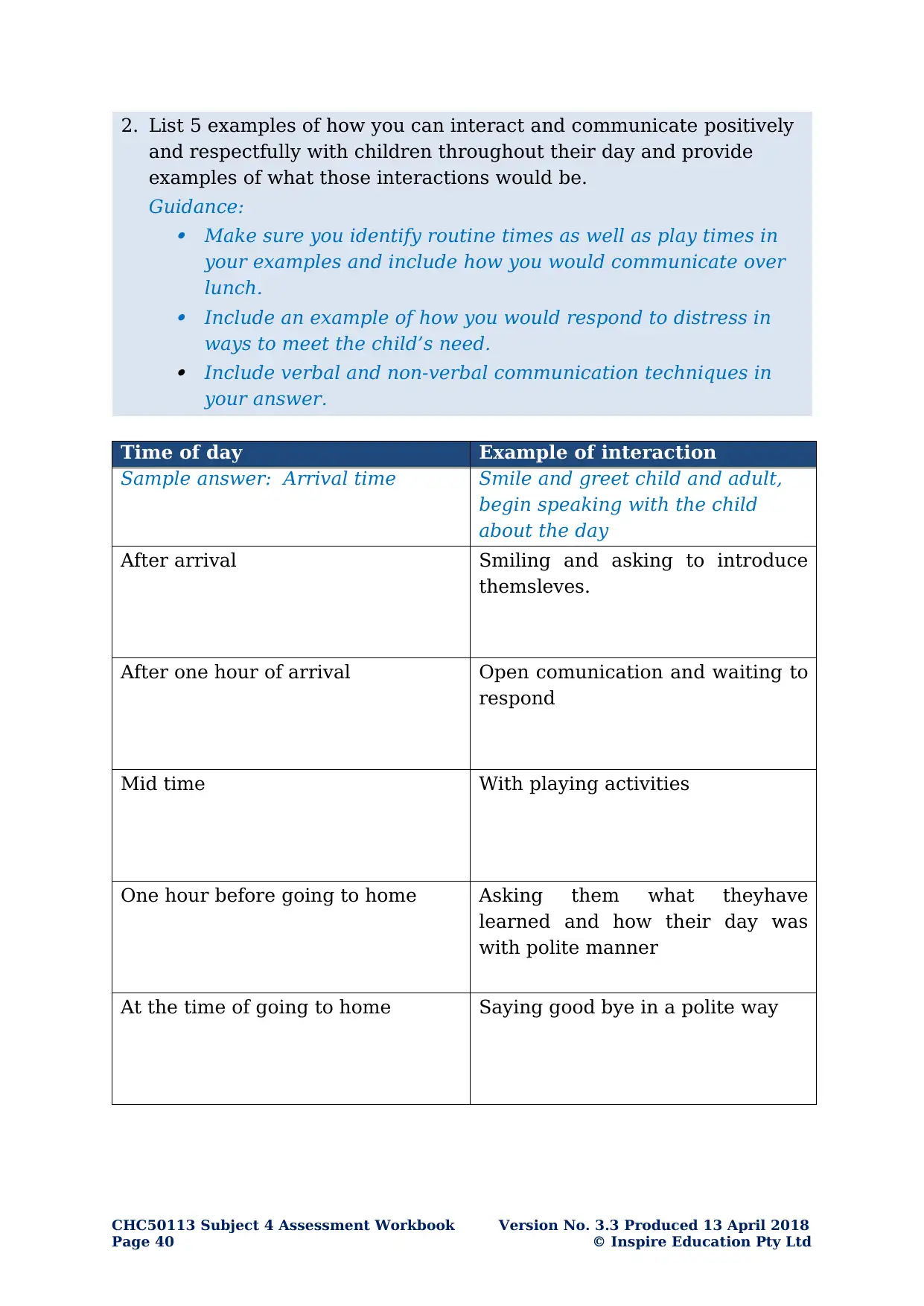
2. List 5 examples of how you can interact and communicate positively
and respectfully with children throughout their day and provide
examples of what those interactions would be.
Guidance:
Make sure you identify routine times as well as play times in
your examples and include how you would communicate over
lunch.
Include an example of how you would respond to distress in
ways to meet the child’s need.
Include verbal and non-verbal communication techniques in
your answer.
Time of day Example of interaction
Sample answer: Arrival time Smile and greet child and adult,
begin speaking with the child
about the day
After arrival Smiling and asking to introduce
themsleves.
After one hour of arrival Open comunication and waiting to
respond
Mid time With playing activities
One hour before going to home Asking them what theyhave
learned and how their day was
with polite manner
At the time of going to home Saying good bye in a polite way
CHC50113 Subject 4 Assessment Workbook Version No. 3.3 Produced 13 April 2018
Page 40 © Inspire Education Pty Ltd
and respectfully with children throughout their day and provide
examples of what those interactions would be.
Guidance:
Make sure you identify routine times as well as play times in
your examples and include how you would communicate over
lunch.
Include an example of how you would respond to distress in
ways to meet the child’s need.
Include verbal and non-verbal communication techniques in
your answer.
Time of day Example of interaction
Sample answer: Arrival time Smile and greet child and adult,
begin speaking with the child
about the day
After arrival Smiling and asking to introduce
themsleves.
After one hour of arrival Open comunication and waiting to
respond
Mid time With playing activities
One hour before going to home Asking them what theyhave
learned and how their day was
with polite manner
At the time of going to home Saying good bye in a polite way
CHC50113 Subject 4 Assessment Workbook Version No. 3.3 Produced 13 April 2018
Page 40 © Inspire Education Pty Ltd
Secure Best Marks with AI Grader
Need help grading? Try our AI Grader for instant feedback on your assignments.
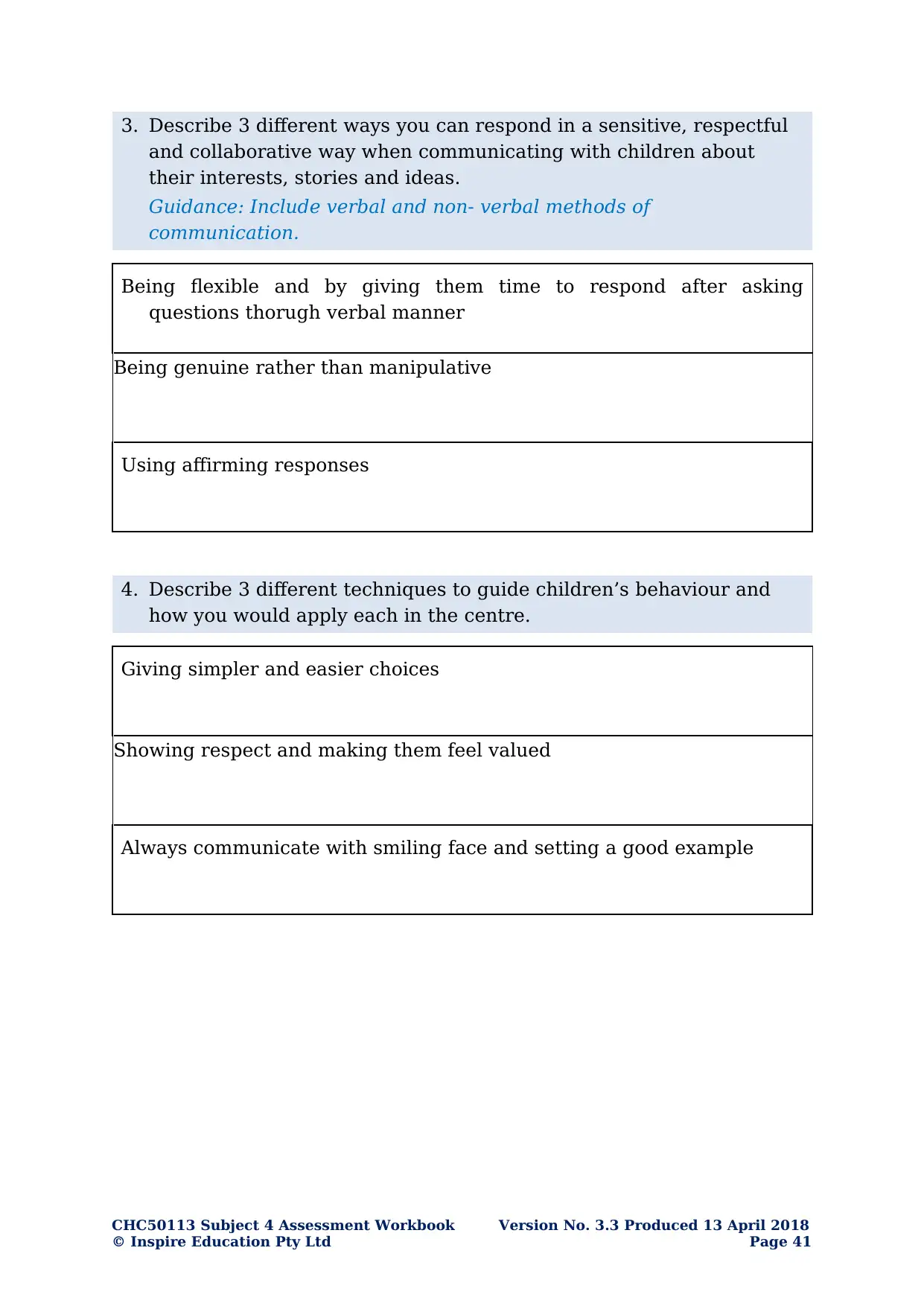
3. Describe 3 different ways you can respond in a sensitive, respectful
and collaborative way when communicating with children about
their interests, stories and ideas.
Guidance: Include verbal and non- verbal methods of
communication.
Being flexible and by giving them time to respond after asking
questions thorugh verbal manner
Being genuine rather than manipulative
Using affirming responses
4. Describe 3 different techniques to guide children’s behaviour and
how you would apply each in the centre.
Giving simpler and easier choices
Showing respect and making them feel valued
Always communicate with smiling face and setting a good example
CHC50113 Subject 4 Assessment Workbook Version No. 3.3 Produced 13 April 2018
© Inspire Education Pty Ltd Page 41
and collaborative way when communicating with children about
their interests, stories and ideas.
Guidance: Include verbal and non- verbal methods of
communication.
Being flexible and by giving them time to respond after asking
questions thorugh verbal manner
Being genuine rather than manipulative
Using affirming responses
4. Describe 3 different techniques to guide children’s behaviour and
how you would apply each in the centre.
Giving simpler and easier choices
Showing respect and making them feel valued
Always communicate with smiling face and setting a good example
CHC50113 Subject 4 Assessment Workbook Version No. 3.3 Produced 13 April 2018
© Inspire Education Pty Ltd Page 41
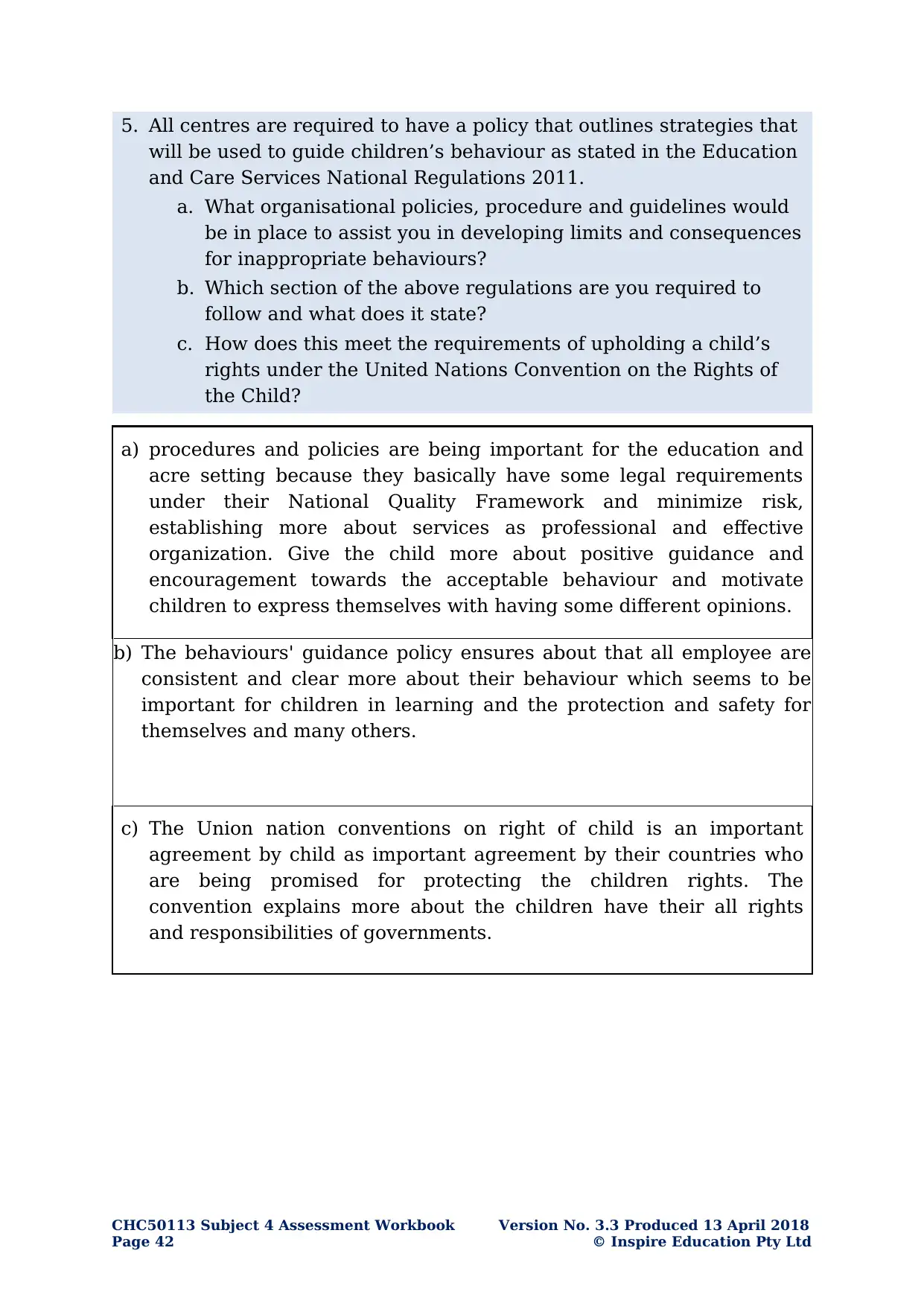
5. All centres are required to have a policy that outlines strategies that
will be used to guide children’s behaviour as stated in the Education
and Care Services National Regulations 2011.
a. What organisational policies, procedure and guidelines would
be in place to assist you in developing limits and consequences
for inappropriate behaviours?
b. Which section of the above regulations are you required to
follow and what does it state?
c. How does this meet the requirements of upholding a child’s
rights under the United Nations Convention on the Rights of
the Child?
a) procedures and policies are being important for the education and
acre setting because they basically have some legal requirements
under their National Quality Framework and minimize risk,
establishing more about services as professional and effective
organization. Give the child more about positive guidance and
encouragement towards the acceptable behaviour and motivate
children to express themselves with having some different opinions.
b) The behaviours' guidance policy ensures about that all employee are
consistent and clear more about their behaviour which seems to be
important for children in learning and the protection and safety for
themselves and many others.
c) The Union nation conventions on right of child is an important
agreement by child as important agreement by their countries who
are being promised for protecting the children rights. The
convention explains more about the children have their all rights
and responsibilities of governments.
CHC50113 Subject 4 Assessment Workbook Version No. 3.3 Produced 13 April 2018
Page 42 © Inspire Education Pty Ltd
will be used to guide children’s behaviour as stated in the Education
and Care Services National Regulations 2011.
a. What organisational policies, procedure and guidelines would
be in place to assist you in developing limits and consequences
for inappropriate behaviours?
b. Which section of the above regulations are you required to
follow and what does it state?
c. How does this meet the requirements of upholding a child’s
rights under the United Nations Convention on the Rights of
the Child?
a) procedures and policies are being important for the education and
acre setting because they basically have some legal requirements
under their National Quality Framework and minimize risk,
establishing more about services as professional and effective
organization. Give the child more about positive guidance and
encouragement towards the acceptable behaviour and motivate
children to express themselves with having some different opinions.
b) The behaviours' guidance policy ensures about that all employee are
consistent and clear more about their behaviour which seems to be
important for children in learning and the protection and safety for
themselves and many others.
c) The Union nation conventions on right of child is an important
agreement by child as important agreement by their countries who
are being promised for protecting the children rights. The
convention explains more about the children have their all rights
and responsibilities of governments.
CHC50113 Subject 4 Assessment Workbook Version No. 3.3 Produced 13 April 2018
Page 42 © Inspire Education Pty Ltd
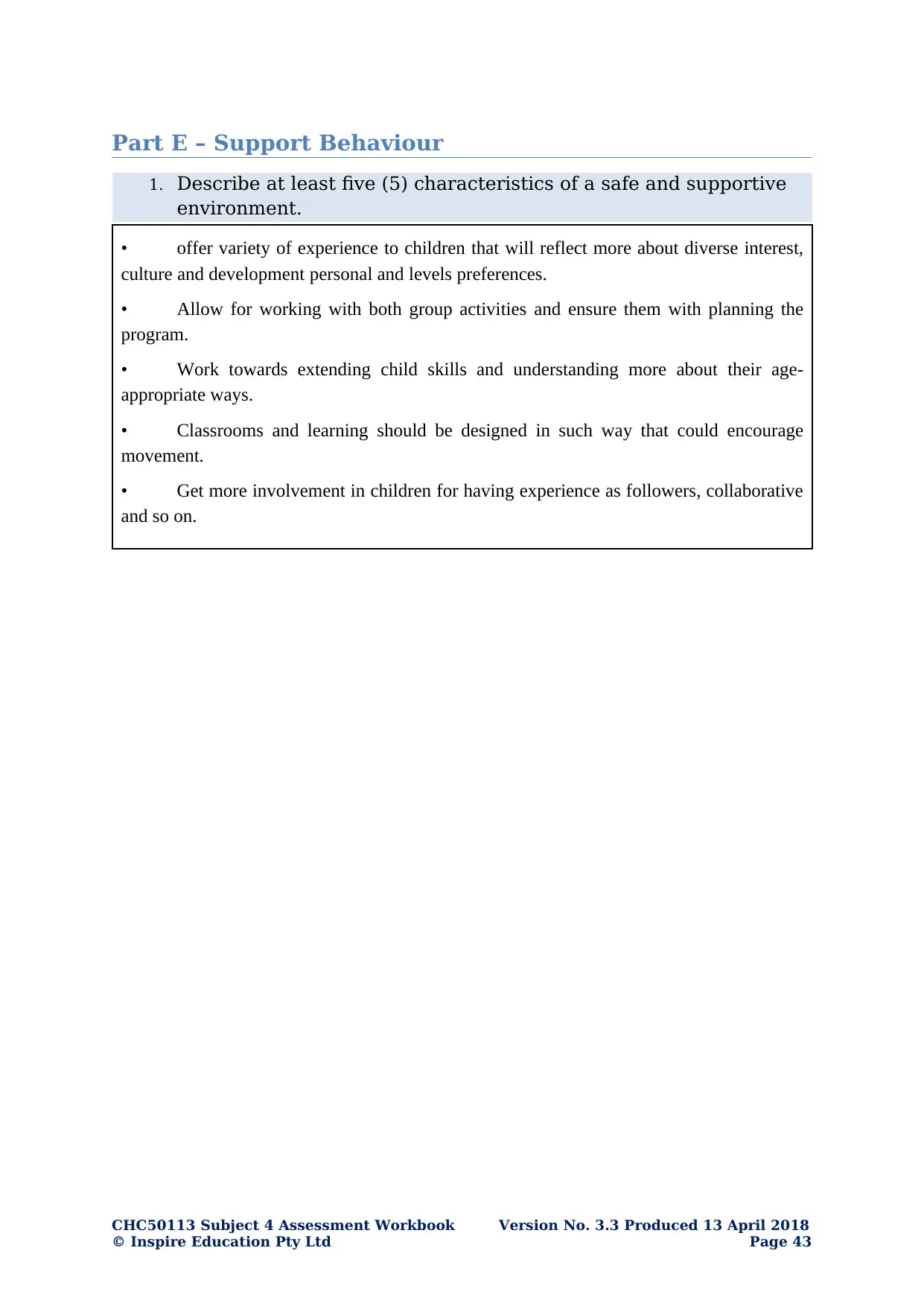
Part E – Support Behaviour
1. Describe at least five (5) characteristics of a safe and supportive
environment.
• offer variety of experience to children that will reflect more about diverse interest,
culture and development personal and levels preferences.
• Allow for working with both group activities and ensure them with planning the
program.
• Work towards extending child skills and understanding more about their age-
appropriate ways.
• Classrooms and learning should be designed in such way that could encourage
movement.
• Get more involvement in children for having experience as followers, collaborative
and so on.
CHC50113 Subject 4 Assessment Workbook Version No. 3.3 Produced 13 April 2018
© Inspire Education Pty Ltd Page 43
1. Describe at least five (5) characteristics of a safe and supportive
environment.
• offer variety of experience to children that will reflect more about diverse interest,
culture and development personal and levels preferences.
• Allow for working with both group activities and ensure them with planning the
program.
• Work towards extending child skills and understanding more about their age-
appropriate ways.
• Classrooms and learning should be designed in such way that could encourage
movement.
• Get more involvement in children for having experience as followers, collaborative
and so on.
CHC50113 Subject 4 Assessment Workbook Version No. 3.3 Produced 13 April 2018
© Inspire Education Pty Ltd Page 43
Paraphrase This Document
Need a fresh take? Get an instant paraphrase of this document with our AI Paraphraser
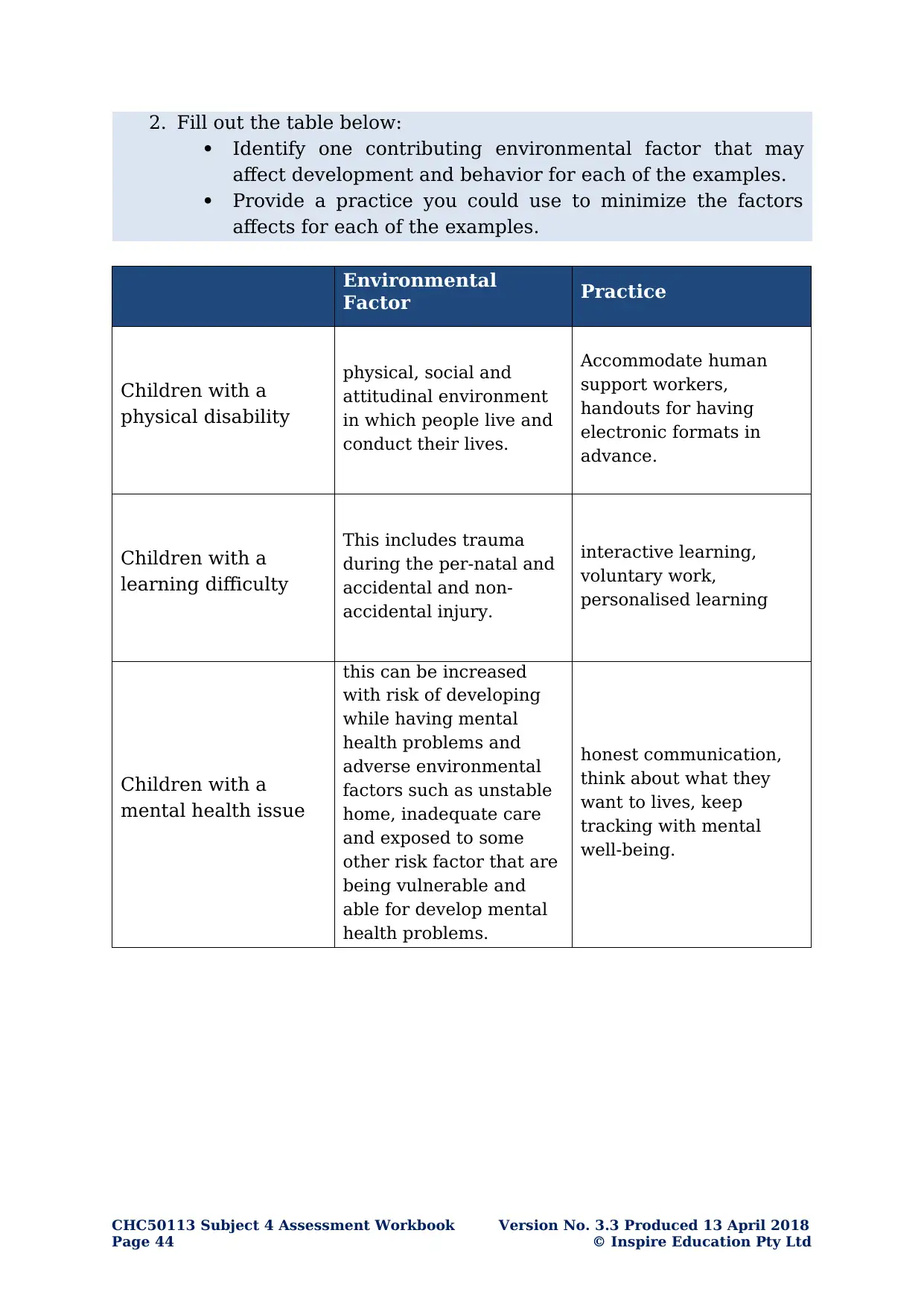
2. Fill out the table below:
Identify one contributing environmental factor that may
affect development and behavior for each of the examples.
Provide a practice you could use to minimize the factors
affects for each of the examples.
Environmental
Factor Practice
Children with a
physical disability
physical, social and
attitudinal environment
in which people live and
conduct their lives.
Accommodate human
support workers,
handouts for having
electronic formats in
advance.
Children with a
learning difficulty
This includes trauma
during the per-natal and
accidental and non-
accidental injury.
interactive learning,
voluntary work,
personalised learning
Children with a
mental health issue
this can be increased
with risk of developing
while having mental
health problems and
adverse environmental
factors such as unstable
home, inadequate care
and exposed to some
other risk factor that are
being vulnerable and
able for develop mental
health problems.
honest communication,
think about what they
want to lives, keep
tracking with mental
well-being.
CHC50113 Subject 4 Assessment Workbook Version No. 3.3 Produced 13 April 2018
Page 44 © Inspire Education Pty Ltd
Identify one contributing environmental factor that may
affect development and behavior for each of the examples.
Provide a practice you could use to minimize the factors
affects for each of the examples.
Environmental
Factor Practice
Children with a
physical disability
physical, social and
attitudinal environment
in which people live and
conduct their lives.
Accommodate human
support workers,
handouts for having
electronic formats in
advance.
Children with a
learning difficulty
This includes trauma
during the per-natal and
accidental and non-
accidental injury.
interactive learning,
voluntary work,
personalised learning
Children with a
mental health issue
this can be increased
with risk of developing
while having mental
health problems and
adverse environmental
factors such as unstable
home, inadequate care
and exposed to some
other risk factor that are
being vulnerable and
able for develop mental
health problems.
honest communication,
think about what they
want to lives, keep
tracking with mental
well-being.
CHC50113 Subject 4 Assessment Workbook Version No. 3.3 Produced 13 April 2018
Page 44 © Inspire Education Pty Ltd
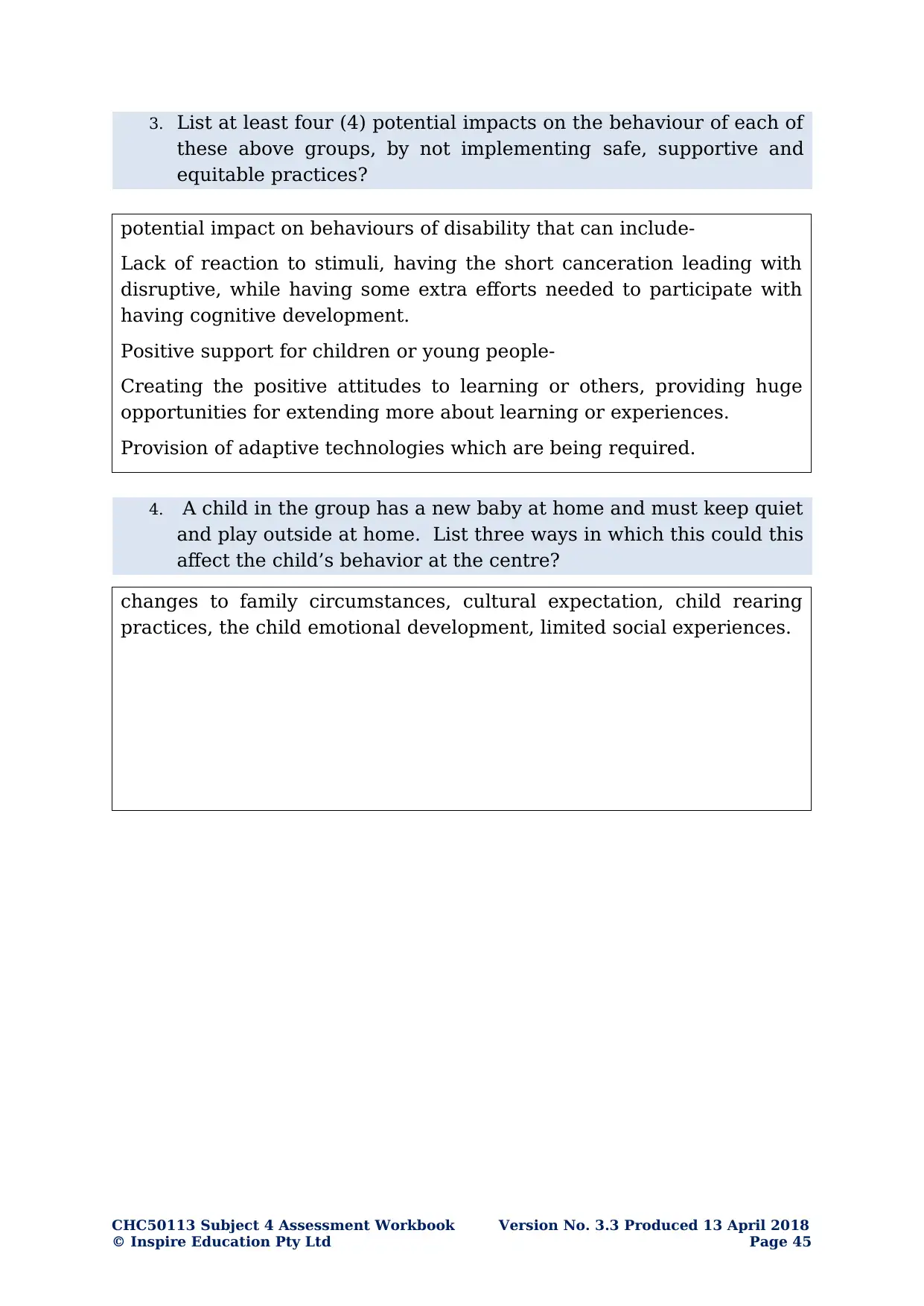
3. List at least four (4) potential impacts on the behaviour of each of
these above groups, by not implementing safe, supportive and
equitable practices?
potential impact on behaviours of disability that can include-
Lack of reaction to stimuli, having the short canceration leading with
disruptive, while having some extra efforts needed to participate with
having cognitive development.
Positive support for children or young people-
Creating the positive attitudes to learning or others, providing huge
opportunities for extending more about learning or experiences.
Provision of adaptive technologies which are being required.
4. A child in the group has a new baby at home and must keep quiet
and play outside at home. List three ways in which this could this
affect the child’s behavior at the centre?
changes to family circumstances, cultural expectation, child rearing
practices, the child emotional development, limited social experiences.
CHC50113 Subject 4 Assessment Workbook Version No. 3.3 Produced 13 April 2018
© Inspire Education Pty Ltd Page 45
these above groups, by not implementing safe, supportive and
equitable practices?
potential impact on behaviours of disability that can include-
Lack of reaction to stimuli, having the short canceration leading with
disruptive, while having some extra efforts needed to participate with
having cognitive development.
Positive support for children or young people-
Creating the positive attitudes to learning or others, providing huge
opportunities for extending more about learning or experiences.
Provision of adaptive technologies which are being required.
4. A child in the group has a new baby at home and must keep quiet
and play outside at home. List three ways in which this could this
affect the child’s behavior at the centre?
changes to family circumstances, cultural expectation, child rearing
practices, the child emotional development, limited social experiences.
CHC50113 Subject 4 Assessment Workbook Version No. 3.3 Produced 13 April 2018
© Inspire Education Pty Ltd Page 45

5. Discuss four (4) impacts the environment and culture has on the
behavior of children.
The physical environment-
• Exposure of condition, accident, injury and neglect.
• The nutritional value of food the child ears.
The social environment-
• Consist of norms, value and morals.
• Standard of behaviour in the cultural groups in which child raised.
The learning environment-
• Inputs shape and promotes the cognitive development.
• Various types of stimulation available in the child immediate
environment.
The emotional environment-
• The child interpersonal relationship.
• Development of self-esteem, trust and so on,
6. Describe in your own words:
a. positive reinforcement
b. Why you would use positive reinforcement
CHC50113 Subject 4 Assessment Workbook Version No. 3.3 Produced 13 April 2018
Page 46 © Inspire Education Pty Ltd
behavior of children.
The physical environment-
• Exposure of condition, accident, injury and neglect.
• The nutritional value of food the child ears.
The social environment-
• Consist of norms, value and morals.
• Standard of behaviour in the cultural groups in which child raised.
The learning environment-
• Inputs shape and promotes the cognitive development.
• Various types of stimulation available in the child immediate
environment.
The emotional environment-
• The child interpersonal relationship.
• Development of self-esteem, trust and so on,
6. Describe in your own words:
a. positive reinforcement
b. Why you would use positive reinforcement
CHC50113 Subject 4 Assessment Workbook Version No. 3.3 Produced 13 April 2018
Page 46 © Inspire Education Pty Ltd
Secure Best Marks with AI Grader
Need help grading? Try our AI Grader for instant feedback on your assignments.
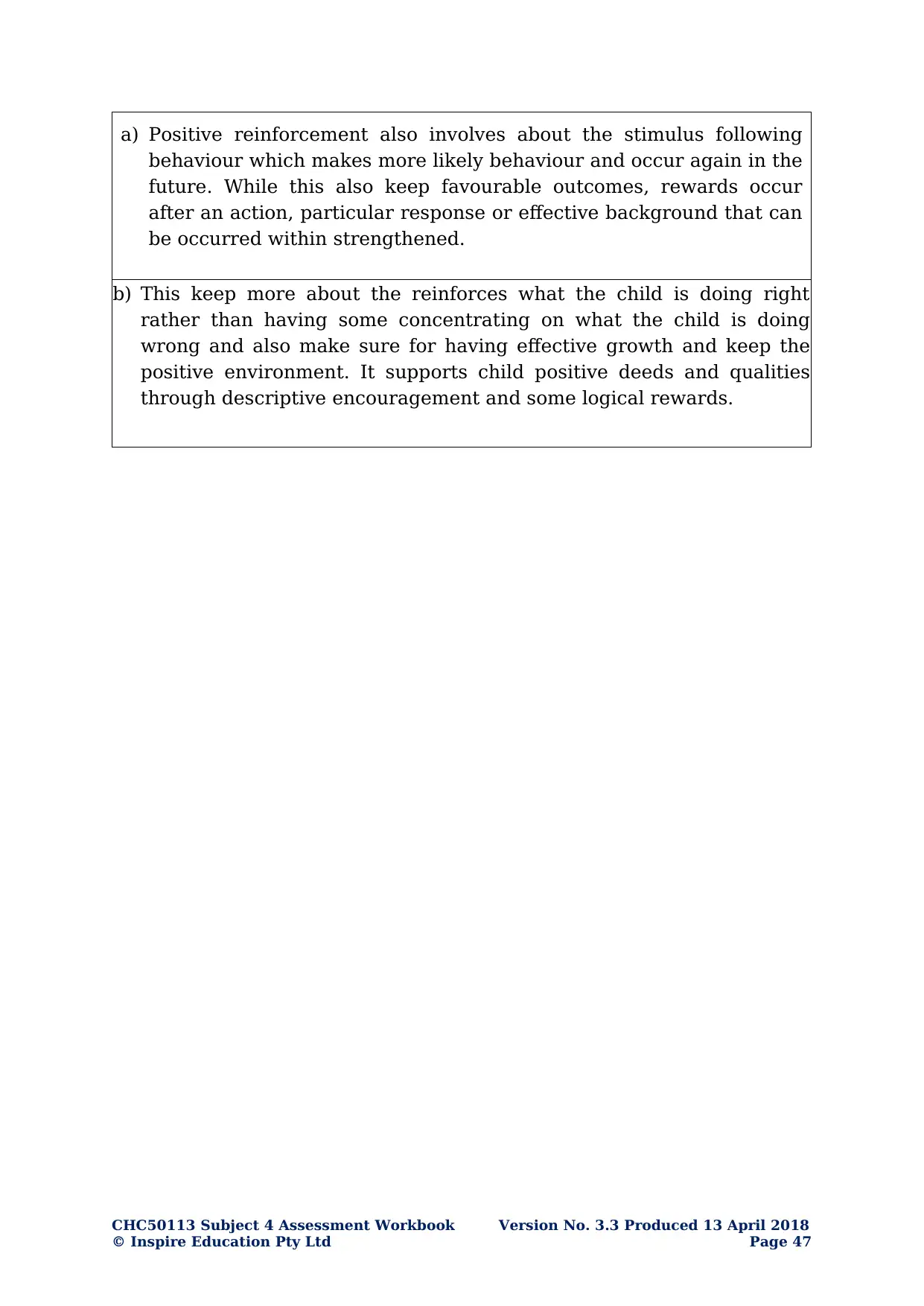
a) Positive reinforcement also involves about the stimulus following
behaviour which makes more likely behaviour and occur again in the
future. While this also keep favourable outcomes, rewards occur
after an action, particular response or effective background that can
be occurred within strengthened.
b) This keep more about the reinforces what the child is doing right
rather than having some concentrating on what the child is doing
wrong and also make sure for having effective growth and keep the
positive environment. It supports child positive deeds and qualities
through descriptive encouragement and some logical rewards.
CHC50113 Subject 4 Assessment Workbook Version No. 3.3 Produced 13 April 2018
© Inspire Education Pty Ltd Page 47
behaviour which makes more likely behaviour and occur again in the
future. While this also keep favourable outcomes, rewards occur
after an action, particular response or effective background that can
be occurred within strengthened.
b) This keep more about the reinforces what the child is doing right
rather than having some concentrating on what the child is doing
wrong and also make sure for having effective growth and keep the
positive environment. It supports child positive deeds and qualities
through descriptive encouragement and some logical rewards.
CHC50113 Subject 4 Assessment Workbook Version No. 3.3 Produced 13 April 2018
© Inspire Education Pty Ltd Page 47
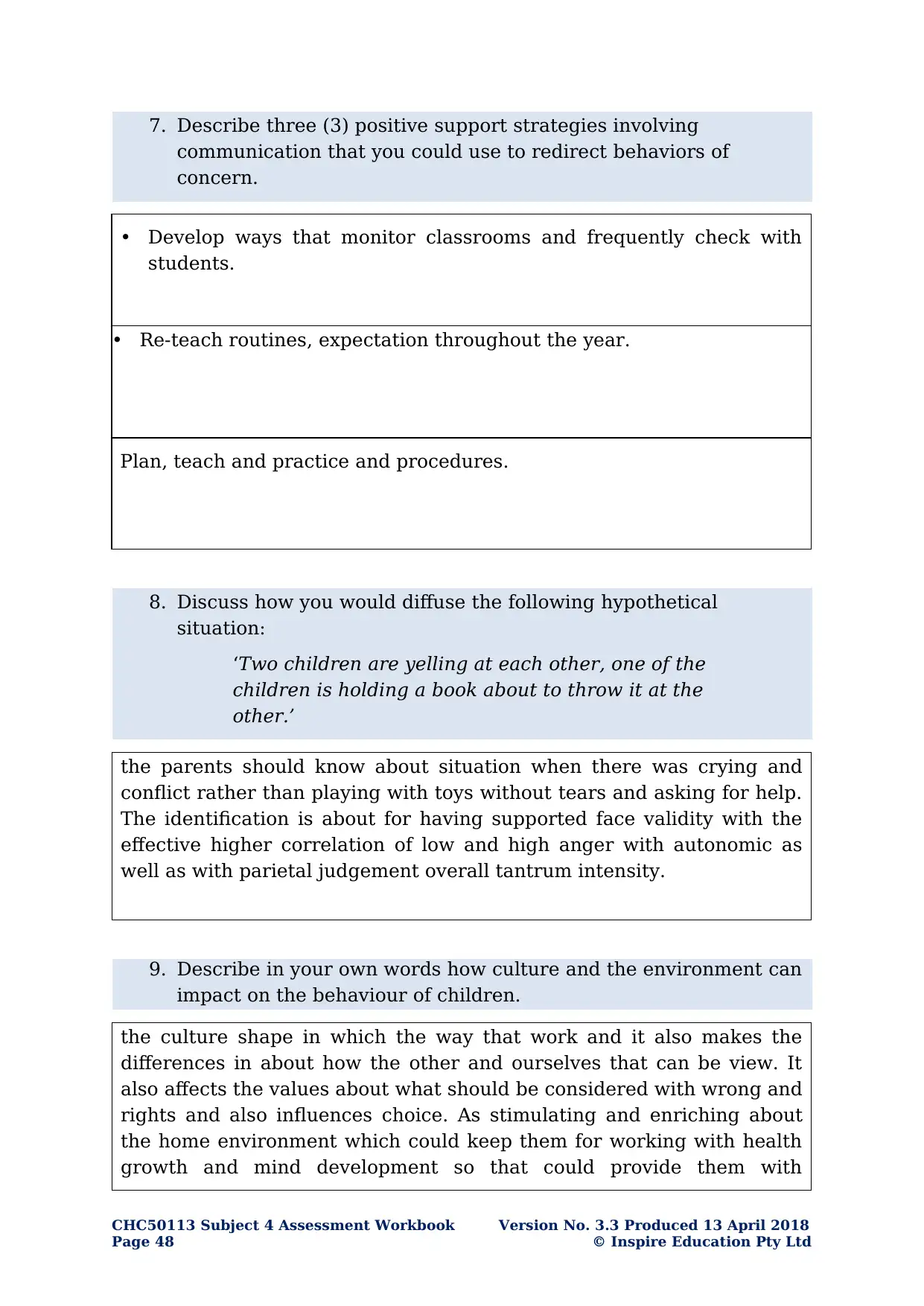
7. Describe three (3) positive support strategies involving
communication that you could use to redirect behaviors of
concern.
• Develop ways that monitor classrooms and frequently check with
students.
• Re-teach routines, expectation throughout the year.
Plan, teach and practice and procedures.
8. Discuss how you would diffuse the following hypothetical
situation:
‘Two children are yelling at each other, one of the
children is holding a book about to throw it at the
other.’
the parents should know about situation when there was crying and
conflict rather than playing with toys without tears and asking for help.
The identification is about for having supported face validity with the
effective higher correlation of low and high anger with autonomic as
well as with parietal judgement overall tantrum intensity.
9. Describe in your own words how culture and the environment can
impact on the behaviour of children.
the culture shape in which the way that work and it also makes the
differences in about how the other and ourselves that can be view. It
also affects the values about what should be considered with wrong and
rights and also influences choice. As stimulating and enriching about
the home environment which could keep them for working with health
growth and mind development so that could provide them with
CHC50113 Subject 4 Assessment Workbook Version No. 3.3 Produced 13 April 2018
Page 48 © Inspire Education Pty Ltd
communication that you could use to redirect behaviors of
concern.
• Develop ways that monitor classrooms and frequently check with
students.
• Re-teach routines, expectation throughout the year.
Plan, teach and practice and procedures.
8. Discuss how you would diffuse the following hypothetical
situation:
‘Two children are yelling at each other, one of the
children is holding a book about to throw it at the
other.’
the parents should know about situation when there was crying and
conflict rather than playing with toys without tears and asking for help.
The identification is about for having supported face validity with the
effective higher correlation of low and high anger with autonomic as
well as with parietal judgement overall tantrum intensity.
9. Describe in your own words how culture and the environment can
impact on the behaviour of children.
the culture shape in which the way that work and it also makes the
differences in about how the other and ourselves that can be view. It
also affects the values about what should be considered with wrong and
rights and also influences choice. As stimulating and enriching about
the home environment which could keep them for working with health
growth and mind development so that could provide them with
CHC50113 Subject 4 Assessment Workbook Version No. 3.3 Produced 13 April 2018
Page 48 © Inspire Education Pty Ltd

emotional support, opportunities and exploration. In families this could
be essential for presenting about what often fewer economics and
emotional resources. This also seems important through which
behaviour of child that can be implemented in positive way and ensure
them for working with more growth and develop the better
opportunities.
10. What is disruptive behaviour?
disruptive behaviours in children refers to behaviours which occur
when the child has difficulty in controlling their actions. This might be
also often and happen for many reasons. While for having such things
this keep the child behaviour in positive way and ensure them for
growth and bring out the better results. In having inappropriate
behaviour that interferes about the functioning and flow of workplace.
It hinders or prevents staff members from carrying out with their
professional responsibilities.
11. What is meant by ‘behaviours of concern’?
a behaviour concern about which causes stress, risk or actual harm to
person, staff, families members around them. Behaviour of concern,
when child does something that hurts themselves or some other people.
The types of behaviours which can prevent children from participating
in various activities and are stressful for upsetting for all involvement.
12. What are the main differences between disruptive behaviours and
‘behaviours of concern’?
disruptive behaviour which keep child as uncooperative and prevent
from themselves and other from focusing on what they are doing. This
might be also grab the attention, distracting them from each other
children and task at hand. While for children to exhibit disruptive
behaviour as they struggle to learn more about self-control and
behaviour is being more concern and should be addressed as part of
their regular support. Behaviour concern about challenging behaviour
are when the child does something that hirts themselves or some other
people. These behaviours are not so common and many children
behave in this way at many times.
CHC50113 Subject 4 Assessment Workbook Version No. 3.3 Produced 13 April 2018
© Inspire Education Pty Ltd Page 49
be essential for presenting about what often fewer economics and
emotional resources. This also seems important through which
behaviour of child that can be implemented in positive way and ensure
them for working with more growth and develop the better
opportunities.
10. What is disruptive behaviour?
disruptive behaviours in children refers to behaviours which occur
when the child has difficulty in controlling their actions. This might be
also often and happen for many reasons. While for having such things
this keep the child behaviour in positive way and ensure them for
growth and bring out the better results. In having inappropriate
behaviour that interferes about the functioning and flow of workplace.
It hinders or prevents staff members from carrying out with their
professional responsibilities.
11. What is meant by ‘behaviours of concern’?
a behaviour concern about which causes stress, risk or actual harm to
person, staff, families members around them. Behaviour of concern,
when child does something that hurts themselves or some other people.
The types of behaviours which can prevent children from participating
in various activities and are stressful for upsetting for all involvement.
12. What are the main differences between disruptive behaviours and
‘behaviours of concern’?
disruptive behaviour which keep child as uncooperative and prevent
from themselves and other from focusing on what they are doing. This
might be also grab the attention, distracting them from each other
children and task at hand. While for children to exhibit disruptive
behaviour as they struggle to learn more about self-control and
behaviour is being more concern and should be addressed as part of
their regular support. Behaviour concern about challenging behaviour
are when the child does something that hirts themselves or some other
people. These behaviours are not so common and many children
behave in this way at many times.
CHC50113 Subject 4 Assessment Workbook Version No. 3.3 Produced 13 April 2018
© Inspire Education Pty Ltd Page 49
Paraphrase This Document
Need a fresh take? Get an instant paraphrase of this document with our AI Paraphraser

CHC50113 Subject 4 Assessment Workbook Version No. 3.3 Produced 13 April 2018
Page 50 © Inspire Education Pty Ltd
Page 50 © Inspire Education Pty Ltd
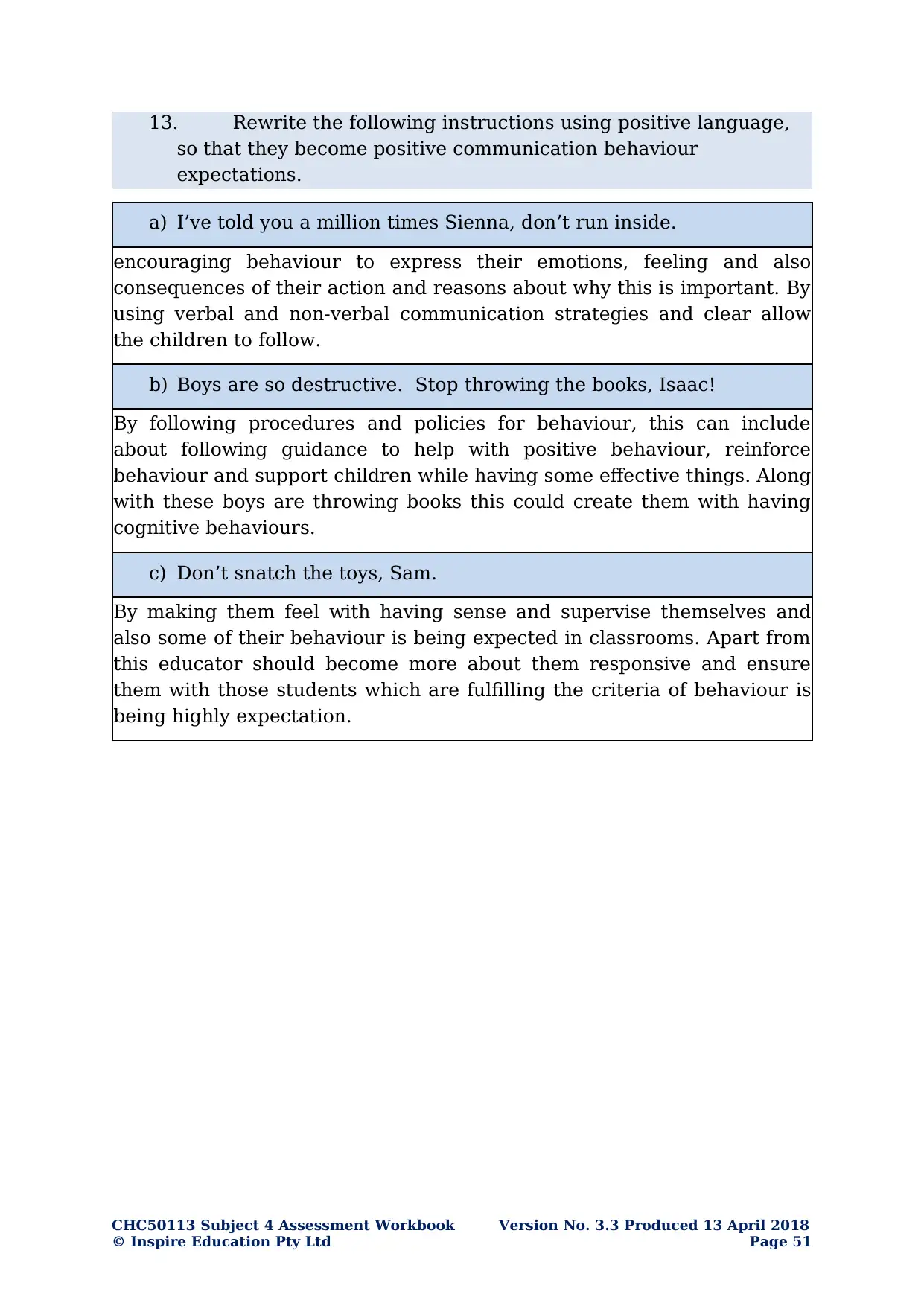
13. Rewrite the following instructions using positive language,
so that they become positive communication behaviour
expectations.
a) I’ve told you a million times Sienna, don’t run inside.
encouraging behaviour to express their emotions, feeling and also
consequences of their action and reasons about why this is important. By
using verbal and non-verbal communication strategies and clear allow
the children to follow.
b) Boys are so destructive. Stop throwing the books, Isaac!
By following procedures and policies for behaviour, this can include
about following guidance to help with positive behaviour, reinforce
behaviour and support children while having some effective things. Along
with these boys are throwing books this could create them with having
cognitive behaviours.
c) Don’t snatch the toys, Sam.
By making them feel with having sense and supervise themselves and
also some of their behaviour is being expected in classrooms. Apart from
this educator should become more about them responsive and ensure
them with those students which are fulfilling the criteria of behaviour is
being highly expectation.
CHC50113 Subject 4 Assessment Workbook Version No. 3.3 Produced 13 April 2018
© Inspire Education Pty Ltd Page 51
so that they become positive communication behaviour
expectations.
a) I’ve told you a million times Sienna, don’t run inside.
encouraging behaviour to express their emotions, feeling and also
consequences of their action and reasons about why this is important. By
using verbal and non-verbal communication strategies and clear allow
the children to follow.
b) Boys are so destructive. Stop throwing the books, Isaac!
By following procedures and policies for behaviour, this can include
about following guidance to help with positive behaviour, reinforce
behaviour and support children while having some effective things. Along
with these boys are throwing books this could create them with having
cognitive behaviours.
c) Don’t snatch the toys, Sam.
By making them feel with having sense and supervise themselves and
also some of their behaviour is being expected in classrooms. Apart from
this educator should become more about them responsive and ensure
them with those students which are fulfilling the criteria of behaviour is
being highly expectation.
CHC50113 Subject 4 Assessment Workbook Version No. 3.3 Produced 13 April 2018
© Inspire Education Pty Ltd Page 51
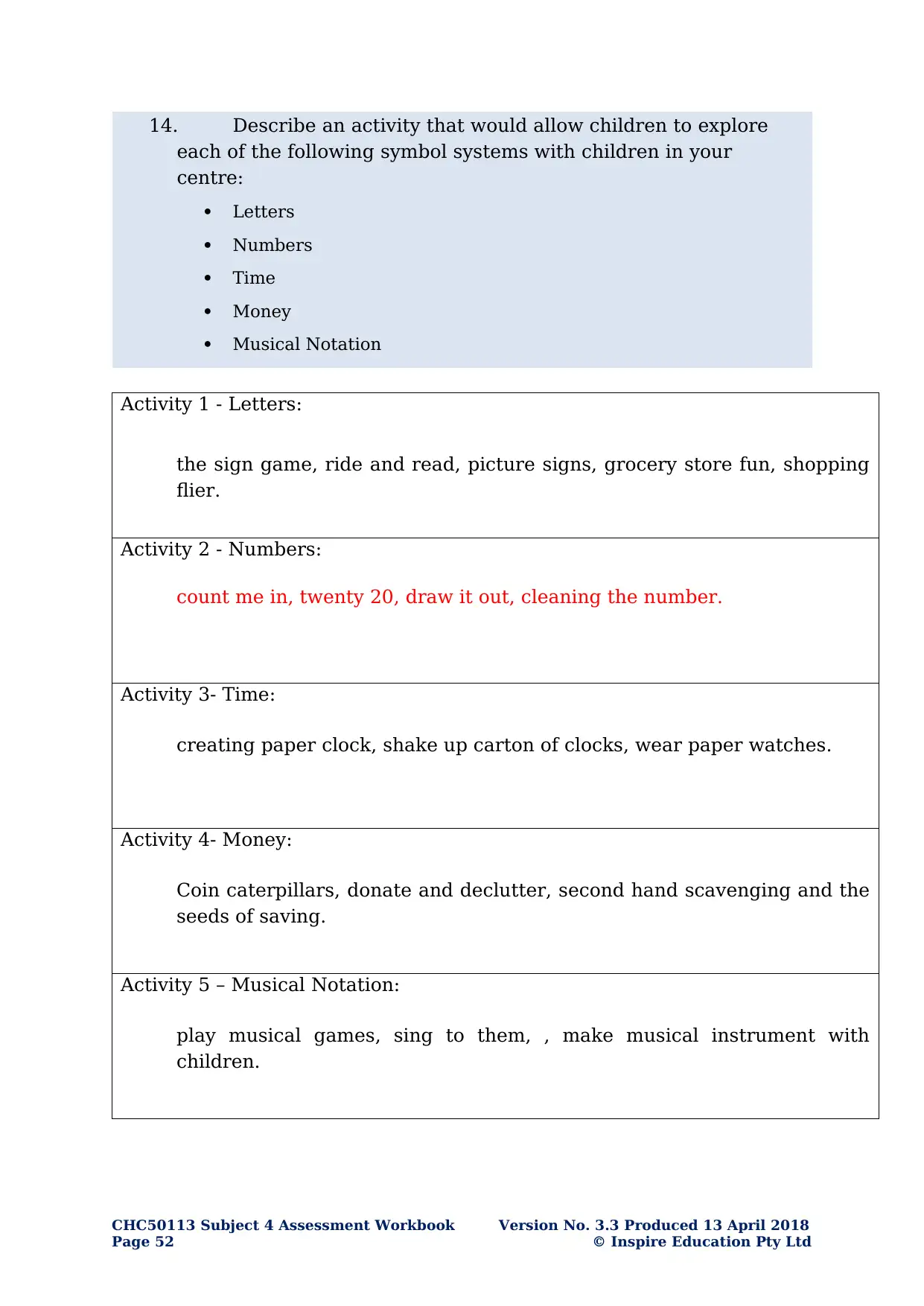
14. Describe an activity that would allow children to explore
each of the following symbol systems with children in your
centre:
Letters
Numbers
Time
Money
Musical Notation
Activity 1 - Letters:
the sign game, ride and read, picture signs, grocery store fun, shopping
flier.
Activity 2 - Numbers:
count me in, twenty 20, draw it out, cleaning the number.
Activity 3- Time:
creating paper clock, shake up carton of clocks, wear paper watches.
Activity 4- Money:
Coin caterpillars, donate and declutter, second hand scavenging and the
seeds of saving.
Activity 5 – Musical Notation:
play musical games, sing to them, , make musical instrument with
children.
CHC50113 Subject 4 Assessment Workbook Version No. 3.3 Produced 13 April 2018
Page 52 © Inspire Education Pty Ltd
each of the following symbol systems with children in your
centre:
Letters
Numbers
Time
Money
Musical Notation
Activity 1 - Letters:
the sign game, ride and read, picture signs, grocery store fun, shopping
flier.
Activity 2 - Numbers:
count me in, twenty 20, draw it out, cleaning the number.
Activity 3- Time:
creating paper clock, shake up carton of clocks, wear paper watches.
Activity 4- Money:
Coin caterpillars, donate and declutter, second hand scavenging and the
seeds of saving.
Activity 5 – Musical Notation:
play musical games, sing to them, , make musical instrument with
children.
CHC50113 Subject 4 Assessment Workbook Version No. 3.3 Produced 13 April 2018
Page 52 © Inspire Education Pty Ltd
Secure Best Marks with AI Grader
Need help grading? Try our AI Grader for instant feedback on your assignments.
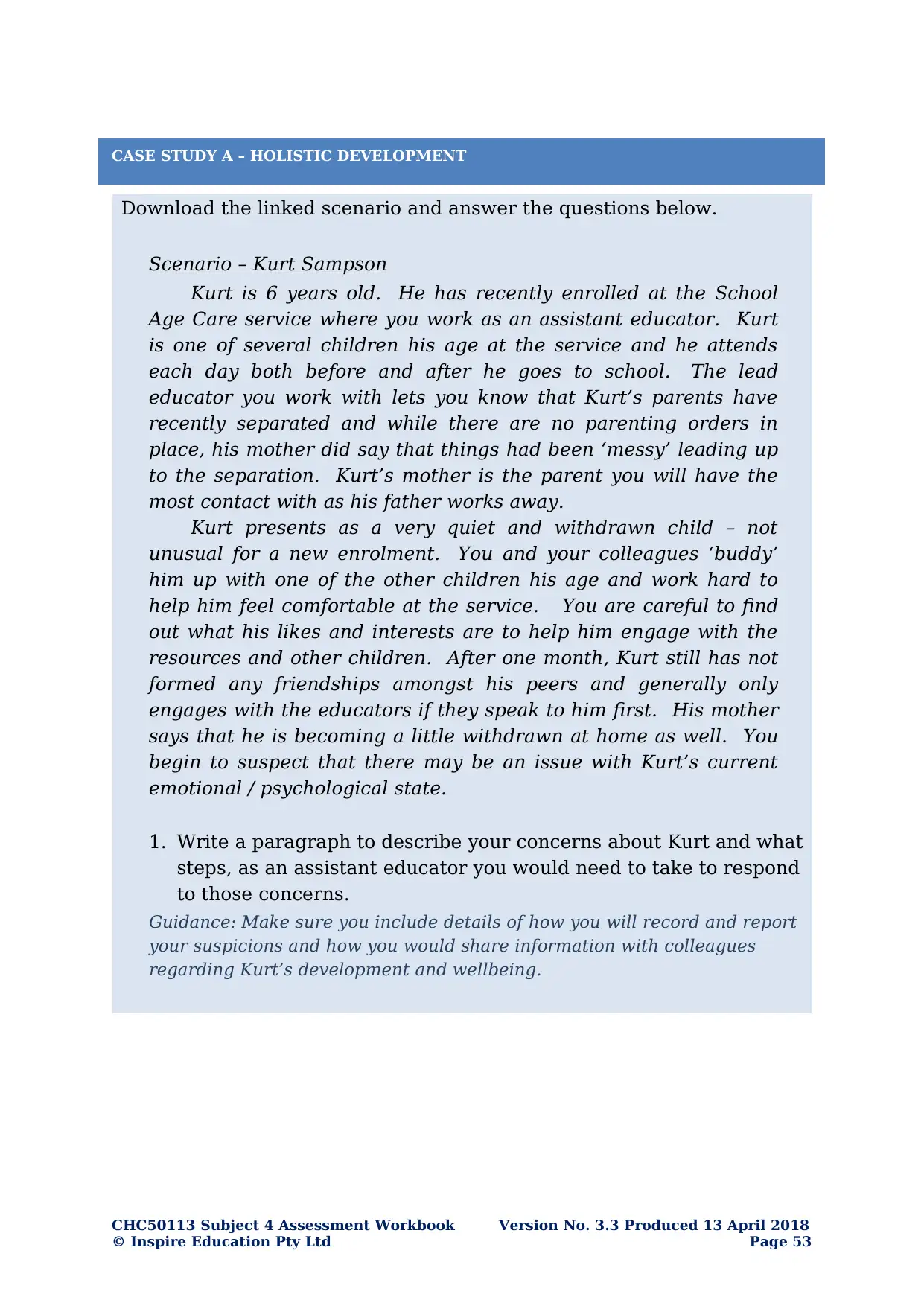
CASE STUDY A – HOLISTIC DEVELOPMENT
Download the linked scenario and answer the questions below.
Scenario – Kurt Sampson
Kurt is 6 years old. He has recently enrolled at the School
Age Care service where you work as an assistant educator. Kurt
is one of several children his age at the service and he attends
each day both before and after he goes to school. The lead
educator you work with lets you know that Kurt’s parents have
recently separated and while there are no parenting orders in
place, his mother did say that things had been ‘messy’ leading up
to the separation. Kurt’s mother is the parent you will have the
most contact with as his father works away.
Kurt presents as a very quiet and withdrawn child – not
unusual for a new enrolment. You and your colleagues ‘buddy’
him up with one of the other children his age and work hard to
help him feel comfortable at the service. You are careful to find
out what his likes and interests are to help him engage with the
resources and other children. After one month, Kurt still has not
formed any friendships amongst his peers and generally only
engages with the educators if they speak to him first. His mother
says that he is becoming a little withdrawn at home as well. You
begin to suspect that there may be an issue with Kurt’s current
emotional / psychological state.
1. Write a paragraph to describe your concerns about Kurt and what
steps, as an assistant educator you would need to take to respond
to those concerns.
Guidance: Make sure you include details of how you will record and report
your suspicions and how you would share information with colleagues
regarding Kurt’s development and wellbeing.
CHC50113 Subject 4 Assessment Workbook Version No. 3.3 Produced 13 April 2018
© Inspire Education Pty Ltd Page 53
Download the linked scenario and answer the questions below.
Scenario – Kurt Sampson
Kurt is 6 years old. He has recently enrolled at the School
Age Care service where you work as an assistant educator. Kurt
is one of several children his age at the service and he attends
each day both before and after he goes to school. The lead
educator you work with lets you know that Kurt’s parents have
recently separated and while there are no parenting orders in
place, his mother did say that things had been ‘messy’ leading up
to the separation. Kurt’s mother is the parent you will have the
most contact with as his father works away.
Kurt presents as a very quiet and withdrawn child – not
unusual for a new enrolment. You and your colleagues ‘buddy’
him up with one of the other children his age and work hard to
help him feel comfortable at the service. You are careful to find
out what his likes and interests are to help him engage with the
resources and other children. After one month, Kurt still has not
formed any friendships amongst his peers and generally only
engages with the educators if they speak to him first. His mother
says that he is becoming a little withdrawn at home as well. You
begin to suspect that there may be an issue with Kurt’s current
emotional / psychological state.
1. Write a paragraph to describe your concerns about Kurt and what
steps, as an assistant educator you would need to take to respond
to those concerns.
Guidance: Make sure you include details of how you will record and report
your suspicions and how you would share information with colleagues
regarding Kurt’s development and wellbeing.
CHC50113 Subject 4 Assessment Workbook Version No. 3.3 Produced 13 April 2018
© Inspire Education Pty Ltd Page 53
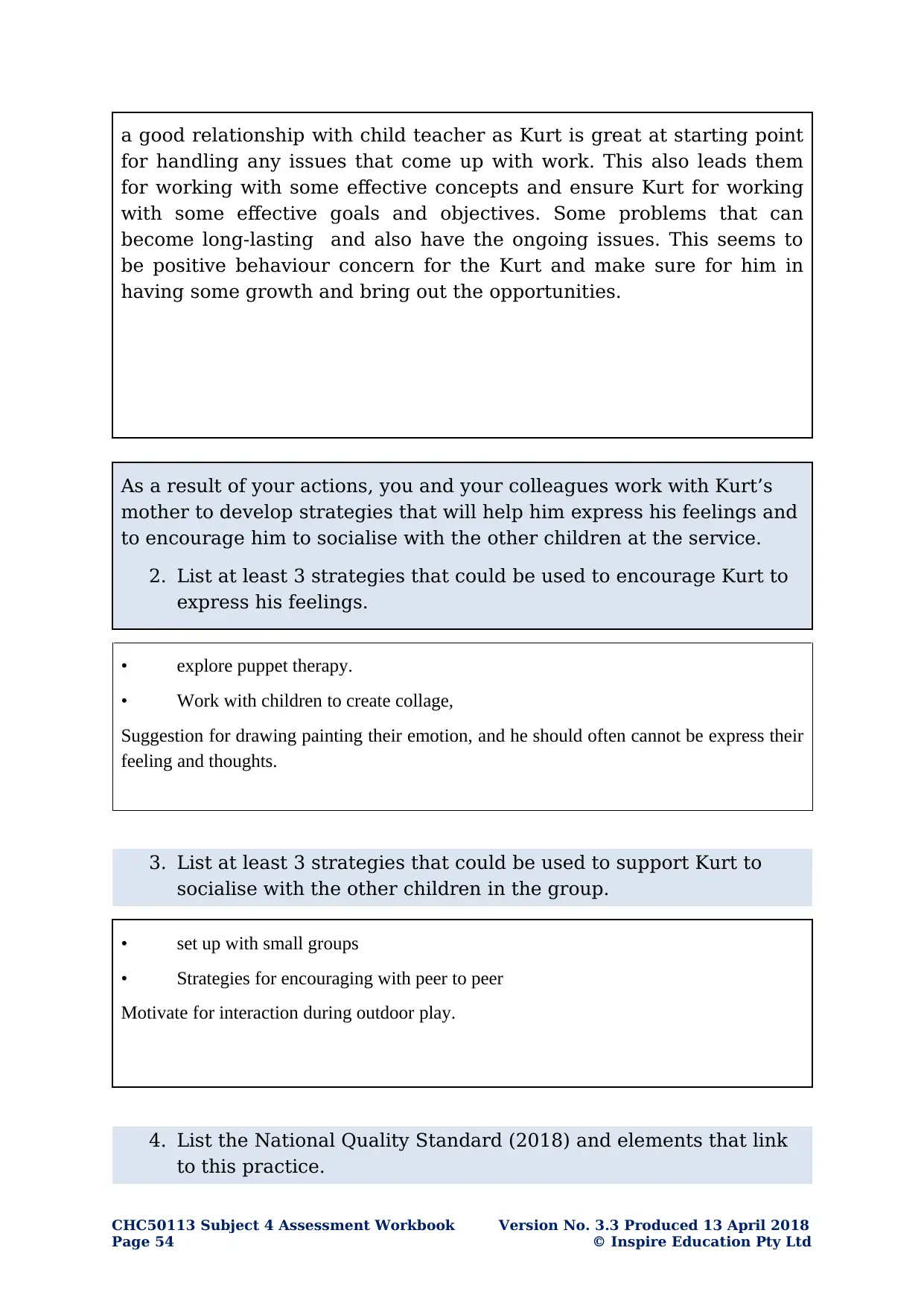
a good relationship with child teacher as Kurt is great at starting point
for handling any issues that come up with work. This also leads them
for working with some effective concepts and ensure Kurt for working
with some effective goals and objectives. Some problems that can
become long-lasting and also have the ongoing issues. This seems to
be positive behaviour concern for the Kurt and make sure for him in
having some growth and bring out the opportunities.
As a result of your actions, you and your colleagues work with Kurt’s
mother to develop strategies that will help him express his feelings and
to encourage him to socialise with the other children at the service.
2. List at least 3 strategies that could be used to encourage Kurt to
express his feelings.
• explore puppet therapy.
• Work with children to create collage,
Suggestion for drawing painting their emotion, and he should often cannot be express their
feeling and thoughts.
3. List at least 3 strategies that could be used to support Kurt to
socialise with the other children in the group.
• set up with small groups
• Strategies for encouraging with peer to peer
Motivate for interaction during outdoor play.
4. List the National Quality Standard (2018) and elements that link
to this practice.
CHC50113 Subject 4 Assessment Workbook Version No. 3.3 Produced 13 April 2018
Page 54 © Inspire Education Pty Ltd
for handling any issues that come up with work. This also leads them
for working with some effective concepts and ensure Kurt for working
with some effective goals and objectives. Some problems that can
become long-lasting and also have the ongoing issues. This seems to
be positive behaviour concern for the Kurt and make sure for him in
having some growth and bring out the opportunities.
As a result of your actions, you and your colleagues work with Kurt’s
mother to develop strategies that will help him express his feelings and
to encourage him to socialise with the other children at the service.
2. List at least 3 strategies that could be used to encourage Kurt to
express his feelings.
• explore puppet therapy.
• Work with children to create collage,
Suggestion for drawing painting their emotion, and he should often cannot be express their
feeling and thoughts.
3. List at least 3 strategies that could be used to support Kurt to
socialise with the other children in the group.
• set up with small groups
• Strategies for encouraging with peer to peer
Motivate for interaction during outdoor play.
4. List the National Quality Standard (2018) and elements that link
to this practice.
CHC50113 Subject 4 Assessment Workbook Version No. 3.3 Produced 13 April 2018
Page 54 © Inspire Education Pty Ltd

quality area 1- educational program and practices.
Quality area 2- children health and safety.
Quality area 3- physical environment.
5. State the code and the convention that applies in this situation.
the convention of the child who explains about their all rights and
responsibilities of government. All the rights which are being
concerned with having equally important and that cannot be taken
away from children. While this could him for having some effective
things and ensure them for working with surety and protect children
rights.
CHC50113 Subject 4 Assessment Workbook Version No. 3.3 Produced 13 April 2018
© Inspire Education Pty Ltd Page 55
Quality area 2- children health and safety.
Quality area 3- physical environment.
5. State the code and the convention that applies in this situation.
the convention of the child who explains about their all rights and
responsibilities of government. All the rights which are being
concerned with having equally important and that cannot be taken
away from children. While this could him for having some effective
things and ensure them for working with surety and protect children
rights.
CHC50113 Subject 4 Assessment Workbook Version No. 3.3 Produced 13 April 2018
© Inspire Education Pty Ltd Page 55
Paraphrase This Document
Need a fresh take? Get an instant paraphrase of this document with our AI Paraphraser
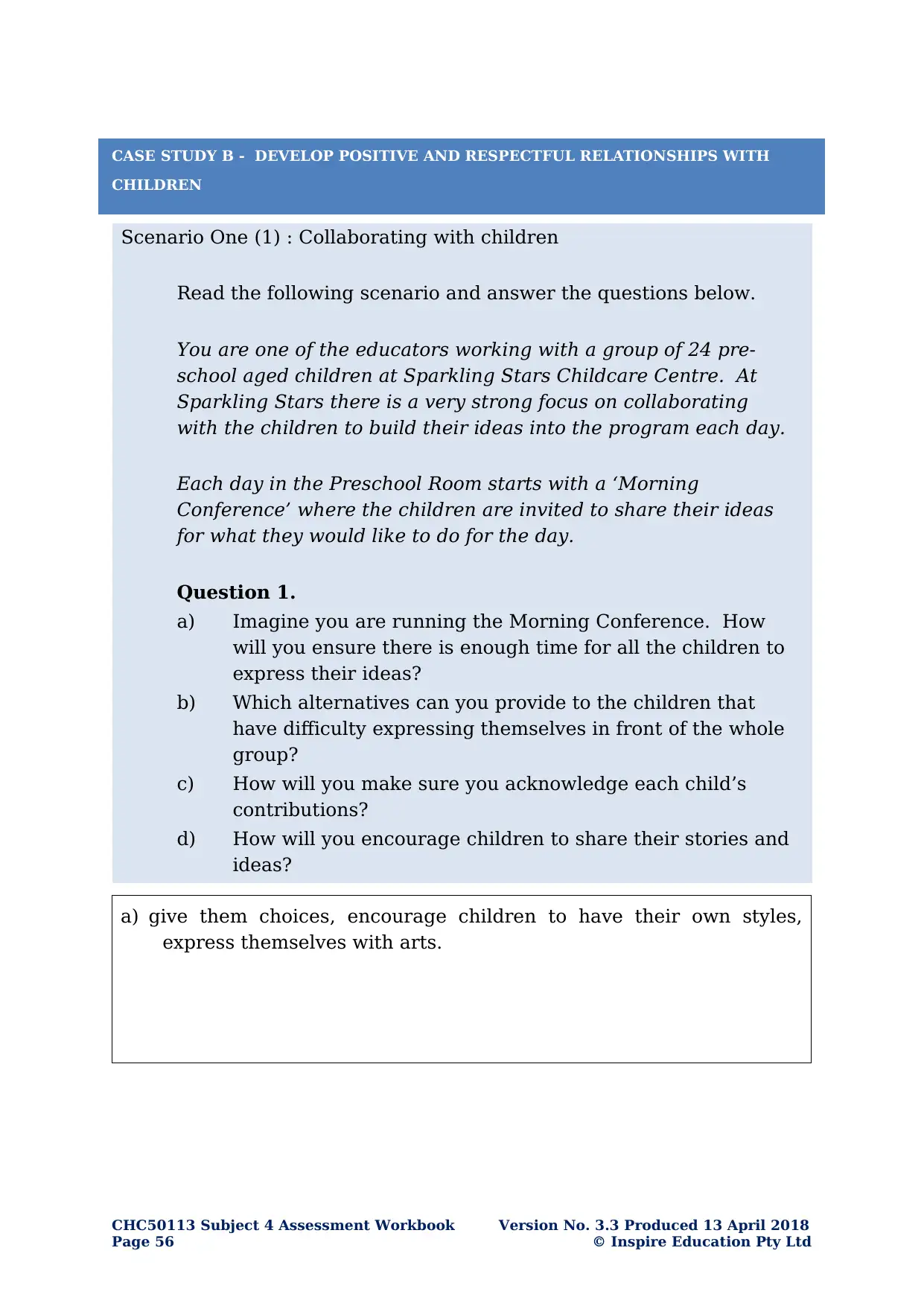
CASE STUDY B - DEVELOP POSITIVE AND RESPECTFUL RELATIONSHIPS WITH
CHILDREN
Scenario One (1) : Collaborating with children
Read the following scenario and answer the questions below.
You are one of the educators working with a group of 24 pre-
school aged children at Sparkling Stars Childcare Centre. At
Sparkling Stars there is a very strong focus on collaborating
with the children to build their ideas into the program each day.
Each day in the Preschool Room starts with a ‘Morning
Conference’ where the children are invited to share their ideas
for what they would like to do for the day.
Question 1.
a) Imagine you are running the Morning Conference. How
will you ensure there is enough time for all the children to
express their ideas?
b) Which alternatives can you provide to the children that
have difficulty expressing themselves in front of the whole
group?
c) How will you make sure you acknowledge each child’s
contributions?
d) How will you encourage children to share their stories and
ideas?
a) give them choices, encourage children to have their own styles,
express themselves with arts.
CHC50113 Subject 4 Assessment Workbook Version No. 3.3 Produced 13 April 2018
Page 56 © Inspire Education Pty Ltd
CHILDREN
Scenario One (1) : Collaborating with children
Read the following scenario and answer the questions below.
You are one of the educators working with a group of 24 pre-
school aged children at Sparkling Stars Childcare Centre. At
Sparkling Stars there is a very strong focus on collaborating
with the children to build their ideas into the program each day.
Each day in the Preschool Room starts with a ‘Morning
Conference’ where the children are invited to share their ideas
for what they would like to do for the day.
Question 1.
a) Imagine you are running the Morning Conference. How
will you ensure there is enough time for all the children to
express their ideas?
b) Which alternatives can you provide to the children that
have difficulty expressing themselves in front of the whole
group?
c) How will you make sure you acknowledge each child’s
contributions?
d) How will you encourage children to share their stories and
ideas?
a) give them choices, encourage children to have their own styles,
express themselves with arts.
CHC50113 Subject 4 Assessment Workbook Version No. 3.3 Produced 13 April 2018
Page 56 © Inspire Education Pty Ltd
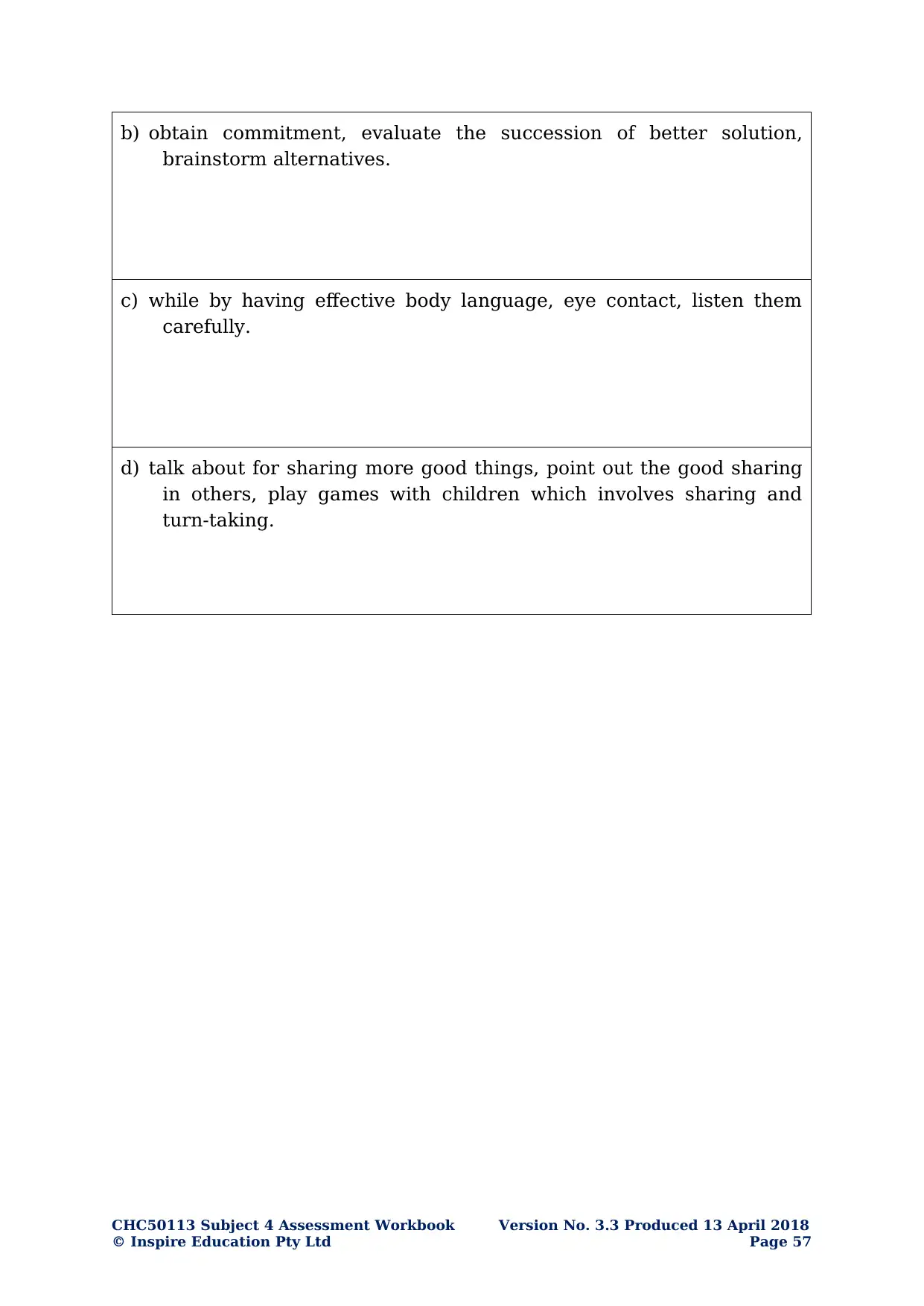
b) obtain commitment, evaluate the succession of better solution,
brainstorm alternatives.
c) while by having effective body language, eye contact, listen them
carefully.
d) talk about for sharing more good things, point out the good sharing
in others, play games with children which involves sharing and
turn-taking.
CHC50113 Subject 4 Assessment Workbook Version No. 3.3 Produced 13 April 2018
© Inspire Education Pty Ltd Page 57
brainstorm alternatives.
c) while by having effective body language, eye contact, listen them
carefully.
d) talk about for sharing more good things, point out the good sharing
in others, play games with children which involves sharing and
turn-taking.
CHC50113 Subject 4 Assessment Workbook Version No. 3.3 Produced 13 April 2018
© Inspire Education Pty Ltd Page 57
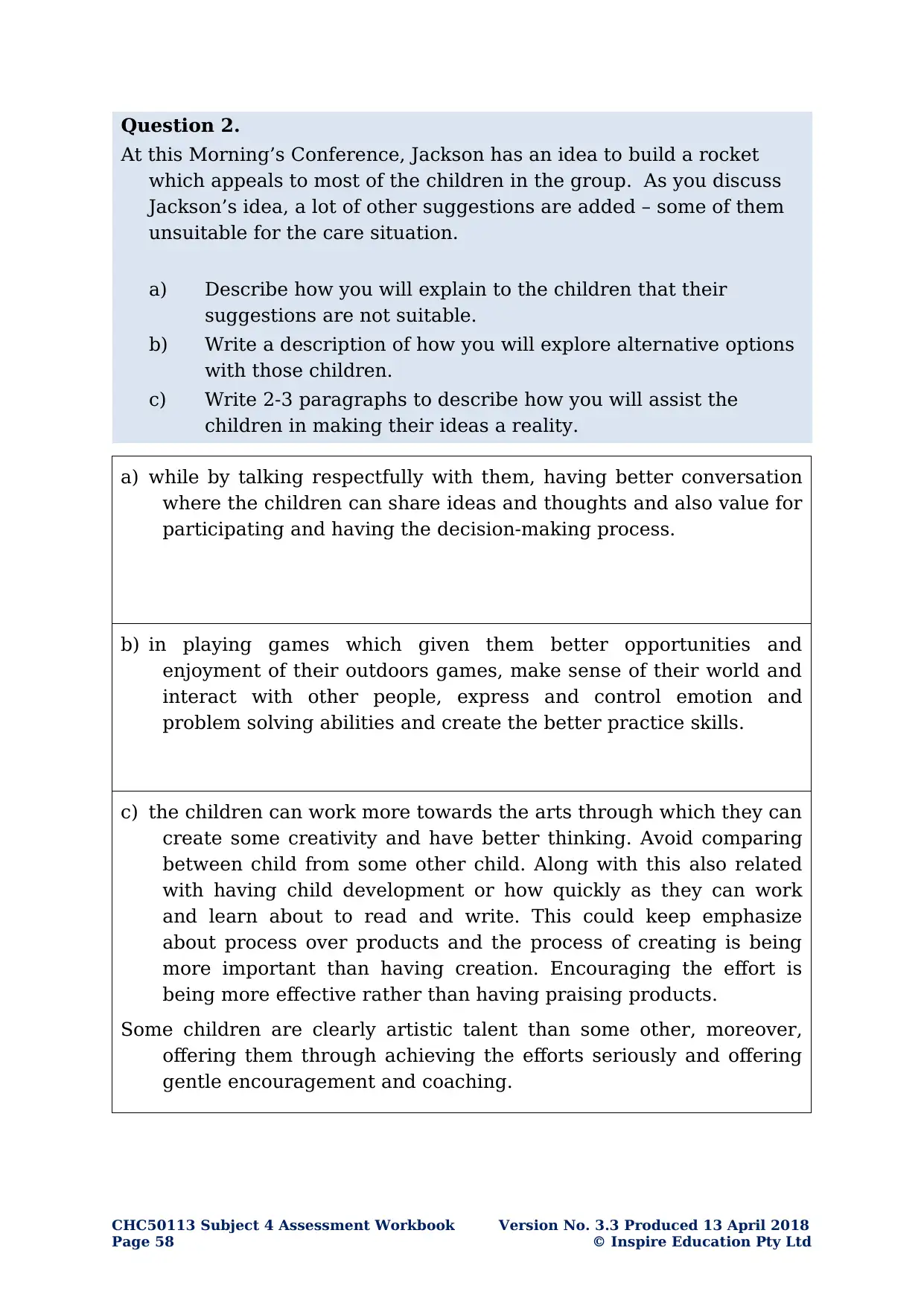
Question 2.
At this Morning’s Conference, Jackson has an idea to build a rocket
which appeals to most of the children in the group. As you discuss
Jackson’s idea, a lot of other suggestions are added – some of them
unsuitable for the care situation.
a) Describe how you will explain to the children that their
suggestions are not suitable.
b) Write a description of how you will explore alternative options
with those children.
c) Write 2-3 paragraphs to describe how you will assist the
children in making their ideas a reality.
a) while by talking respectfully with them, having better conversation
where the children can share ideas and thoughts and also value for
participating and having the decision-making process.
b) in playing games which given them better opportunities and
enjoyment of their outdoors games, make sense of their world and
interact with other people, express and control emotion and
problem solving abilities and create the better practice skills.
c) the children can work more towards the arts through which they can
create some creativity and have better thinking. Avoid comparing
between child from some other child. Along with this also related
with having child development or how quickly as they can work
and learn about to read and write. This could keep emphasize
about process over products and the process of creating is being
more important than having creation. Encouraging the effort is
being more effective rather than having praising products.
Some children are clearly artistic talent than some other, moreover,
offering them through achieving the efforts seriously and offering
gentle encouragement and coaching.
CHC50113 Subject 4 Assessment Workbook Version No. 3.3 Produced 13 April 2018
Page 58 © Inspire Education Pty Ltd
At this Morning’s Conference, Jackson has an idea to build a rocket
which appeals to most of the children in the group. As you discuss
Jackson’s idea, a lot of other suggestions are added – some of them
unsuitable for the care situation.
a) Describe how you will explain to the children that their
suggestions are not suitable.
b) Write a description of how you will explore alternative options
with those children.
c) Write 2-3 paragraphs to describe how you will assist the
children in making their ideas a reality.
a) while by talking respectfully with them, having better conversation
where the children can share ideas and thoughts and also value for
participating and having the decision-making process.
b) in playing games which given them better opportunities and
enjoyment of their outdoors games, make sense of their world and
interact with other people, express and control emotion and
problem solving abilities and create the better practice skills.
c) the children can work more towards the arts through which they can
create some creativity and have better thinking. Avoid comparing
between child from some other child. Along with this also related
with having child development or how quickly as they can work
and learn about to read and write. This could keep emphasize
about process over products and the process of creating is being
more important than having creation. Encouraging the effort is
being more effective rather than having praising products.
Some children are clearly artistic talent than some other, moreover,
offering them through achieving the efforts seriously and offering
gentle encouragement and coaching.
CHC50113 Subject 4 Assessment Workbook Version No. 3.3 Produced 13 April 2018
Page 58 © Inspire Education Pty Ltd
Secure Best Marks with AI Grader
Need help grading? Try our AI Grader for instant feedback on your assignments.
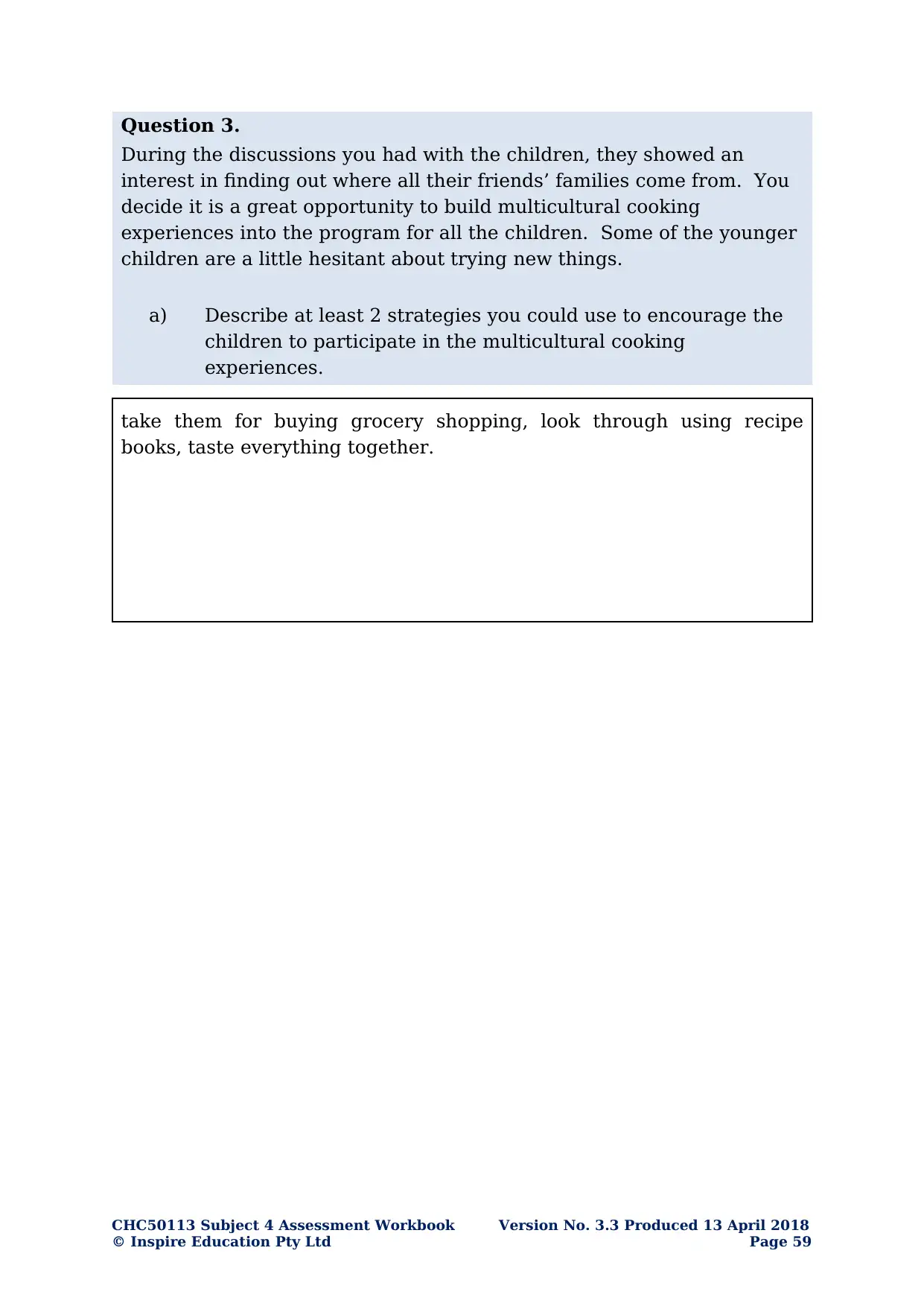
Question 3.
During the discussions you had with the children, they showed an
interest in finding out where all their friends’ families come from. You
decide it is a great opportunity to build multicultural cooking
experiences into the program for all the children. Some of the younger
children are a little hesitant about trying new things.
a) Describe at least 2 strategies you could use to encourage the
children to participate in the multicultural cooking
experiences.
take them for buying grocery shopping, look through using recipe
books, taste everything together.
CHC50113 Subject 4 Assessment Workbook Version No. 3.3 Produced 13 April 2018
© Inspire Education Pty Ltd Page 59
During the discussions you had with the children, they showed an
interest in finding out where all their friends’ families come from. You
decide it is a great opportunity to build multicultural cooking
experiences into the program for all the children. Some of the younger
children are a little hesitant about trying new things.
a) Describe at least 2 strategies you could use to encourage the
children to participate in the multicultural cooking
experiences.
take them for buying grocery shopping, look through using recipe
books, taste everything together.
CHC50113 Subject 4 Assessment Workbook Version No. 3.3 Produced 13 April 2018
© Inspire Education Pty Ltd Page 59

CASE STUDY C – UNDERSTANDING CHILDREN BEHAVIOUR
Meet Jake. Jake is now 5 years old. He just
started going to Sparkling Stars Childcare
Centre and has been assigned to your care.
You had a talk with his mother, Emilia, to learn
more about Jake. You found out that Emilia had
just separated with her husband after several
years in an abusive relationship. She had serious
concerns for Jake’s safety and how it was
impacting him, and decided it was best for them to move out.
Now Emilia is taking care of Jake on her own as she works full-time as an
admin assistant for an accounting firm. She often has to work until late and
has arranged for the school bus to send Jake to the childcare centre after
his school until she can pick him up on her way home from work.
Scenario 1:
Despite what he has gone through, Jake is a happy and playful kid. He likes
being around other kids and has no problems meeting new people.
However, during his first week at the centre, it was observed that Jake has
violent tendencies when having disagreements with the other kids in the
centre.
He was caught hitting another kid and using bad language while fighting
over some Lego blocks. You have had a talk to Jake about his behavior and
how it is not right to use violence and bad words, however, he started to
panic in fear of being punished for his bad behaviour. His heartbeat
started to race and he started to breathe heavily and sweat profusely. He
stopped responding to your questions until he calmed down a few minutes
after the incident.
1.1 This behaviour raised your concern and made you decide to discuss it
with your supervisor. Simulate a dialogue with your supervisor by
creating a video recording of yourself discussing your concerns
about Jake. You may do it as a monologue or you may invite a friend
to play the part of your supervisor. Keep your recording less than 5
minutes long.
Guidance:
To ensure successful completion of the relevant requirements for this task,
include the following information in your discussion:
CHC50113 Subject 4 Assessment Workbook Version No. 3.3 Produced 13 April 2018
Page 60 © Inspire Education Pty Ltd
Meet Jake. Jake is now 5 years old. He just
started going to Sparkling Stars Childcare
Centre and has been assigned to your care.
You had a talk with his mother, Emilia, to learn
more about Jake. You found out that Emilia had
just separated with her husband after several
years in an abusive relationship. She had serious
concerns for Jake’s safety and how it was
impacting him, and decided it was best for them to move out.
Now Emilia is taking care of Jake on her own as she works full-time as an
admin assistant for an accounting firm. She often has to work until late and
has arranged for the school bus to send Jake to the childcare centre after
his school until she can pick him up on her way home from work.
Scenario 1:
Despite what he has gone through, Jake is a happy and playful kid. He likes
being around other kids and has no problems meeting new people.
However, during his first week at the centre, it was observed that Jake has
violent tendencies when having disagreements with the other kids in the
centre.
He was caught hitting another kid and using bad language while fighting
over some Lego blocks. You have had a talk to Jake about his behavior and
how it is not right to use violence and bad words, however, he started to
panic in fear of being punished for his bad behaviour. His heartbeat
started to race and he started to breathe heavily and sweat profusely. He
stopped responding to your questions until he calmed down a few minutes
after the incident.
1.1 This behaviour raised your concern and made you decide to discuss it
with your supervisor. Simulate a dialogue with your supervisor by
creating a video recording of yourself discussing your concerns
about Jake. You may do it as a monologue or you may invite a friend
to play the part of your supervisor. Keep your recording less than 5
minutes long.
Guidance:
To ensure successful completion of the relevant requirements for this task,
include the following information in your discussion:
CHC50113 Subject 4 Assessment Workbook Version No. 3.3 Produced 13 April 2018
Page 60 © Inspire Education Pty Ltd
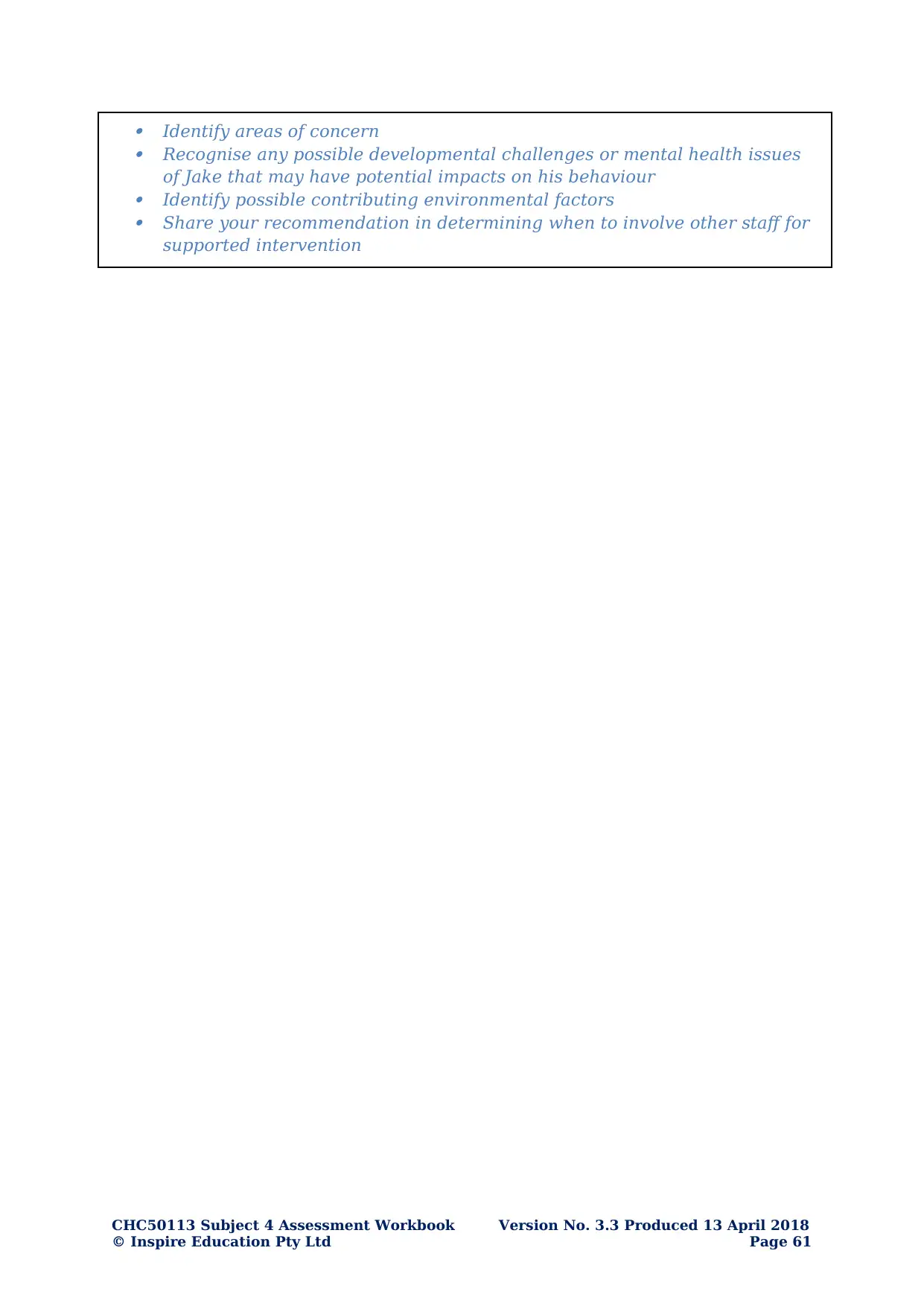
Identify areas of concern
Recognise any possible developmental challenges or mental health issues
of Jake that may have potential impacts on his behaviour
Identify possible contributing environmental factors
Share your recommendation in determining when to involve other staff for
supported intervention
CHC50113 Subject 4 Assessment Workbook Version No. 3.3 Produced 13 April 2018
© Inspire Education Pty Ltd Page 61
Recognise any possible developmental challenges or mental health issues
of Jake that may have potential impacts on his behaviour
Identify possible contributing environmental factors
Share your recommendation in determining when to involve other staff for
supported intervention
CHC50113 Subject 4 Assessment Workbook Version No. 3.3 Produced 13 April 2018
© Inspire Education Pty Ltd Page 61
Paraphrase This Document
Need a fresh take? Get an instant paraphrase of this document with our AI Paraphraser
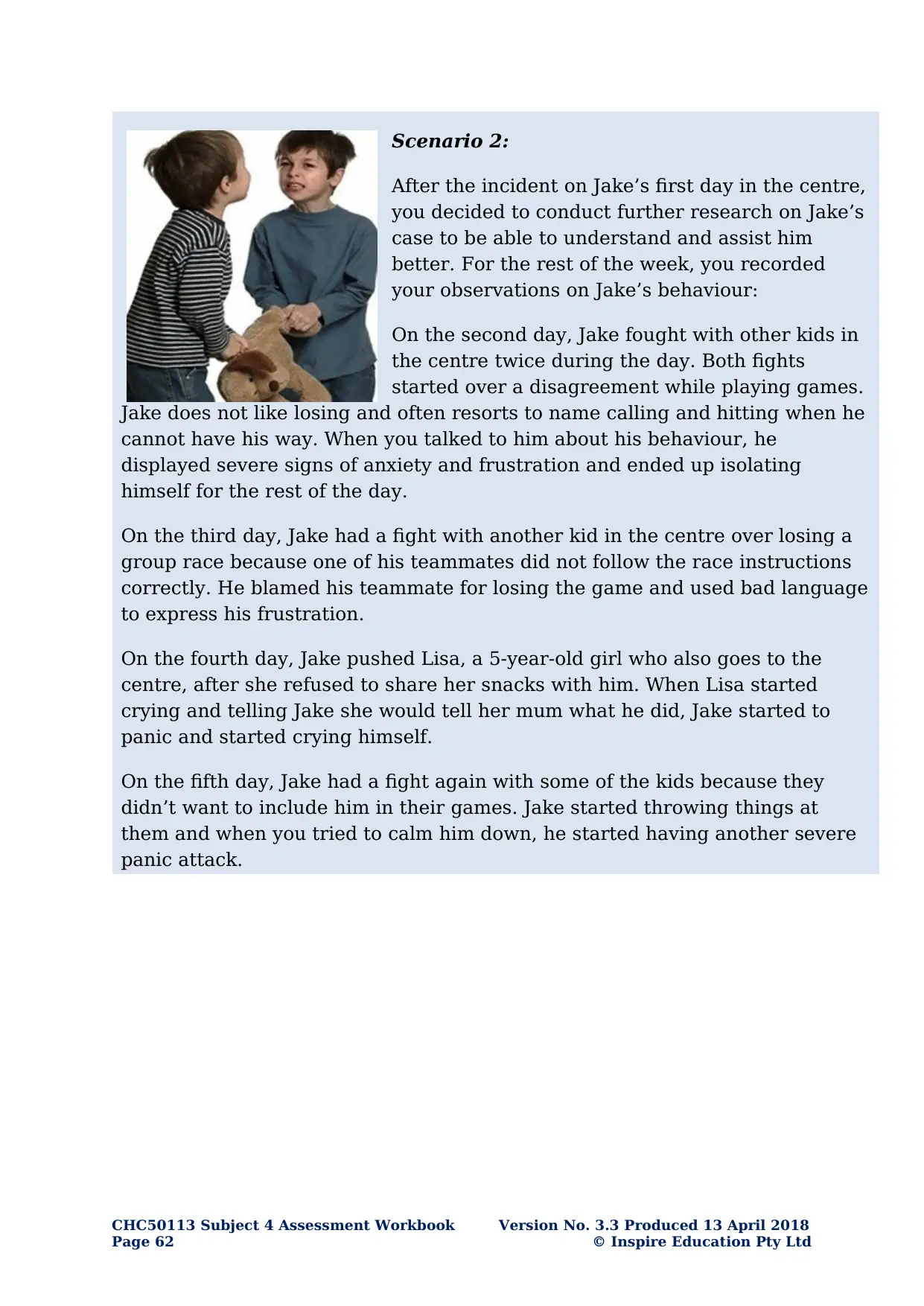
Scenario 2:
After the incident on Jake’s first day in the centre,
you decided to conduct further research on Jake’s
case to be able to understand and assist him
better. For the rest of the week, you recorded
your observations on Jake’s behaviour:
On the second day, Jake fought with other kids in
the centre twice during the day. Both fights
started over a disagreement while playing games.
Jake does not like losing and often resorts to name calling and hitting when he
cannot have his way. When you talked to him about his behaviour, he
displayed severe signs of anxiety and frustration and ended up isolating
himself for the rest of the day.
On the third day, Jake had a fight with another kid in the centre over losing a
group race because one of his teammates did not follow the race instructions
correctly. He blamed his teammate for losing the game and used bad language
to express his frustration.
On the fourth day, Jake pushed Lisa, a 5-year-old girl who also goes to the
centre, after she refused to share her snacks with him. When Lisa started
crying and telling Jake she would tell her mum what he did, Jake started to
panic and started crying himself.
On the fifth day, Jake had a fight again with some of the kids because they
didn’t want to include him in their games. Jake started throwing things at
them and when you tried to calm him down, he started having another severe
panic attack.
CHC50113 Subject 4 Assessment Workbook Version No. 3.3 Produced 13 April 2018
Page 62 © Inspire Education Pty Ltd
After the incident on Jake’s first day in the centre,
you decided to conduct further research on Jake’s
case to be able to understand and assist him
better. For the rest of the week, you recorded
your observations on Jake’s behaviour:
On the second day, Jake fought with other kids in
the centre twice during the day. Both fights
started over a disagreement while playing games.
Jake does not like losing and often resorts to name calling and hitting when he
cannot have his way. When you talked to him about his behaviour, he
displayed severe signs of anxiety and frustration and ended up isolating
himself for the rest of the day.
On the third day, Jake had a fight with another kid in the centre over losing a
group race because one of his teammates did not follow the race instructions
correctly. He blamed his teammate for losing the game and used bad language
to express his frustration.
On the fourth day, Jake pushed Lisa, a 5-year-old girl who also goes to the
centre, after she refused to share her snacks with him. When Lisa started
crying and telling Jake she would tell her mum what he did, Jake started to
panic and started crying himself.
On the fifth day, Jake had a fight again with some of the kids because they
didn’t want to include him in their games. Jake started throwing things at
them and when you tried to calm him down, he started having another severe
panic attack.
CHC50113 Subject 4 Assessment Workbook Version No. 3.3 Produced 13 April 2018
Page 62 © Inspire Education Pty Ltd
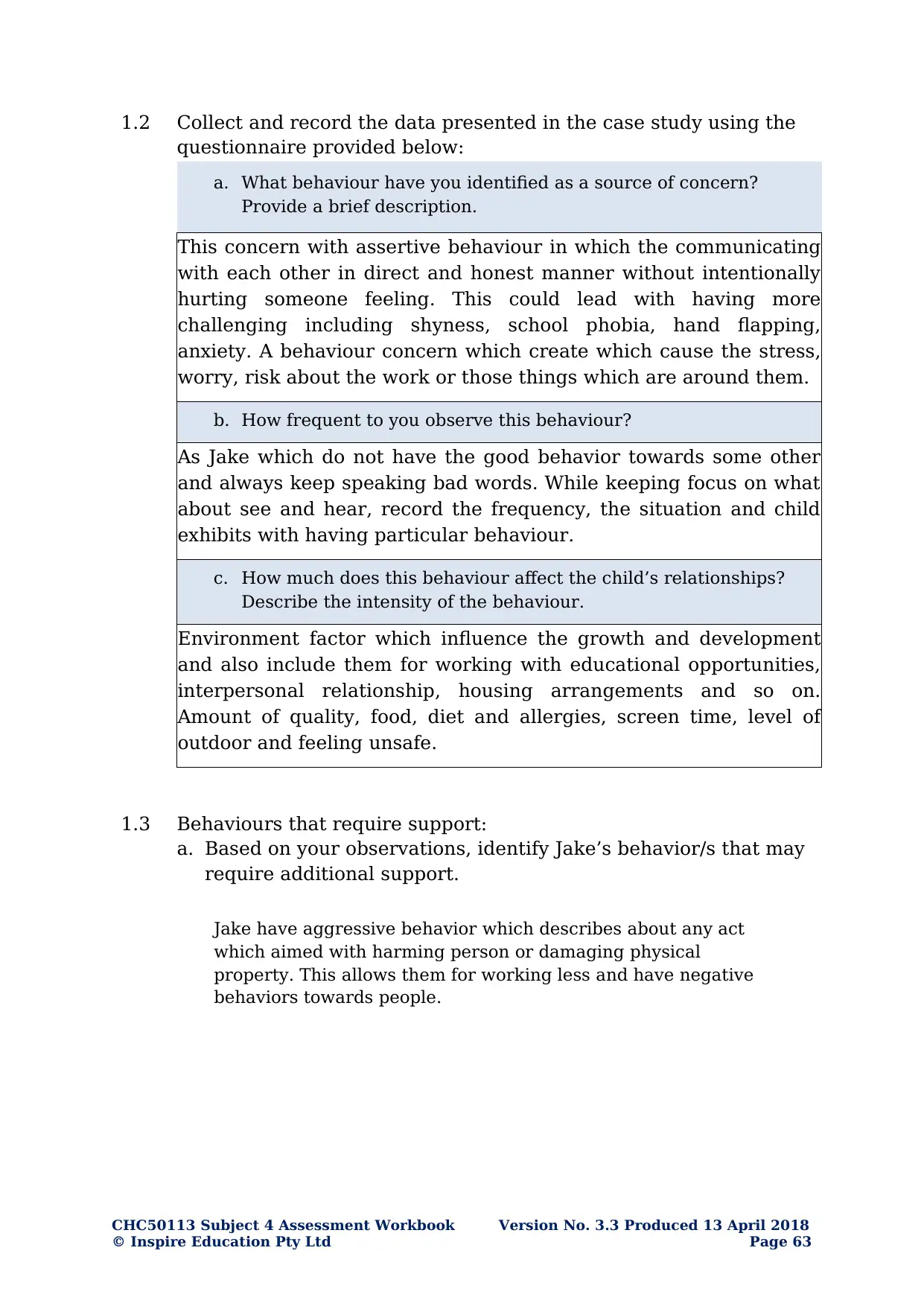
1.2 Collect and record the data presented in the case study using the
questionnaire provided below:
a. What behaviour have you identified as a source of concern?
Provide a brief description.
This concern with assertive behaviour in which the communicating
with each other in direct and honest manner without intentionally
hurting someone feeling. This could lead with having more
challenging including shyness, school phobia, hand flapping,
anxiety. A behaviour concern which create which cause the stress,
worry, risk about the work or those things which are around them.
b. How frequent to you observe this behaviour?
As Jake which do not have the good behavior towards some other
and always keep speaking bad words. While keeping focus on what
about see and hear, record the frequency, the situation and child
exhibits with having particular behaviour.
c. How much does this behaviour affect the child’s relationships?
Describe the intensity of the behaviour.
Environment factor which influence the growth and development
and also include them for working with educational opportunities,
interpersonal relationship, housing arrangements and so on.
Amount of quality, food, diet and allergies, screen time, level of
outdoor and feeling unsafe.
1.3 Behaviours that require support:
a. Based on your observations, identify Jake’s behavior/s that may
require additional support.
Jake have aggressive behavior which describes about any act
which aimed with harming person or damaging physical
property. This allows them for working less and have negative
behaviors towards people.
CHC50113 Subject 4 Assessment Workbook Version No. 3.3 Produced 13 April 2018
© Inspire Education Pty Ltd Page 63
questionnaire provided below:
a. What behaviour have you identified as a source of concern?
Provide a brief description.
This concern with assertive behaviour in which the communicating
with each other in direct and honest manner without intentionally
hurting someone feeling. This could lead with having more
challenging including shyness, school phobia, hand flapping,
anxiety. A behaviour concern which create which cause the stress,
worry, risk about the work or those things which are around them.
b. How frequent to you observe this behaviour?
As Jake which do not have the good behavior towards some other
and always keep speaking bad words. While keeping focus on what
about see and hear, record the frequency, the situation and child
exhibits with having particular behaviour.
c. How much does this behaviour affect the child’s relationships?
Describe the intensity of the behaviour.
Environment factor which influence the growth and development
and also include them for working with educational opportunities,
interpersonal relationship, housing arrangements and so on.
Amount of quality, food, diet and allergies, screen time, level of
outdoor and feeling unsafe.
1.3 Behaviours that require support:
a. Based on your observations, identify Jake’s behavior/s that may
require additional support.
Jake have aggressive behavior which describes about any act
which aimed with harming person or damaging physical
property. This allows them for working less and have negative
behaviors towards people.
CHC50113 Subject 4 Assessment Workbook Version No. 3.3 Produced 13 April 2018
© Inspire Education Pty Ltd Page 63
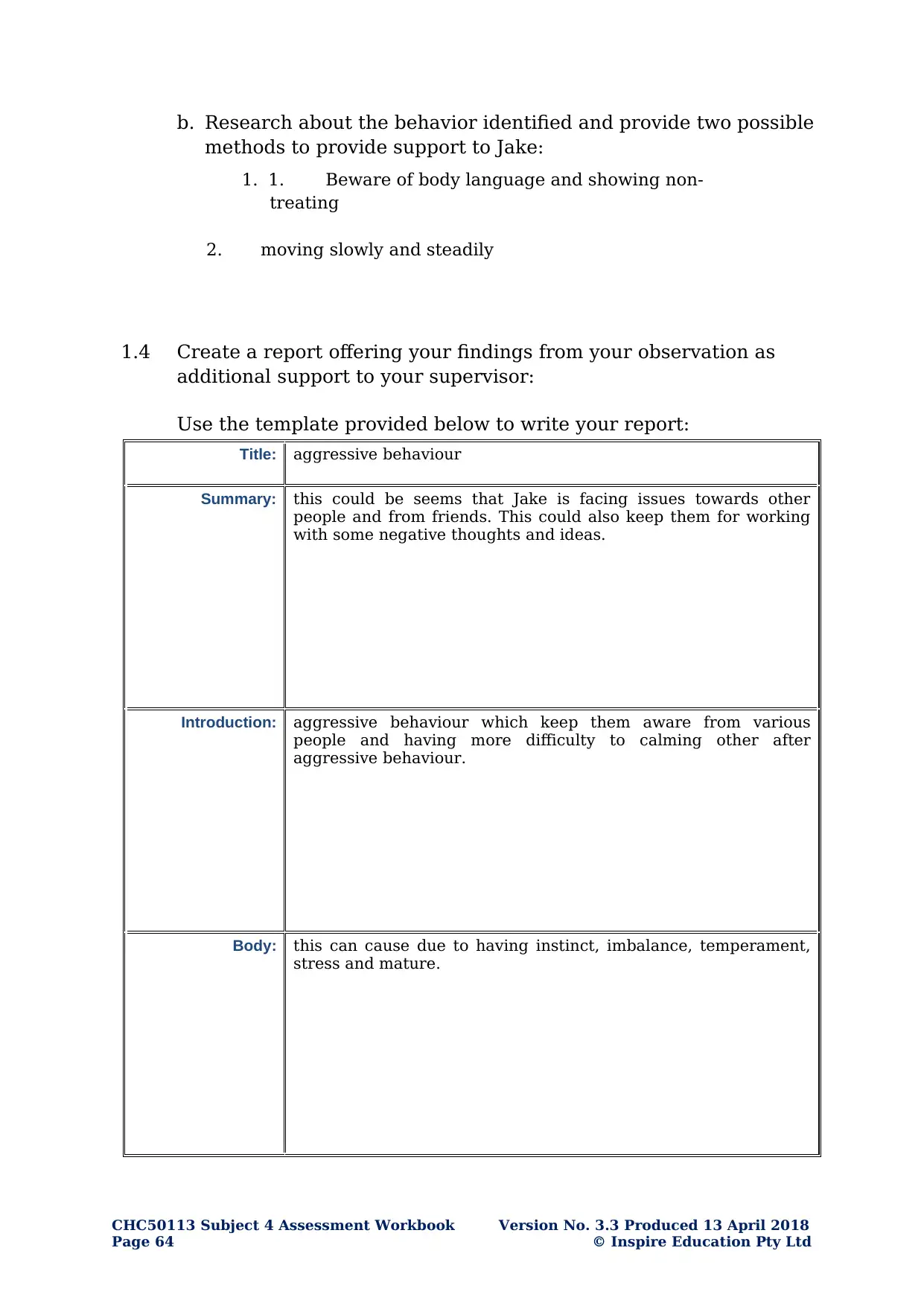
b. Research about the behavior identified and provide two possible
methods to provide support to Jake:
1. 1. Beware of body language and showing non-
treating
2. moving slowly and steadily
1.4 Create a report offering your findings from your observation as
additional support to your supervisor:
Use the template provided below to write your report:
Title: aggressive behaviour
Summary: this could be seems that Jake is facing issues towards other
people and from friends. This could also keep them for working
with some negative thoughts and ideas.
Introduction: aggressive behaviour which keep them aware from various
people and having more difficulty to calming other after
aggressive behaviour.
Body: this can cause due to having instinct, imbalance, temperament,
stress and mature.
CHC50113 Subject 4 Assessment Workbook Version No. 3.3 Produced 13 April 2018
Page 64 © Inspire Education Pty Ltd
methods to provide support to Jake:
1. 1. Beware of body language and showing non-
treating
2. moving slowly and steadily
1.4 Create a report offering your findings from your observation as
additional support to your supervisor:
Use the template provided below to write your report:
Title: aggressive behaviour
Summary: this could be seems that Jake is facing issues towards other
people and from friends. This could also keep them for working
with some negative thoughts and ideas.
Introduction: aggressive behaviour which keep them aware from various
people and having more difficulty to calming other after
aggressive behaviour.
Body: this can cause due to having instinct, imbalance, temperament,
stress and mature.
CHC50113 Subject 4 Assessment Workbook Version No. 3.3 Produced 13 April 2018
Page 64 © Inspire Education Pty Ltd
Secure Best Marks with AI Grader
Need help grading? Try our AI Grader for instant feedback on your assignments.
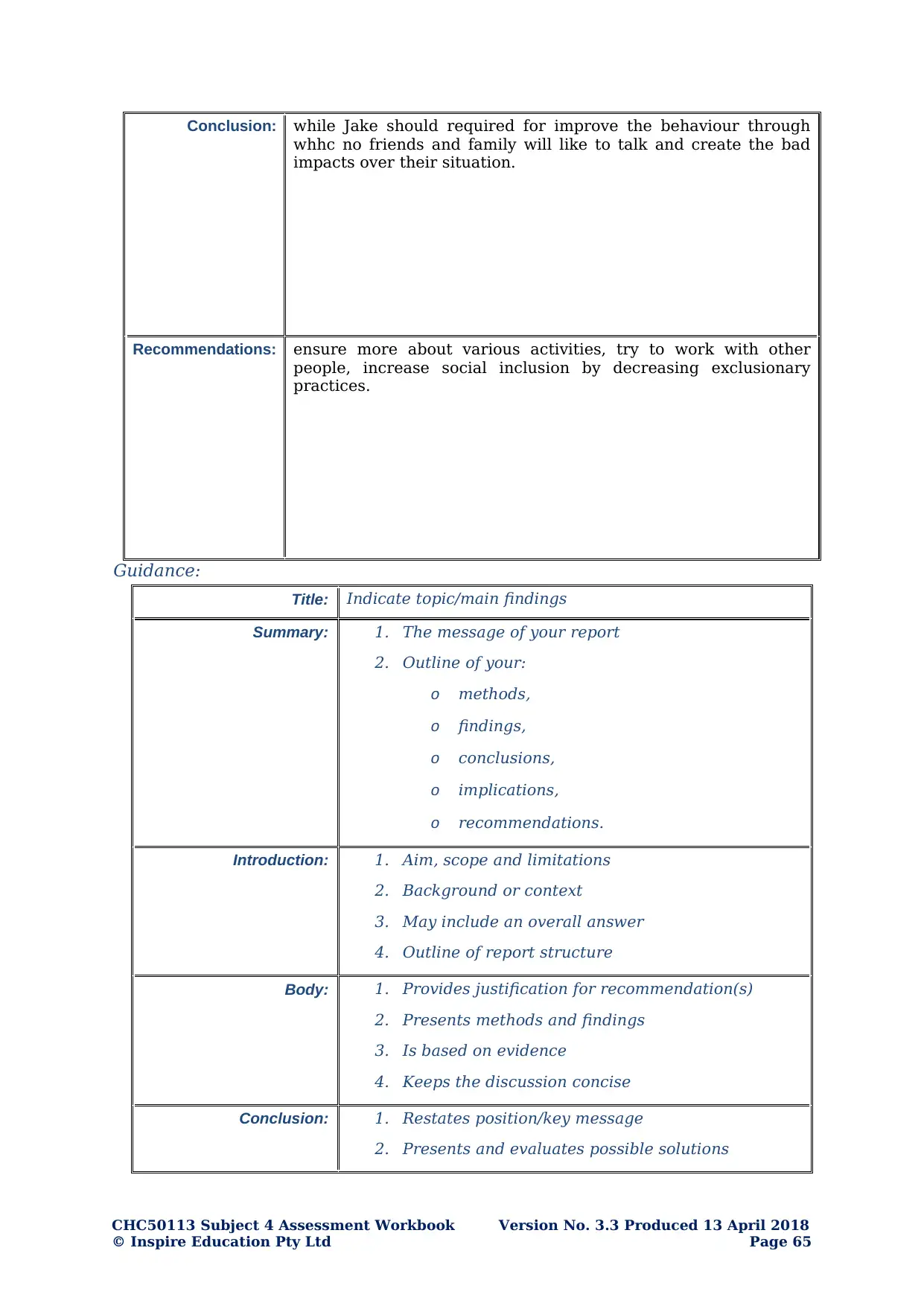
Conclusion: while Jake should required for improve the behaviour through
whhc no friends and family will like to talk and create the bad
impacts over their situation.
Recommendations: ensure more about various activities, try to work with other
people, increase social inclusion by decreasing exclusionary
practices.
Guidance:
Title: Indicate topic/main findings
Summary: 1. The message of your report
2. Outline of your:
o methods,
o findings,
o conclusions,
o implications,
o recommendations.
Introduction: 1. Aim, scope and limitations
2. Background or context
3. May include an overall answer
4. Outline of report structure
Body: 1. Provides justification for recommendation(s)
2. Presents methods and findings
3. Is based on evidence
4. Keeps the discussion concise
Conclusion: 1. Restates position/key message
2. Presents and evaluates possible solutions
CHC50113 Subject 4 Assessment Workbook Version No. 3.3 Produced 13 April 2018
© Inspire Education Pty Ltd Page 65
whhc no friends and family will like to talk and create the bad
impacts over their situation.
Recommendations: ensure more about various activities, try to work with other
people, increase social inclusion by decreasing exclusionary
practices.
Guidance:
Title: Indicate topic/main findings
Summary: 1. The message of your report
2. Outline of your:
o methods,
o findings,
o conclusions,
o implications,
o recommendations.
Introduction: 1. Aim, scope and limitations
2. Background or context
3. May include an overall answer
4. Outline of report structure
Body: 1. Provides justification for recommendation(s)
2. Presents methods and findings
3. Is based on evidence
4. Keeps the discussion concise
Conclusion: 1. Restates position/key message
2. Presents and evaluates possible solutions
CHC50113 Subject 4 Assessment Workbook Version No. 3.3 Produced 13 April 2018
© Inspire Education Pty Ltd Page 65

Recommendations: Suggests appropriate policy/actions
CHC50113 Subject 4 Assessment Workbook Version No. 3.3 Produced 13 April 2018
Page 66 © Inspire Education Pty Ltd
CHC50113 Subject 4 Assessment Workbook Version No. 3.3 Produced 13 April 2018
Page 66 © Inspire Education Pty Ltd
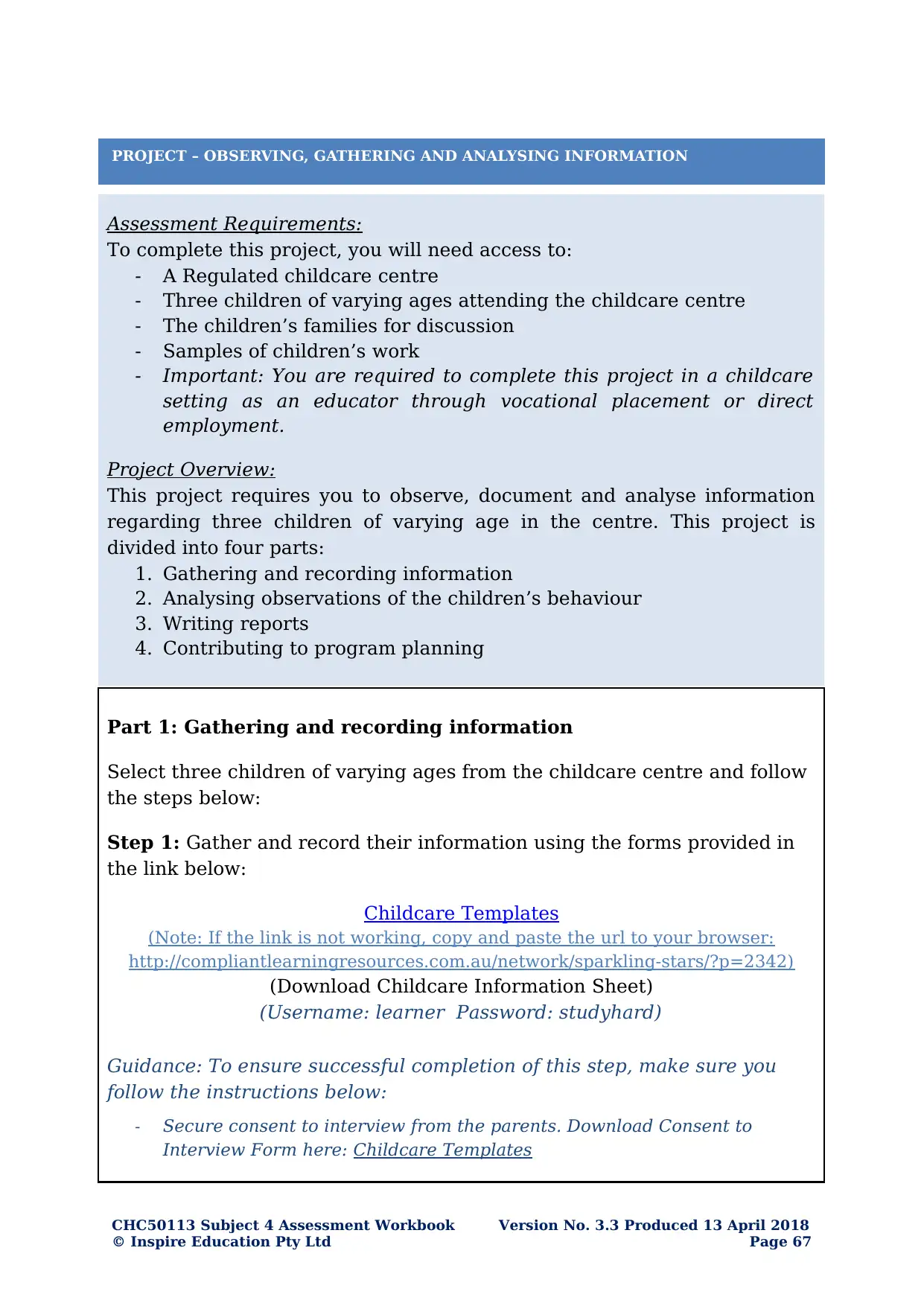
PROJECT – OBSERVING, GATHERING AND ANALYSING INFORMATION
Assessment Requirements:
To complete this project, you will need access to:
- A Regulated childcare centre
- Three children of varying ages attending the childcare centre
- The children’s families for discussion
- Samples of children’s work
- Important: You are required to complete this project in a childcare
setting as an educator through vocational placement or direct
employment.
Project Overview:
This project requires you to observe, document and analyse information
regarding three children of varying age in the centre. This project is
divided into four parts:
1. Gathering and recording information
2. Analysing observations of the children’s behaviour
3. Writing reports
4. Contributing to program planning
Part 1: Gathering and recording information
Select three children of varying ages from the childcare centre and follow
the steps below:
Step 1: Gather and record their information using the forms provided in
the link below:
Childcare Templates
(Note: If the link is not working, copy and paste the url to your browser:
http://compliantlearningresources.com.au/network/sparkling-stars/?p=2342)
(Download Childcare Information Sheet)
(Username: learner Password: studyhard)
Guidance: To ensure successful completion of this step, make sure you
follow the instructions below:
- Secure consent to interview from the parents. Download Consent to
Interview Form here: Childcare Templates
CHC50113 Subject 4 Assessment Workbook Version No. 3.3 Produced 13 April 2018
© Inspire Education Pty Ltd Page 67
Assessment Requirements:
To complete this project, you will need access to:
- A Regulated childcare centre
- Three children of varying ages attending the childcare centre
- The children’s families for discussion
- Samples of children’s work
- Important: You are required to complete this project in a childcare
setting as an educator through vocational placement or direct
employment.
Project Overview:
This project requires you to observe, document and analyse information
regarding three children of varying age in the centre. This project is
divided into four parts:
1. Gathering and recording information
2. Analysing observations of the children’s behaviour
3. Writing reports
4. Contributing to program planning
Part 1: Gathering and recording information
Select three children of varying ages from the childcare centre and follow
the steps below:
Step 1: Gather and record their information using the forms provided in
the link below:
Childcare Templates
(Note: If the link is not working, copy and paste the url to your browser:
http://compliantlearningresources.com.au/network/sparkling-stars/?p=2342)
(Download Childcare Information Sheet)
(Username: learner Password: studyhard)
Guidance: To ensure successful completion of this step, make sure you
follow the instructions below:
- Secure consent to interview from the parents. Download Consent to
Interview Form here: Childcare Templates
CHC50113 Subject 4 Assessment Workbook Version No. 3.3 Produced 13 April 2018
© Inspire Education Pty Ltd Page 67
Paraphrase This Document
Need a fresh take? Get an instant paraphrase of this document with our AI Paraphraser

- Interview parents of three children attending the childcare centre
- The three children must be of varying age
- One form must be completed for each child
- Submit the completed forms with this workbook
Step 2: Talk and interact with the children and record your observations.
For children 2 years old and above:
- Give the child drawing supplies (ensure drawing supplies are child-
friendly)
- Have the child draw a picture.
- Have the child describe and explain the drawing.
- During the entire exercise make sure to jot down your observations
regarding the child’s personality and behaviour
- Scan the child’s work and save it in his records
Use the form provided in the link below to record your observations:
Childcare Templates
(http://compliantlearningresources.com.au/network/sparkling-stars/?p=2342)
(download Child Observation Form A)
(Username: learner Password: studyhard)
For infants to 1 year old:
With the assistance of the parent, interact with the child and record your
observations based on:
- Anecdotal information
- Stories/Accounts from the parent
Use the form provided in the link below to record your observations:
Childcare Templates
(http://compliantlearningresources.com.au/network/sparkling-stars/?p=2342)
(download Child Observation Form B)
(Username: learner Password: studyhard)
CHC50113 Subject 4 Assessment Workbook Version No. 3.3 Produced 13 April 2018
Page 68 © Inspire Education Pty Ltd
- The three children must be of varying age
- One form must be completed for each child
- Submit the completed forms with this workbook
Step 2: Talk and interact with the children and record your observations.
For children 2 years old and above:
- Give the child drawing supplies (ensure drawing supplies are child-
friendly)
- Have the child draw a picture.
- Have the child describe and explain the drawing.
- During the entire exercise make sure to jot down your observations
regarding the child’s personality and behaviour
- Scan the child’s work and save it in his records
Use the form provided in the link below to record your observations:
Childcare Templates
(http://compliantlearningresources.com.au/network/sparkling-stars/?p=2342)
(download Child Observation Form A)
(Username: learner Password: studyhard)
For infants to 1 year old:
With the assistance of the parent, interact with the child and record your
observations based on:
- Anecdotal information
- Stories/Accounts from the parent
Use the form provided in the link below to record your observations:
Childcare Templates
(http://compliantlearningresources.com.au/network/sparkling-stars/?p=2342)
(download Child Observation Form B)
(Username: learner Password: studyhard)
CHC50113 Subject 4 Assessment Workbook Version No. 3.3 Produced 13 April 2018
Page 68 © Inspire Education Pty Ltd
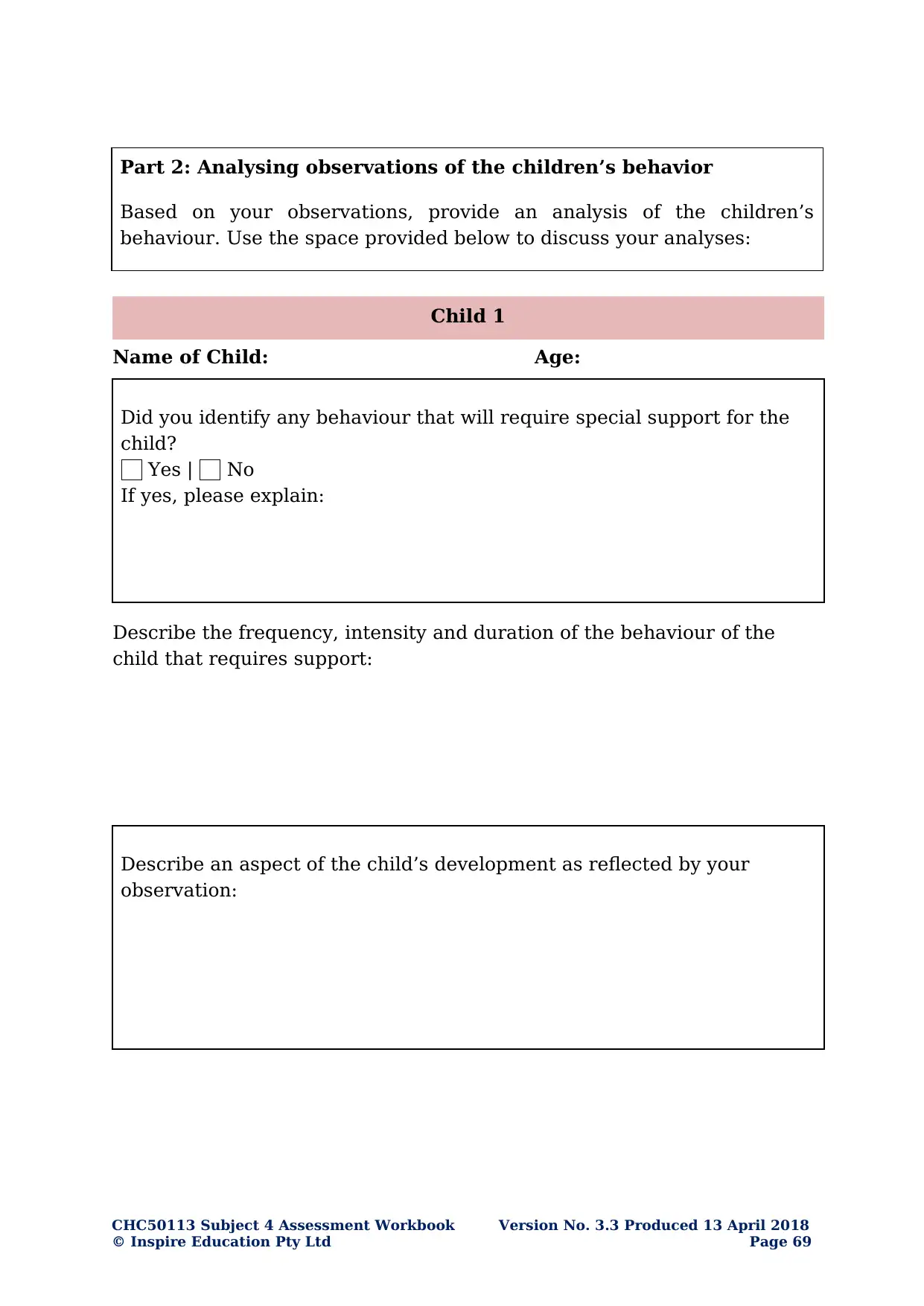
Part 2: Analysing observations of the children’s behavior
Based on your observations, provide an analysis of the children’s
behaviour. Use the space provided below to discuss your analyses:
Child 1
Name of Child: Age:
Did you identify any behaviour that will require special support for the
child?
Yes | No
If yes, please explain:
Describe the frequency, intensity and duration of the behaviour of the
child that requires support:
Describe an aspect of the child’s development as reflected by your
observation:
CHC50113 Subject 4 Assessment Workbook Version No. 3.3 Produced 13 April 2018
© Inspire Education Pty Ltd Page 69
Based on your observations, provide an analysis of the children’s
behaviour. Use the space provided below to discuss your analyses:
Child 1
Name of Child: Age:
Did you identify any behaviour that will require special support for the
child?
Yes | No
If yes, please explain:
Describe the frequency, intensity and duration of the behaviour of the
child that requires support:
Describe an aspect of the child’s development as reflected by your
observation:
CHC50113 Subject 4 Assessment Workbook Version No. 3.3 Produced 13 April 2018
© Inspire Education Pty Ltd Page 69
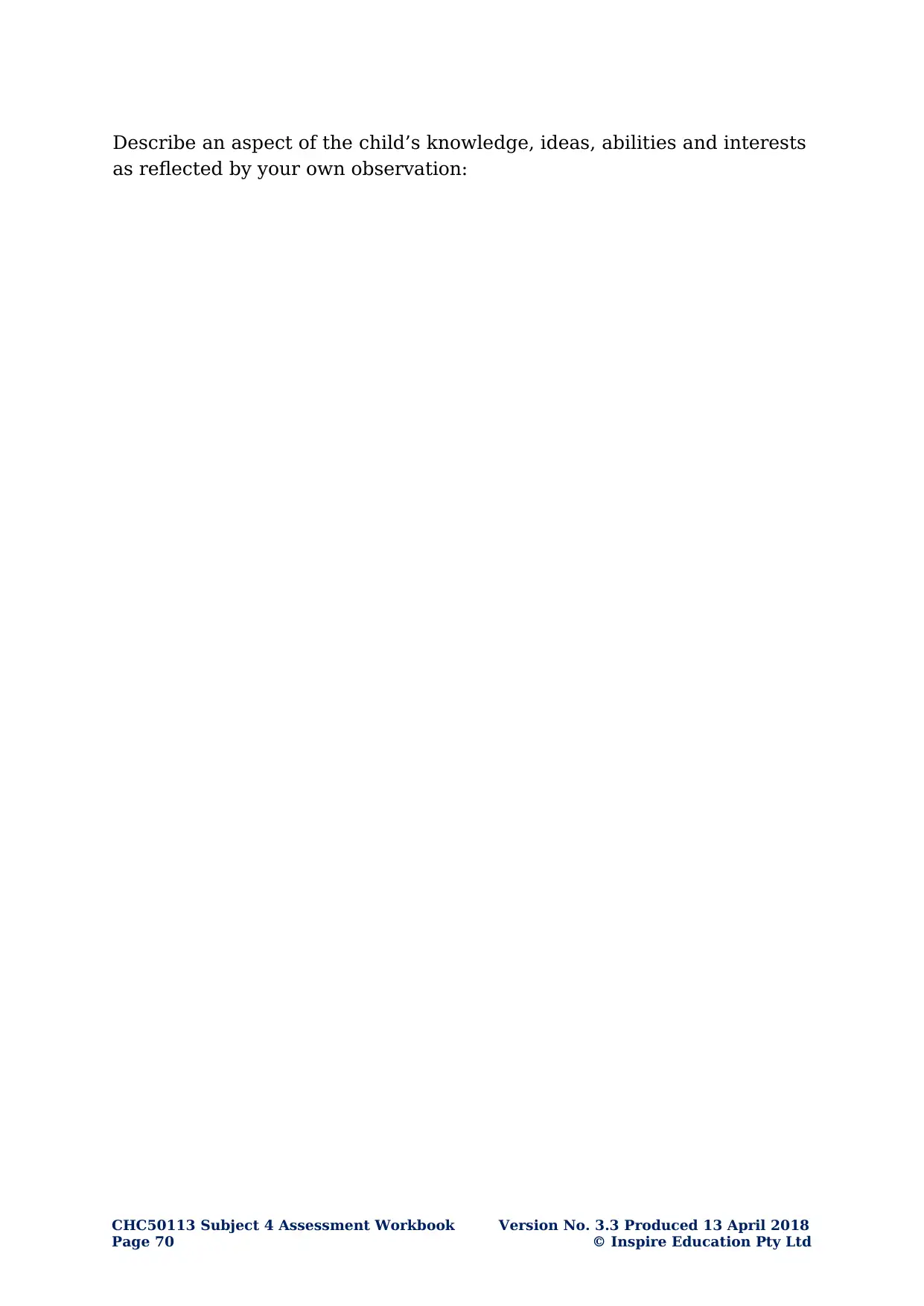
Describe an aspect of the child’s knowledge, ideas, abilities and interests
as reflected by your own observation:
CHC50113 Subject 4 Assessment Workbook Version No. 3.3 Produced 13 April 2018
Page 70 © Inspire Education Pty Ltd
as reflected by your own observation:
CHC50113 Subject 4 Assessment Workbook Version No. 3.3 Produced 13 April 2018
Page 70 © Inspire Education Pty Ltd
Secure Best Marks with AI Grader
Need help grading? Try our AI Grader for instant feedback on your assignments.
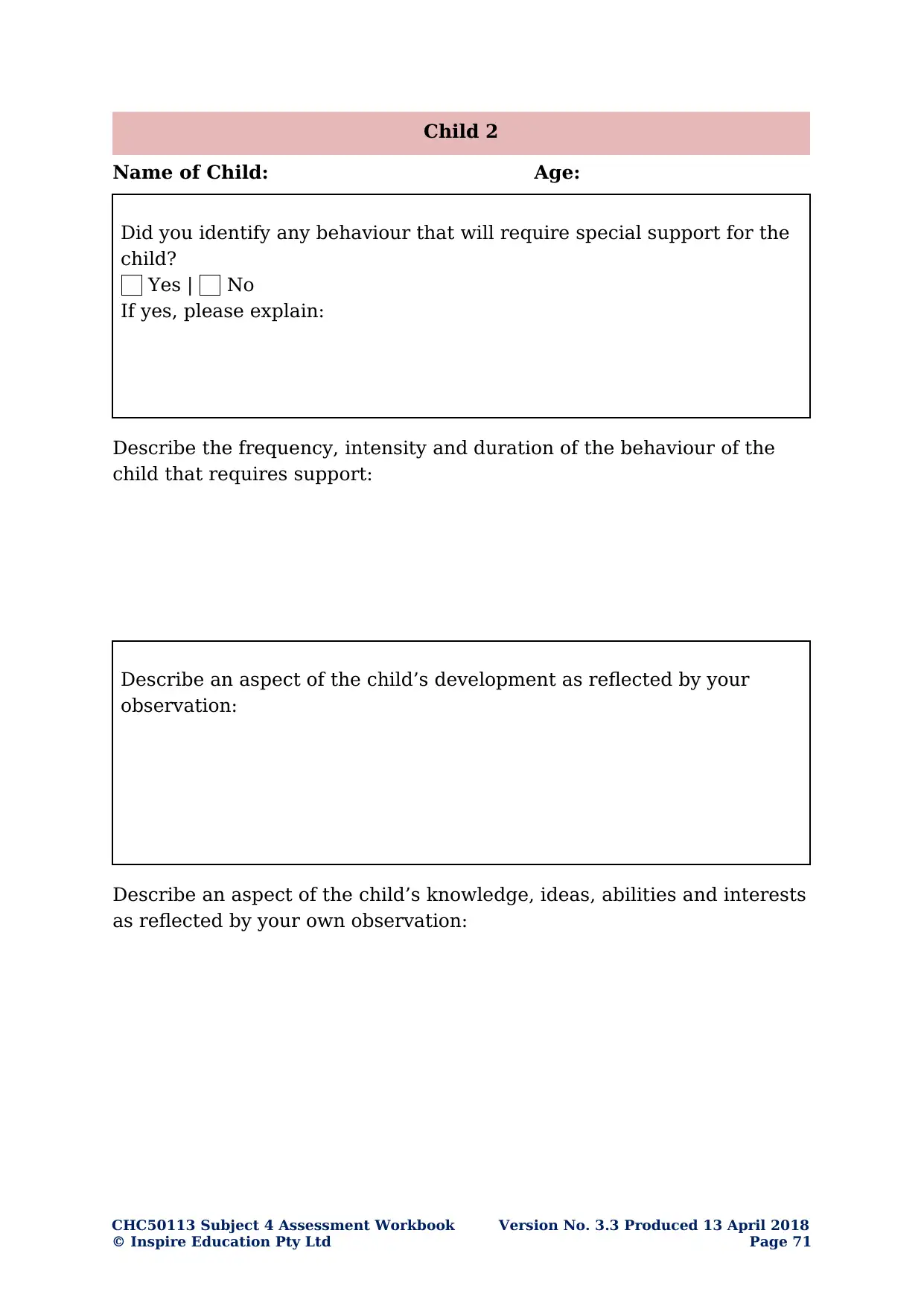
Child 2
Name of Child: Age:
Did you identify any behaviour that will require special support for the
child?
Yes | No
If yes, please explain:
Describe the frequency, intensity and duration of the behaviour of the
child that requires support:
Describe an aspect of the child’s development as reflected by your
observation:
Describe an aspect of the child’s knowledge, ideas, abilities and interests
as reflected by your own observation:
CHC50113 Subject 4 Assessment Workbook Version No. 3.3 Produced 13 April 2018
© Inspire Education Pty Ltd Page 71
Name of Child: Age:
Did you identify any behaviour that will require special support for the
child?
Yes | No
If yes, please explain:
Describe the frequency, intensity and duration of the behaviour of the
child that requires support:
Describe an aspect of the child’s development as reflected by your
observation:
Describe an aspect of the child’s knowledge, ideas, abilities and interests
as reflected by your own observation:
CHC50113 Subject 4 Assessment Workbook Version No. 3.3 Produced 13 April 2018
© Inspire Education Pty Ltd Page 71
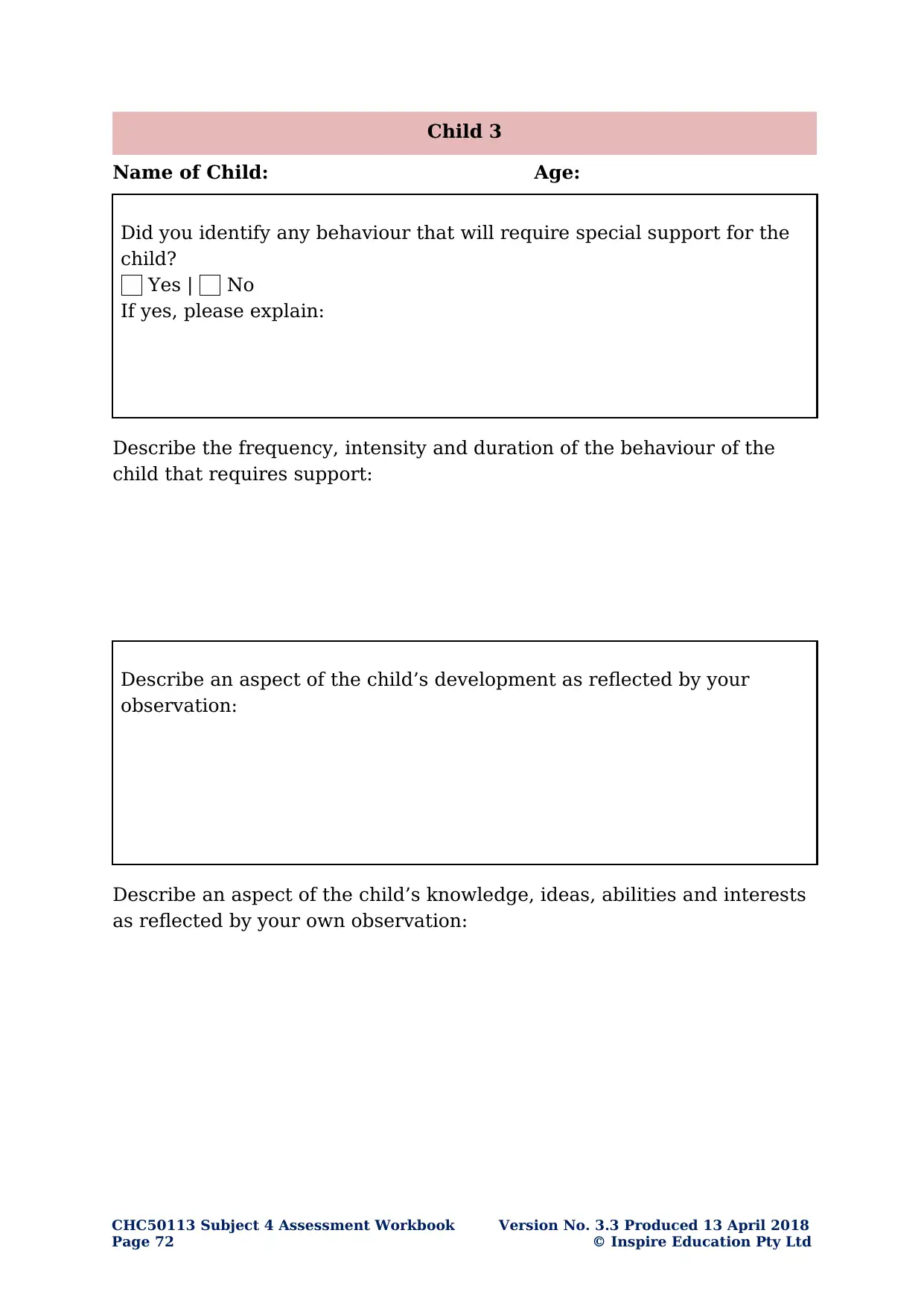
Child 3
Name of Child: Age:
Did you identify any behaviour that will require special support for the
child?
Yes | No
If yes, please explain:
Describe the frequency, intensity and duration of the behaviour of the
child that requires support:
Describe an aspect of the child’s development as reflected by your
observation:
Describe an aspect of the child’s knowledge, ideas, abilities and interests
as reflected by your own observation:
CHC50113 Subject 4 Assessment Workbook Version No. 3.3 Produced 13 April 2018
Page 72 © Inspire Education Pty Ltd
Name of Child: Age:
Did you identify any behaviour that will require special support for the
child?
Yes | No
If yes, please explain:
Describe the frequency, intensity and duration of the behaviour of the
child that requires support:
Describe an aspect of the child’s development as reflected by your
observation:
Describe an aspect of the child’s knowledge, ideas, abilities and interests
as reflected by your own observation:
CHC50113 Subject 4 Assessment Workbook Version No. 3.3 Produced 13 April 2018
Page 72 © Inspire Education Pty Ltd
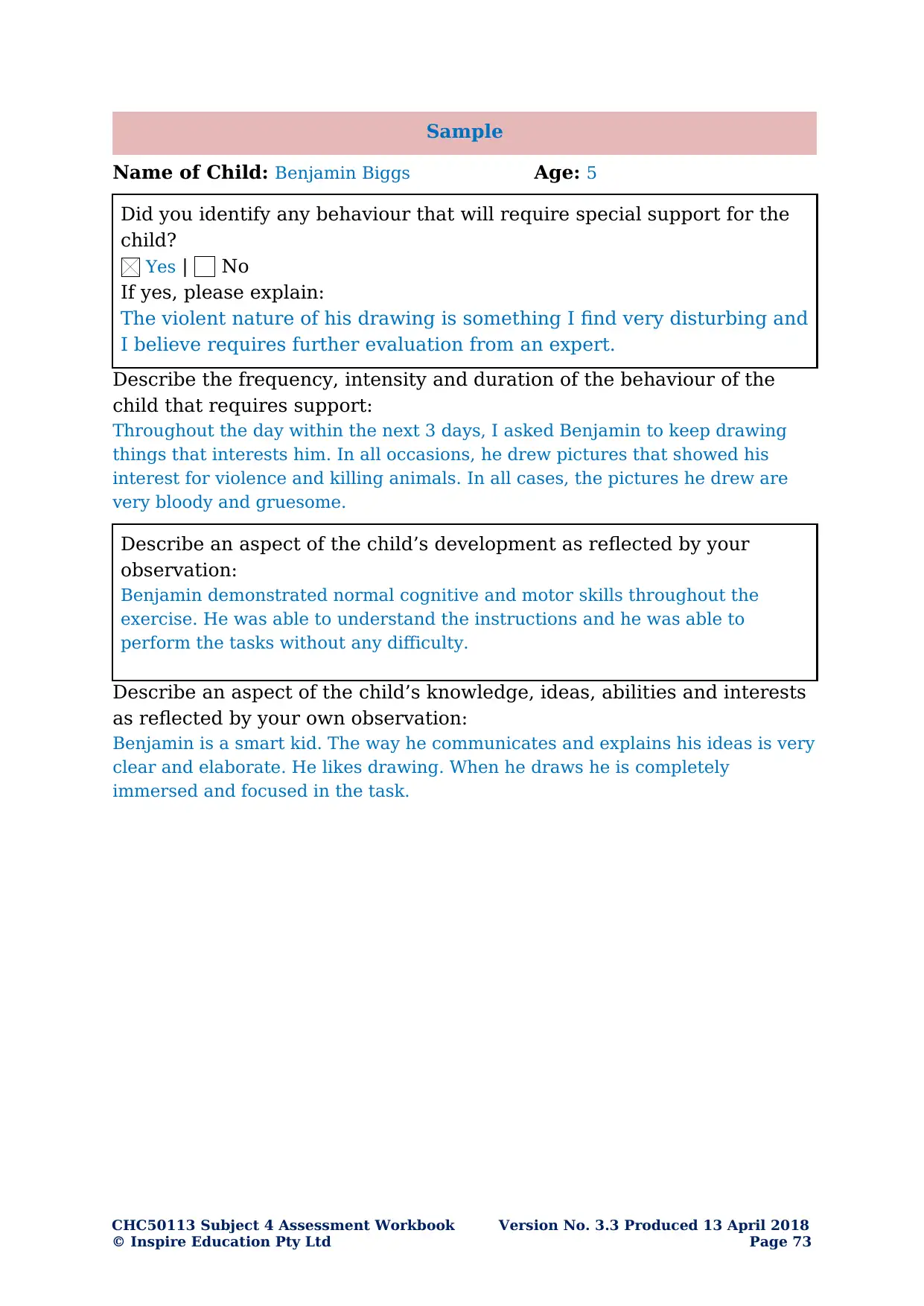
Sample
Name of Child: Benjamin Biggs Age: 5
Did you identify any behaviour that will require special support for the
child?
Yes | No
If yes, please explain:
The violent nature of his drawing is something I find very disturbing and
I believe requires further evaluation from an expert.
Describe the frequency, intensity and duration of the behaviour of the
child that requires support:
Throughout the day within the next 3 days, I asked Benjamin to keep drawing
things that interests him. In all occasions, he drew pictures that showed his
interest for violence and killing animals. In all cases, the pictures he drew are
very bloody and gruesome.
Describe an aspect of the child’s development as reflected by your
observation:
Benjamin demonstrated normal cognitive and motor skills throughout the
exercise. He was able to understand the instructions and he was able to
perform the tasks without any difficulty.
Describe an aspect of the child’s knowledge, ideas, abilities and interests
as reflected by your own observation:
Benjamin is a smart kid. The way he communicates and explains his ideas is very
clear and elaborate. He likes drawing. When he draws he is completely
immersed and focused in the task.
CHC50113 Subject 4 Assessment Workbook Version No. 3.3 Produced 13 April 2018
© Inspire Education Pty Ltd Page 73
Name of Child: Benjamin Biggs Age: 5
Did you identify any behaviour that will require special support for the
child?
Yes | No
If yes, please explain:
The violent nature of his drawing is something I find very disturbing and
I believe requires further evaluation from an expert.
Describe the frequency, intensity and duration of the behaviour of the
child that requires support:
Throughout the day within the next 3 days, I asked Benjamin to keep drawing
things that interests him. In all occasions, he drew pictures that showed his
interest for violence and killing animals. In all cases, the pictures he drew are
very bloody and gruesome.
Describe an aspect of the child’s development as reflected by your
observation:
Benjamin demonstrated normal cognitive and motor skills throughout the
exercise. He was able to understand the instructions and he was able to
perform the tasks without any difficulty.
Describe an aspect of the child’s knowledge, ideas, abilities and interests
as reflected by your own observation:
Benjamin is a smart kid. The way he communicates and explains his ideas is very
clear and elaborate. He likes drawing. When he draws he is completely
immersed and focused in the task.
CHC50113 Subject 4 Assessment Workbook Version No. 3.3 Produced 13 April 2018
© Inspire Education Pty Ltd Page 73
Paraphrase This Document
Need a fresh take? Get an instant paraphrase of this document with our AI Paraphraser

Part 3: Writing Reports
Write a report summarizing your findings for the three children. You
may use any format as long as the following information are included in
your report:
- For each of the three children interviewed and observed, you must
provide:
o A summary of the interview/observation session conducted with
the child
o A summary of your observations
o A summary of your findings
o Your recommendations
Submit a soft copy of your report along with the completed forms from
Parts 1 and 2.
Part 4: Contributing to program planning
Based on your findings and recommendations, create a childcare
program for each of the child interviewed and observed.
Your childcare program should provide guidance on how the childcare
centre will nurture the children’s development. It should demonstrate
how the centre will offer experiences that will help the children learn
about themselves and the world around them. Your program should
include:
- Planned activities
- Materials, equipment and staff
- Interactions between the children and providers and among other
children in the centre
Your curriculum must reflect your observations of each of the child’s
needs, strengths and interests. It should build new experiences and
expectations based on the children’s background. The program should
allow educators to be intentional in the methods used to support the
children’s needs.
If available, you may use the template provided by the centre, or you
may use the template provided in the link below:
Childcare Templates
(http://compliantlearningresources.com.au/network/sparkling-stars/?p=2342)
(Download Childcare Program Planning Sheet)
CHC50113 Subject 4 Assessment Workbook Version No. 3.3 Produced 13 April 2018
Page 74 © Inspire Education Pty Ltd
Write a report summarizing your findings for the three children. You
may use any format as long as the following information are included in
your report:
- For each of the three children interviewed and observed, you must
provide:
o A summary of the interview/observation session conducted with
the child
o A summary of your observations
o A summary of your findings
o Your recommendations
Submit a soft copy of your report along with the completed forms from
Parts 1 and 2.
Part 4: Contributing to program planning
Based on your findings and recommendations, create a childcare
program for each of the child interviewed and observed.
Your childcare program should provide guidance on how the childcare
centre will nurture the children’s development. It should demonstrate
how the centre will offer experiences that will help the children learn
about themselves and the world around them. Your program should
include:
- Planned activities
- Materials, equipment and staff
- Interactions between the children and providers and among other
children in the centre
Your curriculum must reflect your observations of each of the child’s
needs, strengths and interests. It should build new experiences and
expectations based on the children’s background. The program should
allow educators to be intentional in the methods used to support the
children’s needs.
If available, you may use the template provided by the centre, or you
may use the template provided in the link below:
Childcare Templates
(http://compliantlearningresources.com.au/network/sparkling-stars/?p=2342)
(Download Childcare Program Planning Sheet)
CHC50113 Subject 4 Assessment Workbook Version No. 3.3 Produced 13 April 2018
Page 74 © Inspire Education Pty Ltd

(Username: learner Password: studyhard)
CHC50113 Subject 4 Assessment Workbook Version No. 3.3 Produced 13 April 2018
© Inspire Education Pty Ltd Page 75
CHC50113 Subject 4 Assessment Workbook Version No. 3.3 Produced 13 April 2018
© Inspire Education Pty Ltd Page 75
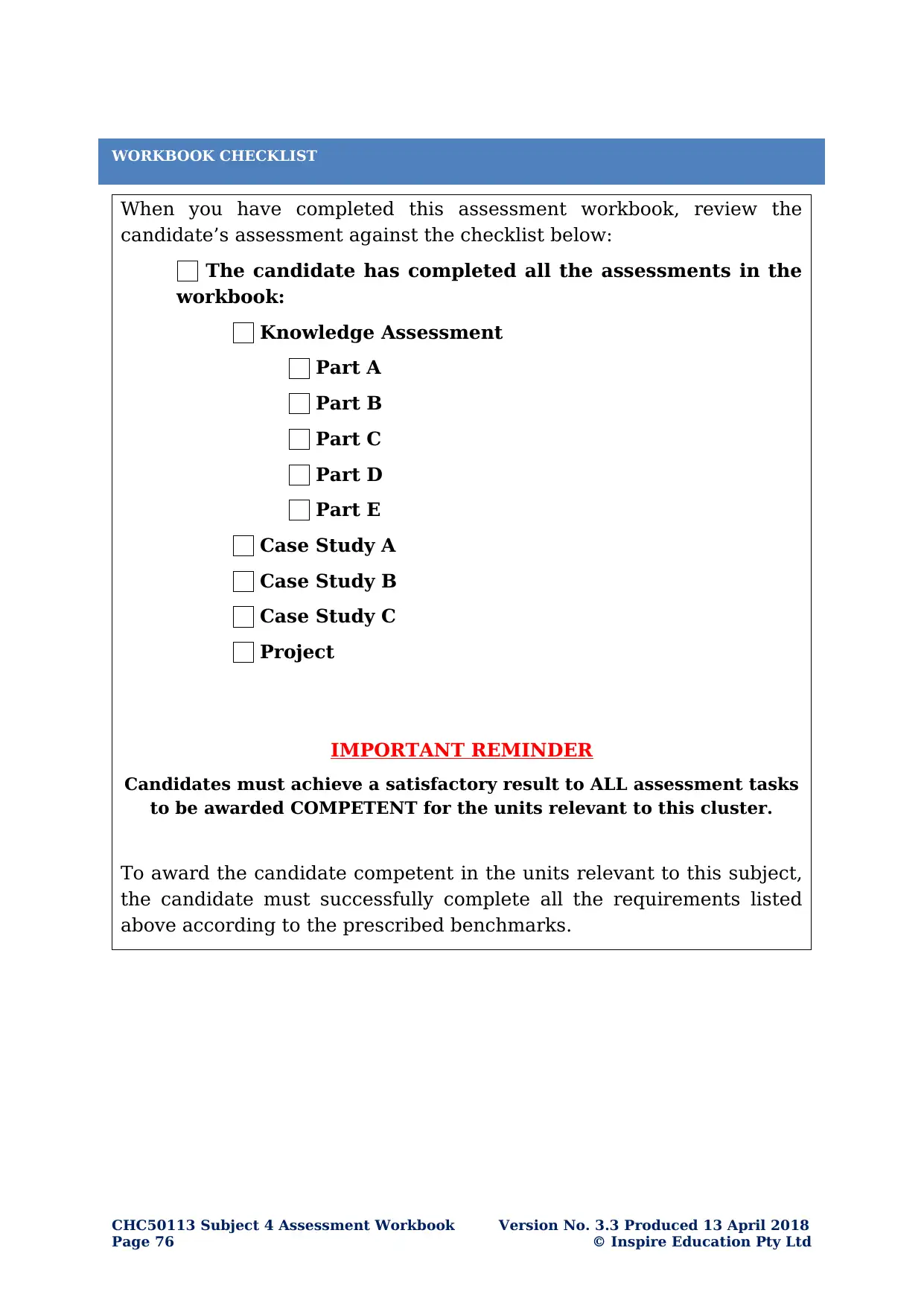
WORKBOOK CHECKLIST
When you have completed this assessment workbook, review the
candidate’s assessment against the checklist below:
The candidate has completed all the assessments in the
workbook:
Knowledge Assessment
Part A
Part B
Part C
Part D
Part E
Case Study A
Case Study B
Case Study C
Project
IMPORTANT REMINDER
Candidates must achieve a satisfactory result to ALL assessment tasks
to be awarded COMPETENT for the units relevant to this cluster.
To award the candidate competent in the units relevant to this subject,
the candidate must successfully complete all the requirements listed
above according to the prescribed benchmarks.
CHC50113 Subject 4 Assessment Workbook Version No. 3.3 Produced 13 April 2018
Page 76 © Inspire Education Pty Ltd
When you have completed this assessment workbook, review the
candidate’s assessment against the checklist below:
The candidate has completed all the assessments in the
workbook:
Knowledge Assessment
Part A
Part B
Part C
Part D
Part E
Case Study A
Case Study B
Case Study C
Project
IMPORTANT REMINDER
Candidates must achieve a satisfactory result to ALL assessment tasks
to be awarded COMPETENT for the units relevant to this cluster.
To award the candidate competent in the units relevant to this subject,
the candidate must successfully complete all the requirements listed
above according to the prescribed benchmarks.
CHC50113 Subject 4 Assessment Workbook Version No. 3.3 Produced 13 April 2018
Page 76 © Inspire Education Pty Ltd
Secure Best Marks with AI Grader
Need help grading? Try our AI Grader for instant feedback on your assignments.
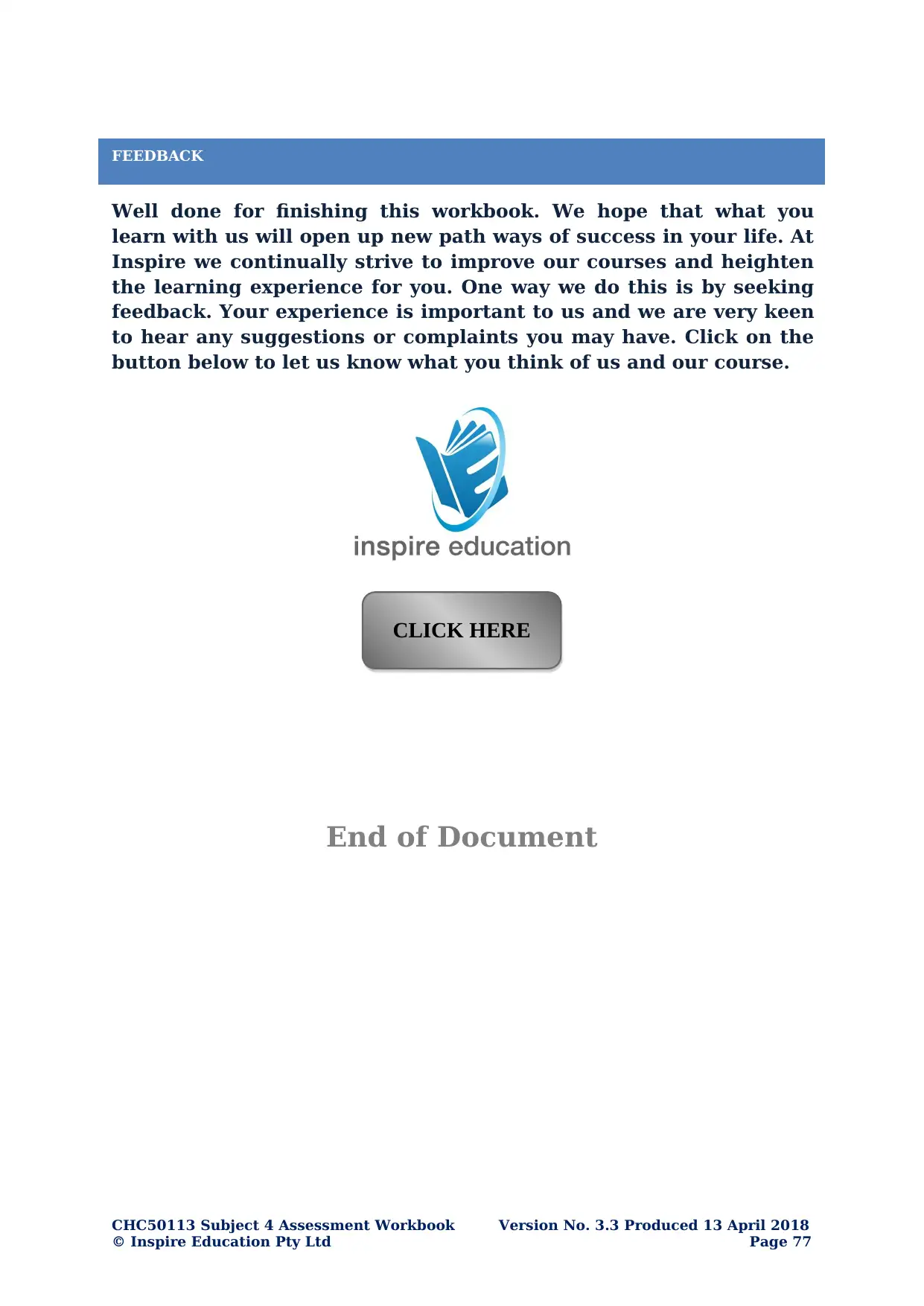
FEEDBACK
Well done for finishing this workbook. We hope that what you
learn with us will open up new path ways of success in your life. At
Inspire we continually strive to improve our courses and heighten
the learning experience for you. One way we do this is by seeking
feedback. Your experience is important to us and we are very keen
to hear any suggestions or complaints you may have. Click on the
button below to let us know what you think of us and our course.
End of Document
CHC50113 Subject 4 Assessment Workbook Version No. 3.3 Produced 13 April 2018
© Inspire Education Pty Ltd Page 77
CLICK HERE
Well done for finishing this workbook. We hope that what you
learn with us will open up new path ways of success in your life. At
Inspire we continually strive to improve our courses and heighten
the learning experience for you. One way we do this is by seeking
feedback. Your experience is important to us and we are very keen
to hear any suggestions or complaints you may have. Click on the
button below to let us know what you think of us and our course.
End of Document
CHC50113 Subject 4 Assessment Workbook Version No. 3.3 Produced 13 April 2018
© Inspire Education Pty Ltd Page 77
CLICK HERE
1 out of 77
Related Documents
Your All-in-One AI-Powered Toolkit for Academic Success.
+13062052269
info@desklib.com
Available 24*7 on WhatsApp / Email
![[object Object]](/_next/static/media/star-bottom.7253800d.svg)
Unlock your academic potential
© 2024 | Zucol Services PVT LTD | All rights reserved.





